
- Visa Application Helpline

Subscribe to our newsletter
Learn how to live a sustainable long-term travel lifestyle.
By signing up, you agree to the our terms and our Privacy Policy agreement.
Top 27 Places to visit in Darjeeling, Explore the Beautiful Hills of Darjeeling
Top 10 things to do when traveling to shimla: shimla travel guide, the ultimate paris travel guidelines for first timers | top attractions & things to do.

The Best 1 to 3 days Manila Itinerary & Budget Guide for First-Time Visitors
Manila had a history of Spanish colonization in 1751, and the capital city of the Philippines has Spanish influence in their culture amalgamated. The city is the educational and administrative centre of the country.
Manila is also referred to as the “pearl of The Orient”, and the city has a lot to offer as a tourist destination. You can get submerged in the city’s history and culture by visiting the museums, parks, memorials, and theatres and enjoy by visiting some of the biggest shopping malls in Asia, exploring restaurants and traditional Philippine cuisine.
Discover the best of Manila without breaking the bank! This Manila itinerary and budget guide provides everything you need to know for a memorable trip.
WHAT IS COVERED IN THIS ARTICLE?
How to Travel to Manila?
Manila is the cultural and economic centre of The Philippines. Air, rail, and other transportations are available for travelling to Manila. There are direct flights to the Aus, Canada, UK, USA, and many other countries, or you can fly via Hong Kong or Kuala Lumpur.
The city is also connected to by rail with the major cities and towns of the Philippines. The main highroads of Metro Manila are the highways NLX and SLEX. The city is connected from North to South with EDSA.
Airport: Manila has one international airport that is Ninoy Aquino International Airport (NAIA), with three international terminals and one domestic terminal. The airport is connected with most Southeast Asian cities and other popular airports around the world.
Bus Services: Bus Services around Manila City is available, and the services are convenient. You can take the P2P bus services from the NAIA terminal. There are a total of 31 bus routes in Manila connecting east to west and north and south of the city. Most bus services in Metro Manila are available for 24 hours.
Grab Services: Grab is a ride-sharing taxi booking service in Manila. Use the Grab app to transport around the city if you are not comfortable moving around in public transport. Beside Manila other major cities that offers Grab services are in Cebu City, Davao City, Iloilo City, Bacolod City, and Baguio City.
Best Time to Visit Manila
The best time to visit Manila is generally in Winter, the dry season. Manila is best to visit in between November to February. And, if you want great Spring weather, you must visit between January and April. The temperature remains around 22 degrees to 27 degrees.
But for people who love Winter, December to February are also a great option, but there tends to be slightly high humidity in December. The dry season allows tourists to have a great visit, and rainfall is rare at this time.
Where to Stay in Manila?
Manila has great accommodation in many areas of the city, but where you should stay totally depends on the purpose and your itinerary.
Makati: For first-time tourists, Makati is a great place to stay for first-time visitors as it gives easy access to stay tourist sights, nightlife, shopping areas and restaurants. You can find great luxury hotels like City Garden Grand Hotel and New World Makati with exceptional city views and great hospitality services.
Malate & Ermita : If you are a foodie and trying to find an area with authentic Filipino cuisine but that’s also close to the attractions, Malate and Ermita is the perfect area. The main landmarks are quite close from this area, and the area is the beaming part of great restaurants. Some of the budget-friendly options in this area are the luxury Rizal Park Hotel, Jen Manila Hotel, and Bay Area Suits.
Quezon City: This is the most populous part of Manila City and is located northeast of the Bay area. This area has the best showcase of interest of the young population of the city, being the educational centre of the city. Quezon City is around 25 minutes by road from Makati, and it has the best street foods and cafes to offer. Novotel Marina Arantina and Seda Vertis North are worthy options.
Manila Itinerary for Top Tourist Attraction-1 Day Itinerary
The city of Manila can be covered in 1-day, and tourists can discover the Spanish influence, culture, and architectural buildings of this city. The 1-day Manila itinerary is going to be busy, enjoyable, and full of pleasant surprises for first-time visitors. Manila’s top itinerary places are Fort Santiago, St. Augatine church, Rizal Park, National Museum, and more. This
Manila Itinerary will cover all of the best places to visit.
Start your day by taking an Intramuros walk tour. Stop by Fort Santiago and the Museum of Jose Rizal to take in the essence of the history of the place. Then use the time before lunch for Rizal Museum, cathedrals in the city.
If you are down in Manila, you must experience one of the city’s unique rides, Jeepeny, after lunch and go down to Chinatown for shopping, eating and enjoying the experience. You can wrap your tour there and head to the station in the evening or stay here late to enjoy the sunset and club at night.
1. The Walled City of Intramuros:
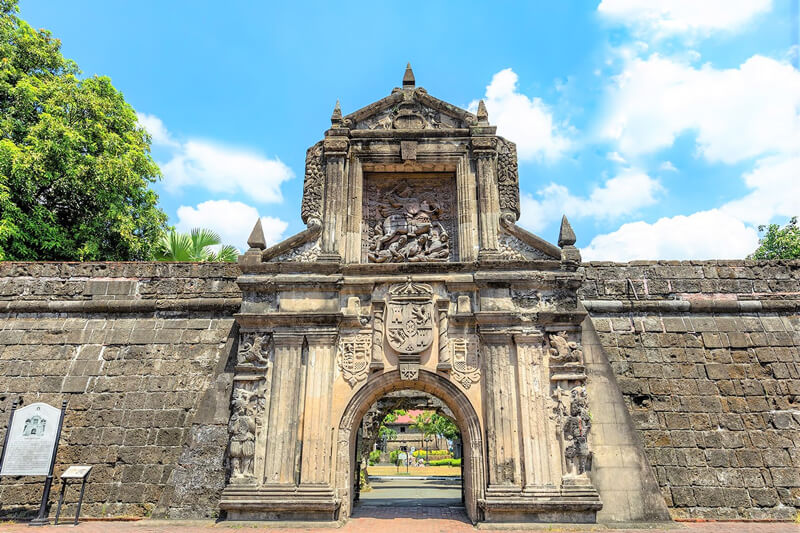
The walled city of Intramuros is one of the first things that you should visit. The fort was built for defence against enemies, and the Spanish began building the walls in 1921. The walls stand as a sign of the past history of invasion and natural disasters. The walls were built as Spaniard’s military and political base in Asia.
Also, visit Fort Santiago, the very fort where national hero Jose Rizal was imprisoned. Fort Santiago is situated just by Intrausous, just a few meters away from Manila Cathedral. This is one of the historical fortresses. Spanish governor Miguel López de Legazpi built it in the newly established city of Manila.
2. Cathedral of Manila & St. Cathedral Church:

St. Cathedral Church is inspired by the Baptist Church, and it was established in 1571 as a Parish Church by Juan de Vivro under the Archdiocese of Mexico. In 1581, it was chosen to be the cathedral as the Phillipines were separated from the Archdiocese of Mexico. The present structure of the Manila Cathedral has 8 chapels. One of them is the most important chapel being, the Chapel-Shrine of the Holy Souls in Purgatory.
3. Chinatown:
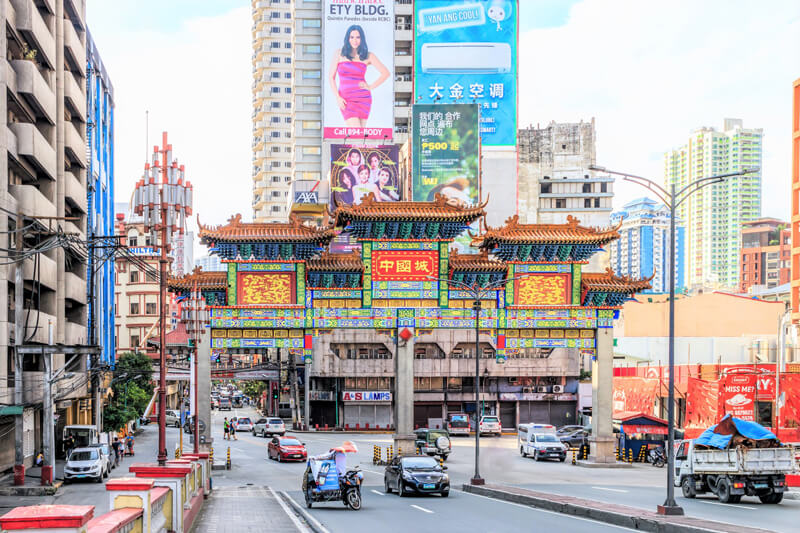
Manila’ Chinatown , also known as Binondo, is the oldest Chinatown in the whole world. The Chinatown in this city was also established by the Spanish in the 1590s. This area was mostly inhabited by the catholic Chinese. One of the most popular streets in Chinatown is Carvajal Street. You will find cool wall art and graffitis there.
And you will see fresh fruit vendors, herbal shops, and Chinese medicine shops as well. You should obviously try the Chinatown’s amazing street foods and eateries, including Tea Brothers, Sincerity Chinatown, Dong Bei Dumplings, and New Po Heng Lumpia House.
You should try the purple ube tea, Lan Jhou La mien, wai ying, dong bei dumpling, and more in this street.
Manila 3-Day Itinerary
Three days is a reasonable amount of time for visiting all the worthy places in Manila. The Manila 3-day itinerary gives you enough time to explore more places including Rizal Park, the museums, and to explore the city.
With the Manila 3-day itinerary. Here are some more exciting places to explore if you are living in Manila other than Intramous Wall, Fort Santiago and Chinatown. Cover the itinerary of day 1, and on day 2 and day 3, cover these below-mentioned places.
Manila Day-2 Itinerary:
1. rizal park.

Rizal Park is located in ermita, manila. It’s a historical park spread over 58 acres area and has over 500 species of trees. The city park is located on the east shore of Manila Bay. You can learn about the national hero Jose Rizal and have a great time looking at the beautiful landscape.
The park was created in 1820 and is the main attraction of Rizal Park, and the monument was built during American colonization in 1901. The Rizal, Prior to World War II, was the location for carnivals and exhibitions.
2. Baluarte De San Diego:
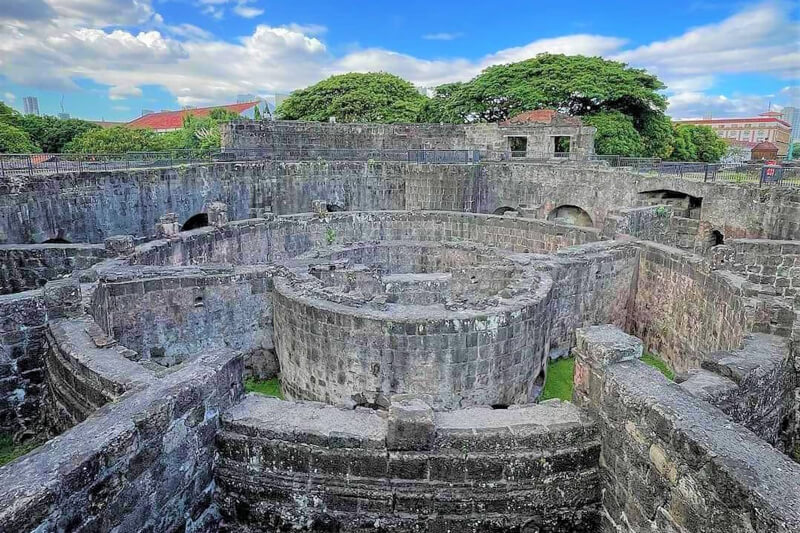
It’s one of the greatest architectural wonders of the city, located just nearby Intramuros City. The bulwark is shaped like a spade, and you can enjoy walking through this.
The fort was created from the remains of the upper part of a circular watchtower. The watchtower fell during an earthquake in 1863. The fort is currently looked after, and there is a garden around it as well. The Baluarte is a must-visit during your trip to the historic city.
3. SM Mall of Philippines:
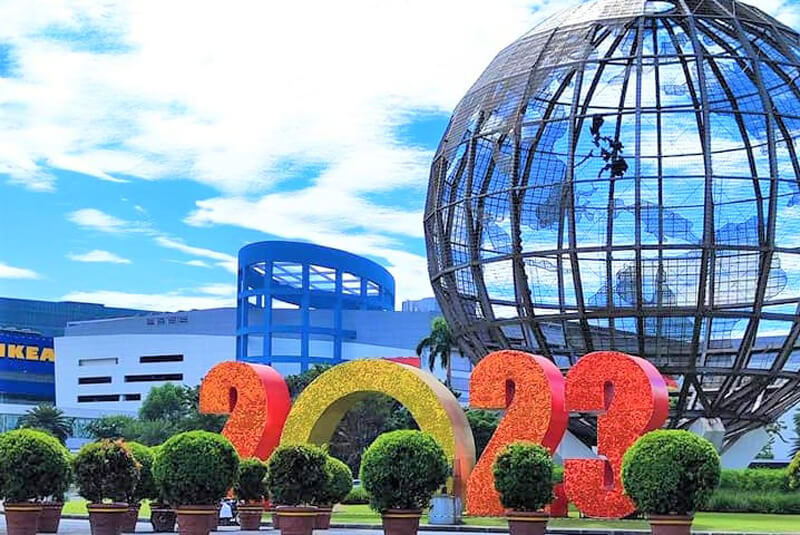
The mall is the third largest mall in Asia. SM Mall in Asia is the largest MoA in the Philippines . It is located in Bay City, Pasay, and more. The SM mall is a fun place to explore and do fun things. SM Mall was built by SM Prime Holdings and is spread over 68 acres.
SM MoA went through renovation from 2011 to 2015, expanding its area and becoming the third largest SM MoA. You can enjoy and explore the food hall, game park, events held in the open-air theatre, and the only Olympic-sized ice-skating rink in the Philippines.
4. Manila Ocean Park:
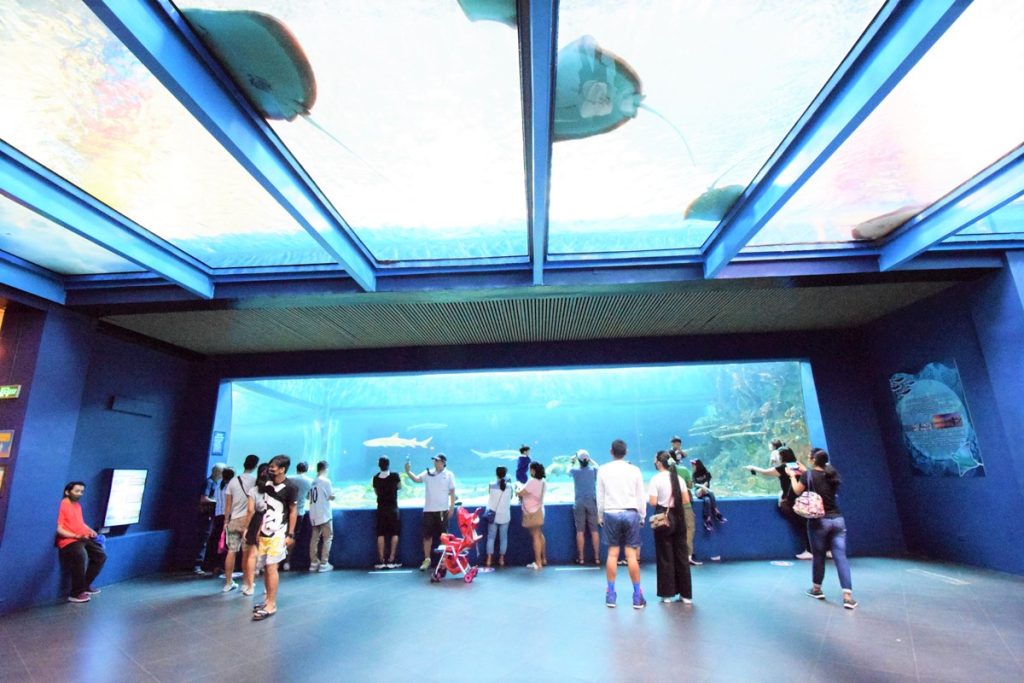
Philippines’ first premium-quality oceanarium that displays marine animals and has an excellent education facility for oceanography. The oceanarium contains 14,000 animals from 277 species. The main feature is the 220-degree curved 25-metre walkway tunnel. If you have some time, head over to this oceanarium, and you will be amazed.
Manila Day-3 Itinerary:
1. national museum of philippines: .
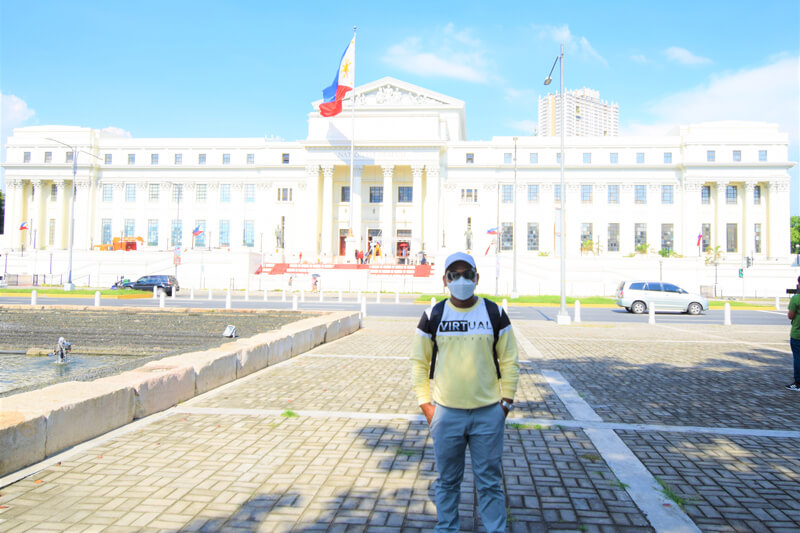
The National Museum of the Philippines in Manila is an educational and cultural institution for natural history and science. The history of this establishment goes back to 1891, and the history of Museo-Biblioteca de Filipinas was established by the Spanish government.
In 1904, the name was changed to Philippine Museum in the Louisiana Purchase Centennial Exposition at St. Louis. The museum has displays of botanical species, an archaeology exhibition, geological and paleontological displays and more.
2. Malate Church:

The Malate Church is a Mexican baroque-style church that is located in Malate. It’s a Parish church located by Manila Bay, and it’s also known as Our Lady of Remedies Parish. It was accepted as an Augustinian Church in 1590, and it is one of the oldest Church outside the Intramuros.
The Malate Church is dedicated to Nuestra Señora de los Remedios, the patroness of childbirth. The architecture of the Church is a good blending of the Muslim and Baroque styles. It has a prominent square structure enhanced by the cylindrical buttresses and detailings of the design. The Church is open from 7:00 AM to 6:00 PM.
3. Manuel Quezon Memorial & Museum:
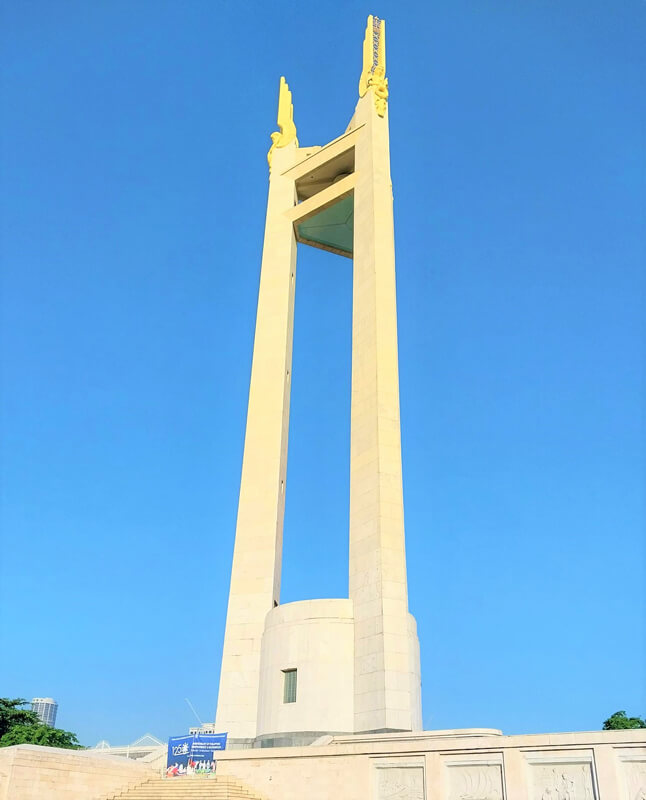
Quezon Memorial Shrine of Memorial and collection of things related to the previous President of the Philippines, Manuel Quezon. The Memorial has a monument dedicated to Mr President and has a museum at its base. Manuel Quezon.
Architect Federico Ilustre built the Quezon Memorial Shrine, composing three connected towers, and there is also an observation deck at the top. The museum, located at its base, houses the interred remains of Mr. Quezon and his wife, Mrs. Arora Quezon. You can also see a replica of the President’s office.
4. National Museum of Natural History:
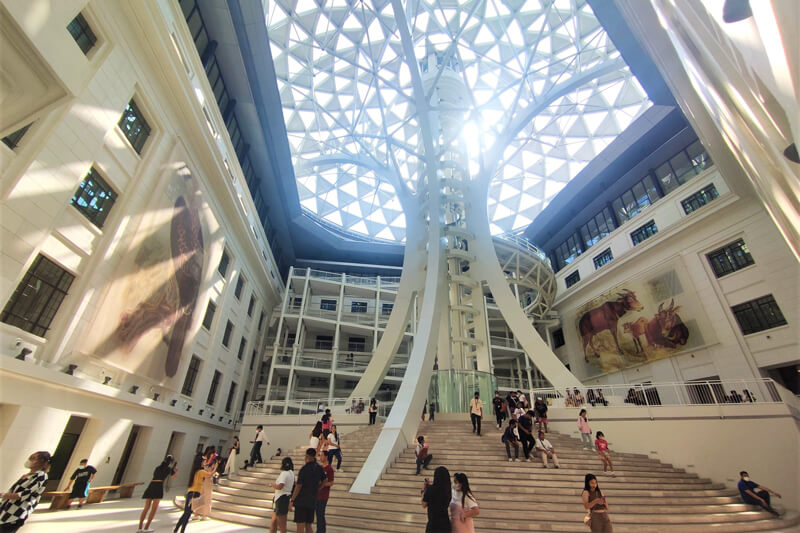
National Museum of Natural History exhibits the biological and geological diversity of the Philippines and has a total of 12 galleries. The National Museum of Natural History The museum is located near Rizal Park and along Agrifina Park.
The museum was built in the late 1930s, but the building was destroyed in World WarII. After that, it was reconstructed in its original place after the war. The National Museum of History building belongs to the Department of Tourism.
Enjoy the tour by visiting all of the collections and if you are a flora. Fauna and archaeology enthusiasts, this spot is definitely for you.
5. Ayala Museum:
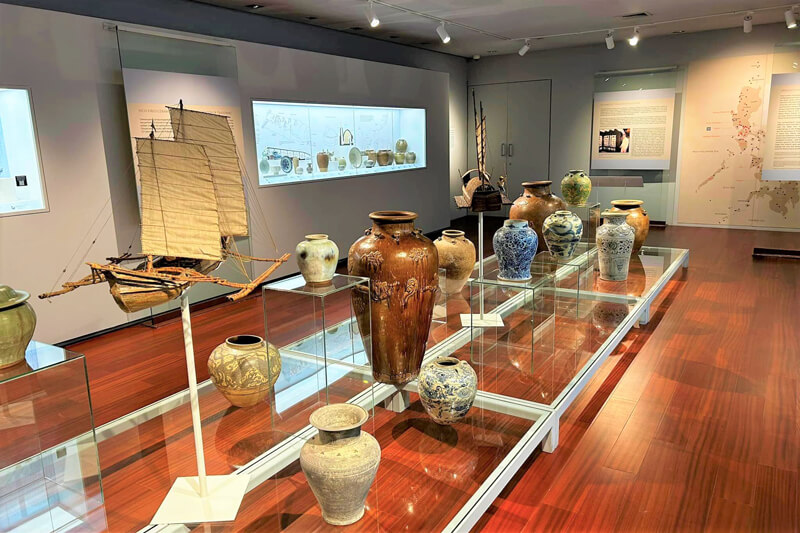
The Ayala Museum is one of the most unique museums in Manila. It was founded by the private group Ayala and is located in Greenbelt Park, Makati. The museum displays gold artefacts and also geological, archaeological, and ethnographic exhibits. While visiting the museum, don’t forget to see The Digital Gallery, Microcosm, and Diorama Experience, exhibiting some of the handcraft from the core exhibitions of Ayala, artefacts, and more.
6. Greenbelt Chapel:
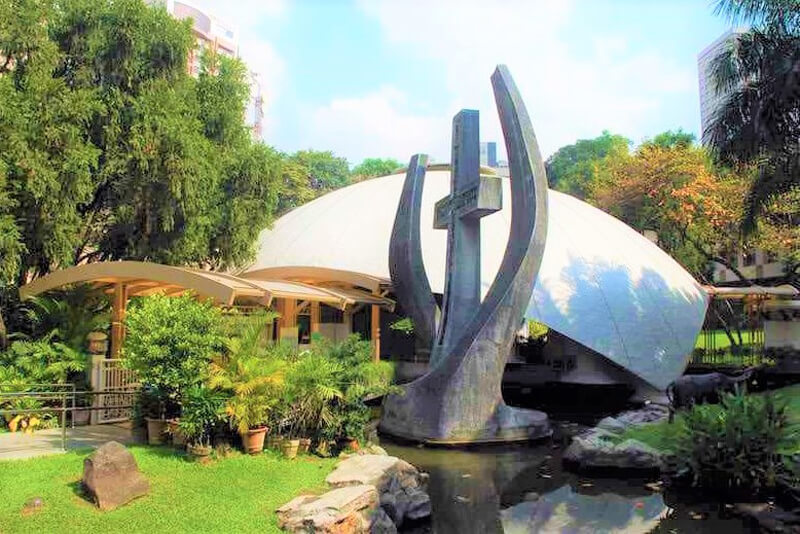
The Greenbelt Chapel is located inside the Ayala Centre, and it is the spiritual centre for the Sto. Niño de Paz Catholic community. It is located among the lush green tree-filled park of Greenbelt. The chapel is dome-shaped, with an altar in the middle. It was inaugurated in 1983, and it was handled by the selsians of Don Bosco back then, but in 2012, the Roman Catholic Archdiocese of Manila took over the affairs and service of the chapel.
7. Bonifacio High Street:

Bonfacio High Street is the 1-km long boulevard point that is Philippine’s first shopping street. It’s a great attraction for shopping complexes and dining restaurants. Bonifacio High Street is the perfect spot for fashion enthusiasts as well as those who are trying to buy any souvenirs from the trip. The entertainment options range from fashion, beauty shops, movie theatres, eateries and more.
Nightlife in Manila
If you are living 3 days in Manila, you can set aside the second night to go out for partying, dining and other fun activities to explore the nightlife of Manila. There are a lot of live music bars with artists playing jazz, rock and Filipino music, like the Craft Rock & Grill and Tago Jazz Cafe.
Another thing to explore is the Karaoke bars in Manila. You can find small cool Karako bars, which are great for going out with friends. And, if you want to go to clubbing and hop clubs all night long, some of the recommendations are House Manila, Club ZZYZX Manila, and Black Market.
Explore Eateries in Manila During Your Stay
There are some signature dishes of the city of Manila that you can not miss. Some are street foods, and some are restaurant foods. In Manila, you must try the Kwek Kwek, Isaw, Banana cue, and adobo. Here are some best restaurants and eateries to visit in Manila
Cafe Ilang-Ilang: Cafe Ilang-Ilang is the epicentre of trending dining in Manila. Cafe Ilang Ilang’s international buffet menu is one of the best foods Manila has to offer. Cafe Ilang-Ilang has a multicuisine buffet which has charcuterie boards, freshly baked bread, pasta, salad bars, noodle bowls, karekare, adobo, lumpia, pancit, and desserts.
Toyo Eatery: Toyo Eatery is an international Filipino-cuisine restaurant. Toyo Eatery in Manila is located in Metro Manila in Karrivin Plaza. Toto Eatery is known for their contemporary take on classic Filipino foods like lugow and stuffed squids, and the most famous dish of this restaurant is the dish inspired by Bahay Kubo. It’s definitely is an experience to reveal all the Filipino flavours in a new way.
The Aristocrat : The Aristocrat is a good restaurant for staple food during your stay on a low budget. The Aristocrat is a classic Filipino resto at the Ermita in Metro Manila. The two most delicious and decadent recipes of this eatery is the chicken BBQ and Torta Delos Reyes.
Barbara’s Heritage Restaurant: It’s one of the oldest Manila restaurants. Barbara’s Heritage restaurant serves authentic Filipino food and has a rustic, homey atmosphere for a traditional Filipino vibe. Barbara’s heritage’s some of t most famous foods from the menu are paella de mariscos, halo-halo, tortang tagalong and more. The restaurant is located outside Intramuros city.
Grace Park: Grace Park is a restaurant in Makati City, which is a high-class multi-cuisine fine dining restaurant that is cosy and comfortable for a date night dinner. Grace Park’s menu is served with different signature Filipino dishes and Italian dishes. The food there is created using organic items fresh from the farm.
And, along with fine dining and trying cafe foods, you can’t really ignore the street foods and foods from small eateries. While exploring Chinatown and other parts of the city, if you find a stall or eatery selling some of the famous street foods of Manila, you must try it. Here is the ultimate list of foods to try certainly.
● Green Mango with Shrimp Paste
● Kwek Kwek ( Battered and Deep Fried Quail Egg)
● Taho ( Soft Tofu in Brown Sugar Syrup)
● Isaw ( Barbecue chicken or pig intestine)
● Lumpia Banana
● Puto ( Steamed Rice Cakes)
● Sisig ( Minced and Seasoned Pig’s Liver and Meat)
● Halo Halo ( Mixture of flan, fruit jelly, and ice cream on shaved ice)
Estimated Manila Tour Budget
Depending on the preferences, style of travel, mode of transportation and planned activities, the budget for the Manila tour may vary. Here is a rough estimated budget for all of the costs that will impact your travel budget. The total budget would come to around RM 500 to RM 800 per person.
Accommodation: Manila has different types of accommodations, starting from just RM50 to RM80 per night. And,for the luxury hotels, the budget can go upto RM300 per night for booking. Depending on the area of the city the accommodation cost will vary.
Transportation: Basic transport costs for buses around the city are RM5 to RM15, and cabs or taxis are available for RM 15 to RM 30.
Activities: Many tourist spots around Manila have free entrance. And, the entrance fee for the museums and historical parks are quite low as well. The tickets are generally RM 5 to RM20 per person.
Food: There are loads of low-budget food options along with fine dining budgets. The food from eateries will cost you around RM 20 to RM100 per meal per person.
Manila is the hub of academics, culture, and economy in the Philippines. It’s one of the cities you must visit when you travel to the Philippines. Manila is enriched with rich history and culture, historic landmarks, diverse food options and vibrant nightlife. It is a cheap travel destination with exciting tourist spots.
Related Posts
Top 30 places to visit in baguio, philippines: explore the amazing city, top 27 places to visit and things to do in manila, philippines, experience the best of the tagaytay day tour, the top 10 malaysian restaurants in manila for an appetizing menu.
Save my name, email, and website in this browser for the next time I comment.
This site uses Akismet to reduce spam. Learn how your comment data is processed .
Type above and press Enter to search. Press Esc to cancel.
- Meet the Team
- Work with Us
- Czech Republic
- Netherlands
- Switzerland
- Scandinavia
- Philippines
- South Korea
- New Zealand
- South Africa
- Budget Travel
- Work & Travel
- The Broke Backpacker Manifesto
- Travel Resources
- How to Travel on $10/day
Home » Southeast Asia » Philippines » Manila
EPIC MANILA Itinerary! (2024)
Vibrant Manila is a tantalizing destination! It’s a great mix of sophistication and chaos that will blow your mind! With fun activities, amazing landmarks and plenty of insider tips, our Manila itinerary will make sure that you have a holiday to remember!
Whether you’re shopping up a storm at the bargain hunter’s paradise of Divisoria Market or marveling at antique art in the National Museum of Fine Arts, there are so many awesome things to do in Manila, Philippines!
As the capital and financial center of the Philippines, Manila boasts many modern facilities to ensure you have a comfortable trip. However, it also has plenty of history and cultural attractions to make sure that you have fun on our Manila itinerary!

Unlock Our GREATEST Travel Secrets!
Sign up for our newsletter and get the best travel tips delivered right to your inbox.
Best Time to Visit Manila
Where to stay in manila, manila itinerary, day 1 itinerary in manila, day 2 itinerary in manila, day 3 and beyond, staying safe in manila, day trips from manila, faq on manila itinerary.
Knowing when to visit Manila is one of the most crucial aspects of your trip! That said, Manila enjoys a fairly consistent climate, so there are very few bad times to visit the city!
Peak season falls during spring, from March to May. On the plus side, many Manila attractions are open for visitors and the weather is warm but not too humid. However, you will have to share Manila with your fellow tourists and pay a steeper price!
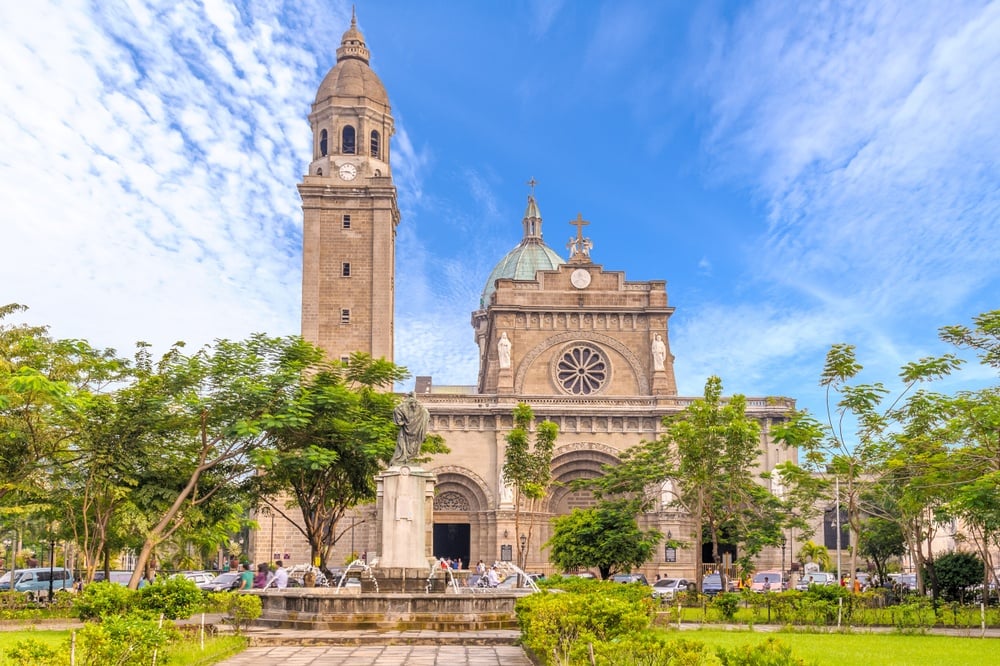
The Broke Backpacker is supported by you . Clicking through our links may earn us a small affiliate commission, and that's what allows us to keep producing free content 🙂 Learn more .
The off-peak season is from June to August. Although this is summer, you can expect the most rainfall during this period, as well as humidity.
The best time to travel to Manila is during one of the shoulder seasons. November is a good month to visit since the rain slows down and the city is still uncrowded. There are more crowds in May but the weather is warm and you can still enjoy a wide range of attractions!
With a population of around 1.7 million people, Manila is a massive city, so choosing where to stay can be overwhelming! There are 16 districts that all have unique characters, but you’ll probably only need to visit three or four of them.
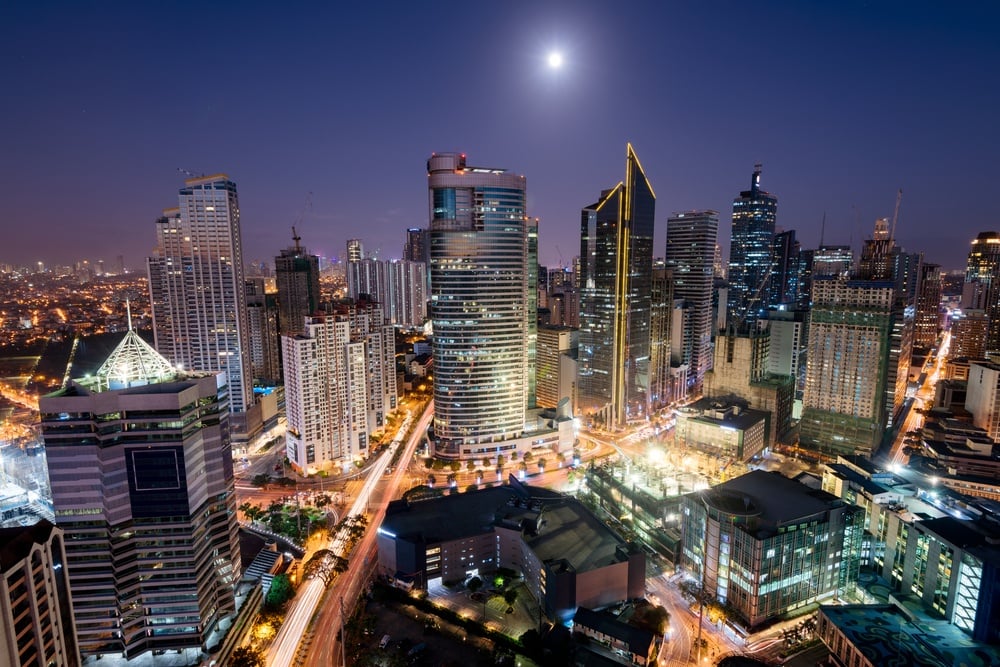
The best place to stay in Manila in 3 days is Makati. This is a beautiful, clean and safe district in the center of the city. It’s the city’s business district, but it’s also home to plenty of famous Manila points of interest, such as the Ayala Museum. There are also some gorgeous green spaces like Washington SyCip Park. It caters to visitors of all tastes!
Quezon City is another popular area to consider staying in due to its creativity and energy. It’s located outside of the city center and has a vibrant, trendy atmosphere to enjoy! This is the best place to stay in Manila in 3 days if you’re looking to experience the contemporary local culture. Foodies will also love this area, due to the host of fashionable cafes, busy bars, and various restaurants!
Best Hostel in Manila – Manila-Z-Hostel
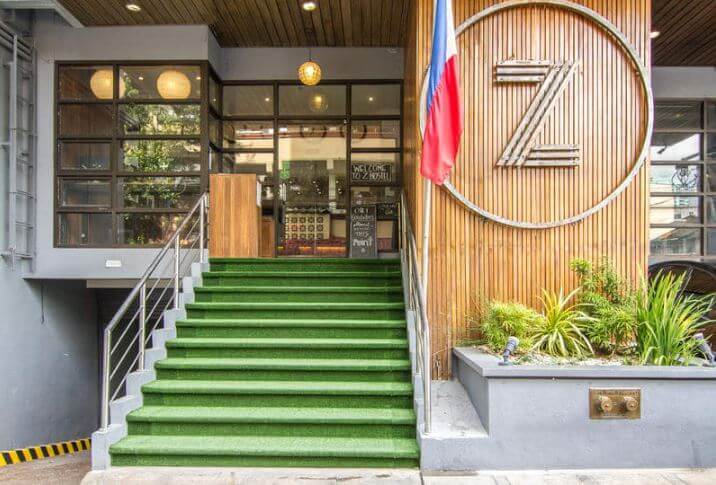
This hostel has the perfect location in the central district of Makati! It’s consistently praised for its cleanliness and friendly staff. The hostel also has a very vibrant atmosphere, with plenty of social events taking place on its iconic rooftop bar. You’re guaranteed to have a good time here!
If you prefer to stay in hostels, check out our guide to the BEST hostels in Manila.
Best Budget Hotel in Manila – OYO 179 Aguados Place
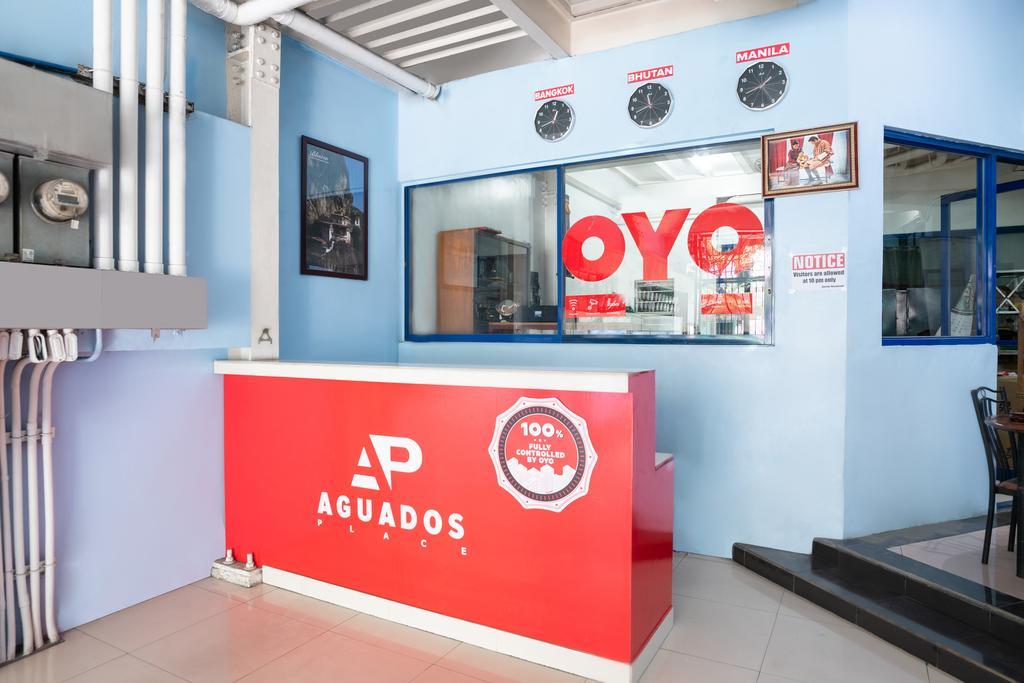
Offering free Wifi, impeccable rooms, and helpful staff, OYO 179 Aguados Place is the ideal accommodation for budget travelers! It has a central location and a nearby metro station, making it easy to get around Manila.
For more budget accommodtion, consider staying at these cool Manila AirBnB’s.
Best Luxury Hotel in Manila – The Manila Hotel
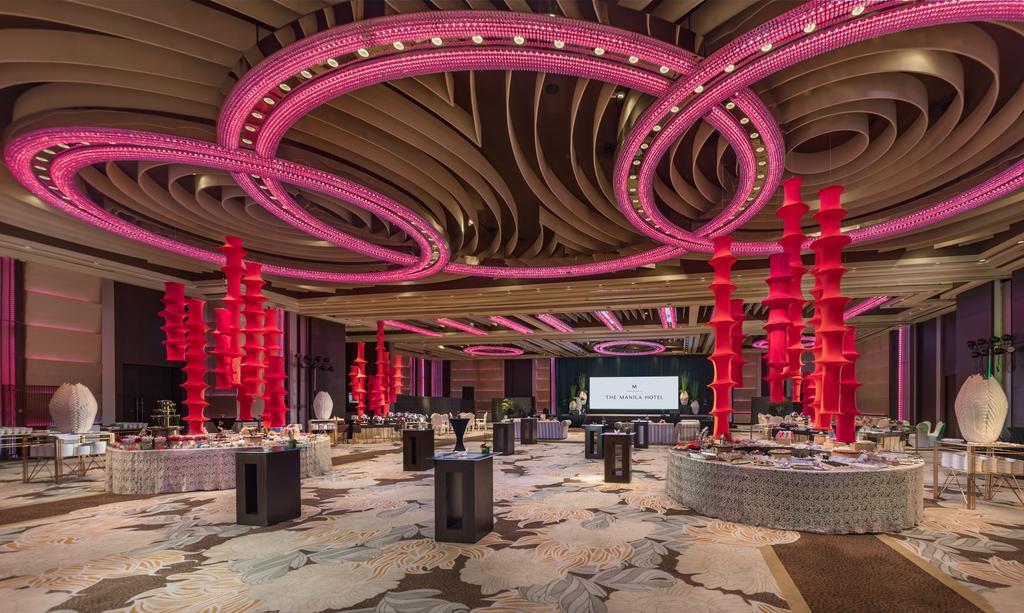
The amazing five-star hotel is in a quiet part of the city center, just 3,000 feet from the Manila Cathedral. The rooms and suites are opulently decorated with marble bathrooms and embossed textiles. You can also experience top-quality gourmet dishes and poolside cocktails at the Manila Hotel!
Knowing what to do in Manila is key to having a good time in the city! Luckily, you can make use of our awesome Manila itinerary to discover the city’s key sites and best activities! All over the city, you’ll find that things to see in Manila are often close together. However, you will need transport to reach these areas!
Manila has two railway systems, the Metro Rail Transit (MRT) and the Light Rail Transit (LRT). They’re a great way of beating the traffic but they don’t cover the entire city and overcrowding often leads to pickpocketing.
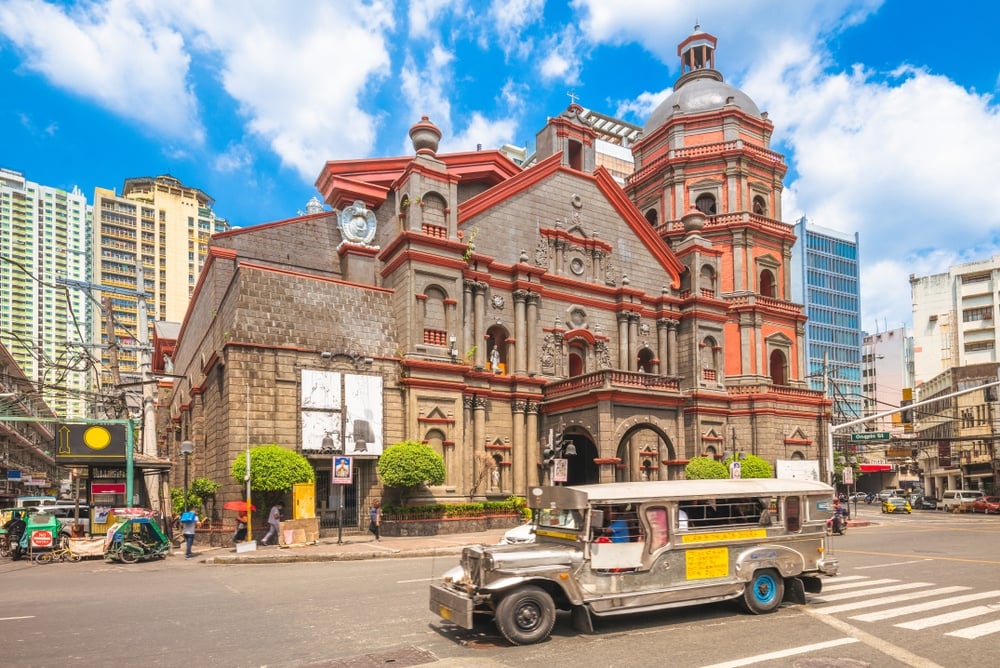
A quick way of getting around during your Manila itinerary is to use motorized tricycles. These are quite cheap, so long as you negotiate! There are also a number of eco-friendly electric tricycles.
The cheapest way of getting around Manila is to use buses and jeepneys (colorful buses with some features of a Jeep). These cover the entire city but are also difficult for first-timers to navigate. In the city center, however, if you use only the common routes you should be fine!
Of course, Manila also has a thriving taxi cab industry. It’s important to negotiate and try to pay in exact change but the public buses will be easier on you pockets if you’re backpacking the Philippines. You can also use the GrabTaxi app to hail a taxi but that costs more.
Ayala Museum | Greenbelt | Intramuros | Fort Santiago | The Rizal Shrine | San Agustin Church and Museum | Manila Cathedral
Today’s Manila itinerary is all about orienting yourself with the city center and admiring some of the city’s most gorgeous landmarks! It’s amazing how much you can see in just one day in Manila!
Day 1/ Stop 1 – Ayala Museum
- Why it’s awesome: This museum will show you the best of Philippine history and art!
- Cost: Free!
- Food nearby: Find your early morning fix at Cafe Breton which is just a few minutes’ walk from the museum. You can look forward to typical French cafe fare!
The Ayala Museum was founded by one of the Philippines’ leading families who also developed Makati into the vibrant area it is today! This museum is now one of the best Manila attractions to explore!
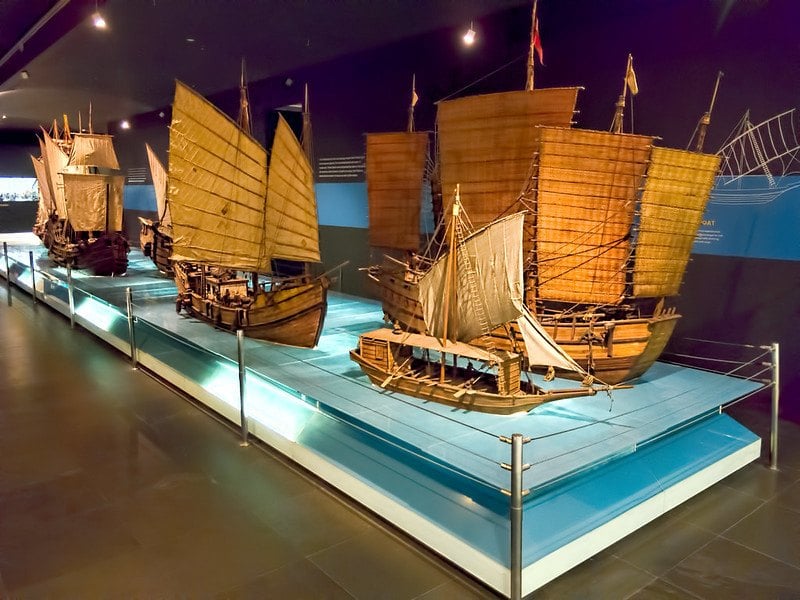
The six-story building is currently undergoing renovation (until 2020) but it’s still worth stopping by to admire the modern architecture. The museum’s exhibits are being displayed in schools and shopping centers, so take a look at the museum website to find out if there’s an exhibit planned during your vacation in Manila!
The stellar collection in the museum is the pre-Hispanic gold items, closely followed by delicate Ming porcelain! These precious artifacts pay tribute to the vibrant trading culture of the indigenous people!
Day 1 / Stop 2 – Greenbelt
- Why it’s awesome: Greenbelt is a huge green lifestyle complex that’s perfect for relaxing!
- Food nearby: What better way to stroll around the park than with a gelato in hand? Get one of the delicious flavors from Gelatissimo which is right in the park!
Next up on your Manila itinerary is one of the city’s most famous green spaces which is known simply as Greenbelt . This massive park is a wonderful place to relax and refresh your body before carrying on with your Manila walking tour!
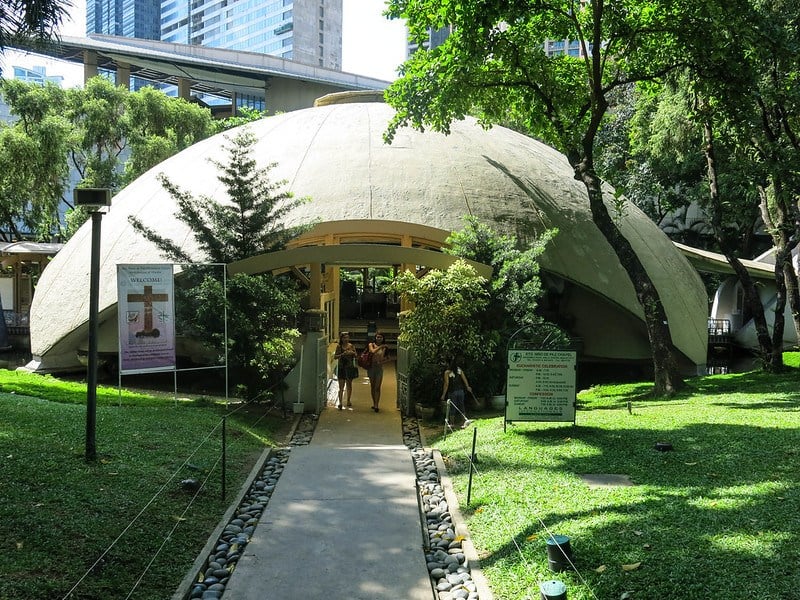
The shopping center was the original attraction of Greenbelt but it’s quickly been overshadowed by 3 hectares of verdant gardens! In the midst of all this greenery, you’ll find a number of cafes and bars, making this a very trendy area! The best thing to do is to take a stroll and then have a cold drink or ice cream!
Day 1 / Stop 3 – Intramuros
- Why it’s awesome: This charming area has many beautiful Manila landmarks from the Spanish colonial era!
- Food nearby: The cozy interior of Bistro Marinero is the perfect setting for a variety of lunch dishes, accompanied by an excellent wine list!
No itinerary for Manila would be complete without a couple of hours spent exploring the historic district of Intramuros! Intramuros literally means ‘inside the walls’ in Spanish, referencing the district’s cherished location inside the Spanish fortifications!
Since this was the city center during that period, there is history around every corner! Unfortunately, many of these Manila landmarks were destroyed by American troops during World War II. Thanks to restoration efforts, the surviving monuments have been restored!
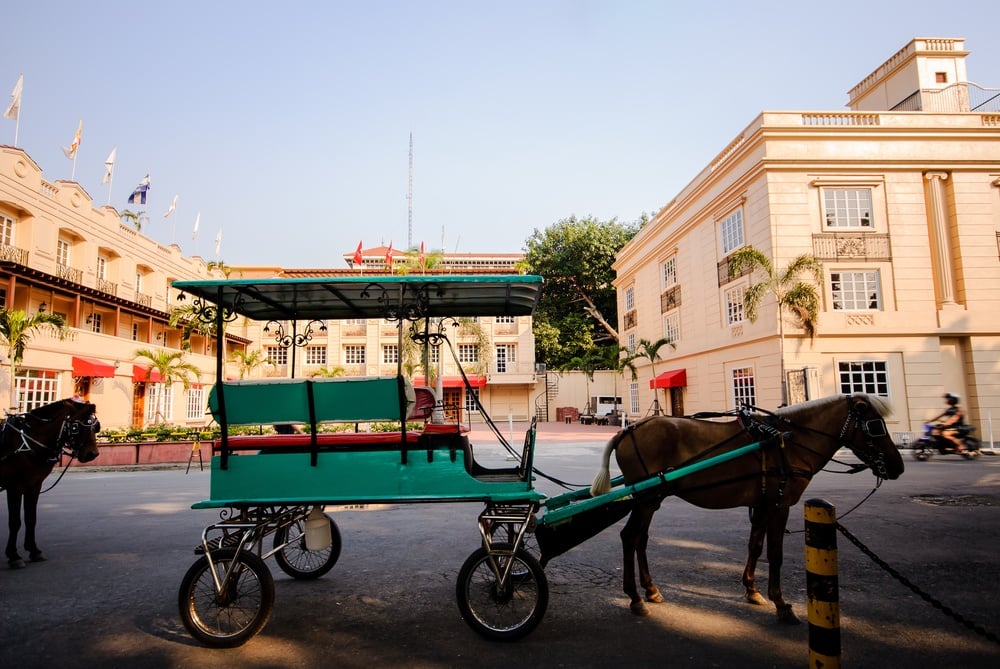
Of course, you’ll want to soak up the atmosphere of this neighborhood and experience some Manila things to do in the area! Visit the original Spanish walls, many parts of which are walkable. Also, wander around the Plaza de Roma and admire the statue of King Carlos IV!
Insider Tip: If you plan on bringing home souvenirs from your trip to Manila, Intramuros is the perfect place to shop! There are many trendy stores that have merged the best of Philippine tradition with modern design, resulting in unique items that your loved ones will truly appreciate! Manila Collectible Co. is a kind of one-stop-shop for souvenirs, selling local food ingredients and traditional handcrafts!
Day 1 / Stop 4 – Fort Santiago
- Why it’s awesome: This imposing fort has been around since the 16th century!
- Cost: Entrance is $2 USD.
- Food nearby: Patio de Conchita is the ideal place to grab an early afternoon snack! They serve ice creams and beers, as well as warm meals.
Fort Santiago was constructed in 1590 and spans an incredible 2,030 feet! Its history and sheer size mean its a Manila point of interest that you have to visit!
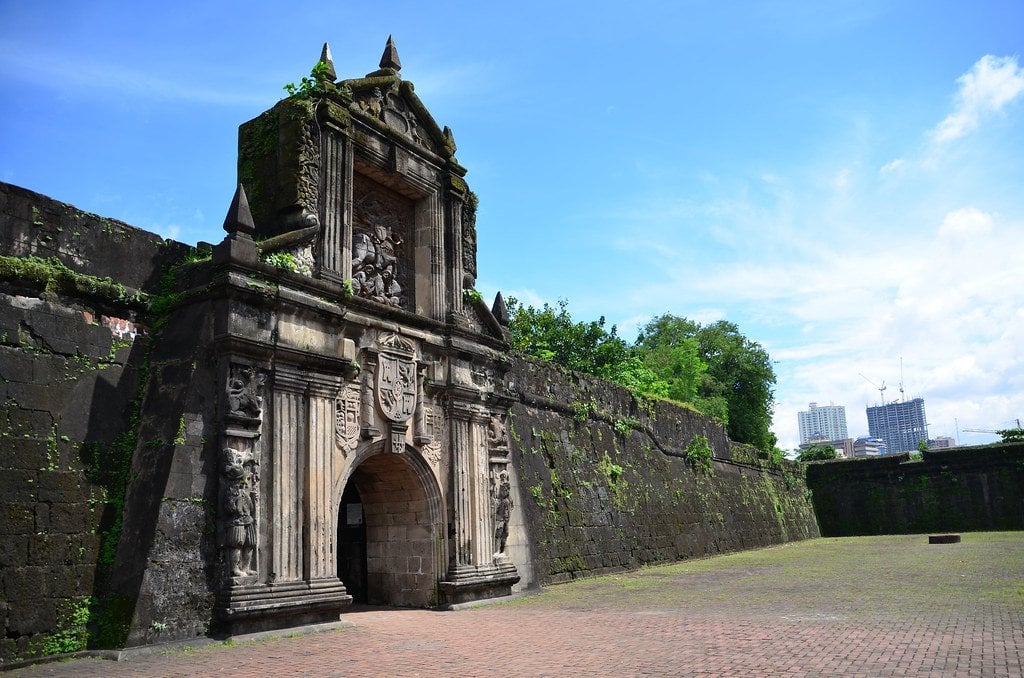
The fort is along the Pasig River and is surrounded by a moat. Visitors enter the fort through a fearsome gate which depicts St James, Spain’s patron saint, squashing Muslims under his horse. This image is appropriate for the site since Spain had just defeated the indigenous Muslim people at the site of the fort.
There are a host of dungeons and plazas to explore inside the fort but be sure to stop by the Baluarte de Santa Barbara. This platform extends over the Pasig River and is a great spot to take beautiful pictures of Manila!
Day 1 / Stop 5 – The Rizal Shrine
- Why it’s awesome: This site was once the prison of a prominent leader of the struggle for Philippine independence!
- Cost: $2 USD (included in the cost for Fort Santiago).
- Food nearby: You’ll find yummy local dishes at nearby Flower Stores!
Fort Santiago was once the prison of Jose Rizal, a nationalist leader of the struggle for independence from Spain. Rizal was executed for his work in 1896 and today his cell has become a kind of shrine to his beliefs!
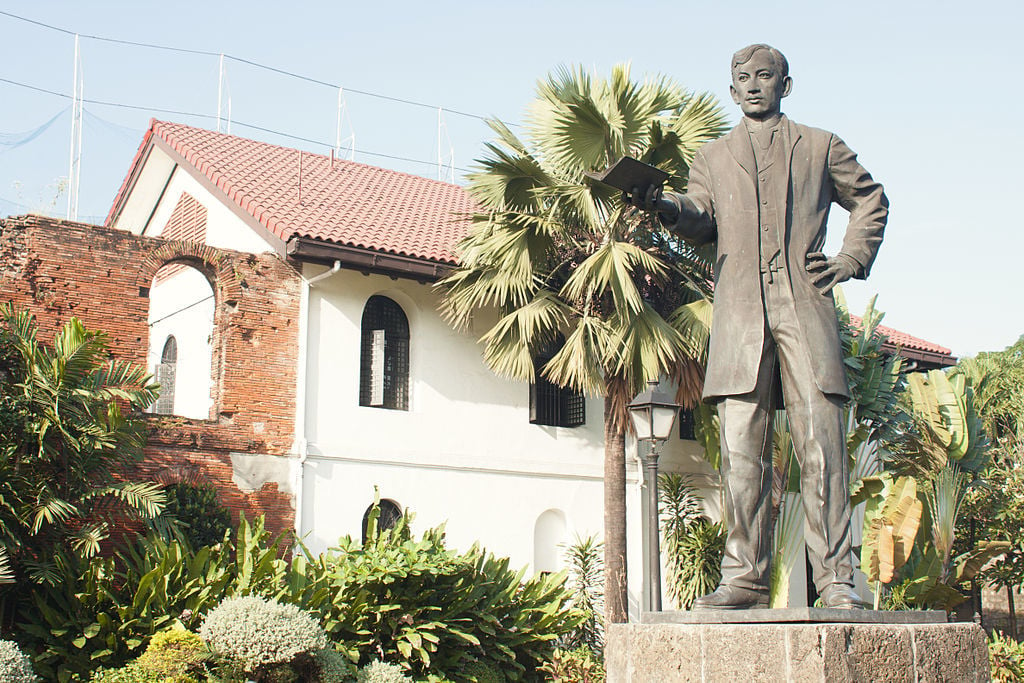
Before entering Rizal’s prison cell, you have to go through the Contemplation Room. Quotes by Rizal on patriotism cover the room. It’s not possible to visit the actual cell where Rizal was held but there is a model of the room where you can see an artwork of Rizal sitting at his desk!
In the Chamber of Text and the Reliquary Room, you can learn more about Rizal’s life and ideology. This room houses a first edition of one of his novels, as well as engravings of his poetry. You can also see some of his clothing. The most precious artifact is a bone from Rizal’s body, in which you can still see a bullet!
Day 1 / Stop 6 – San Agustin Church and Museum
- Why it’s awesome: This stunning church is a UNESCO World Heritage Site!
- Food nearby: Try Jollibee EAC for some Filipino-style fast food . If it’s a taste of home you want, there’s also a nearby McDonald’s!
Built in 1607, San Agustin Church is the oldest church in the entire Philippines. It was one of the few buildings in Intramuros to survive World War II! It’s also a beautiful building that captures the imaginations of those touring Manila!
San Agustin Church boasts some stunning architectural features. Be sure to admire the intricate frescoes on the vaulted ceiling which are very life-like!
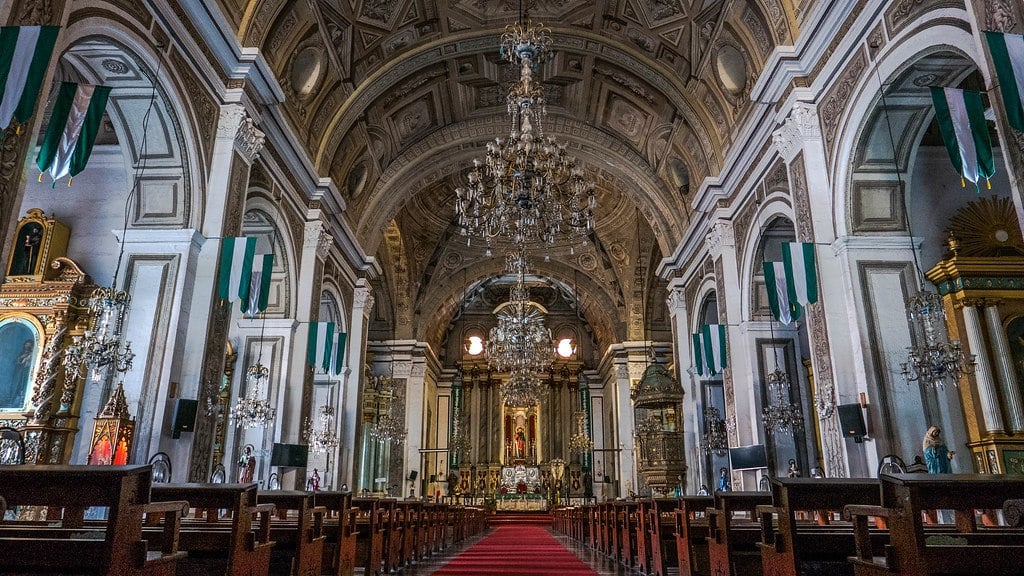
The San Agustin Museum holds a number of precious treasures owned by the church. The highlight is the Immaculate Statue which is made of ivory and has traces of Chinese influences! There’s also a giant bell that weighs 7495 pounds!
The staircase that ascends from the ground floor is also worth admiration as it was made of Cantonese granite back in the 18th century.
The museum is also home to a large collection of church vestments. The ornate robes are worn by priests and are works of art in their own right! You should definitely pop into the choir loft which boasts an amazing view of the church itself below! You can also be part of a tour.
Day 1 / Stop 7 – Manila Cathedral
- Why it’s awesome: This has been an iconic landmark in Manila since the 16th century!
- Cost: Free (donations welcome)!
- Food nearby: Barbara’s Heritage Restaurant is the perfect place for a dinner celebrating the first day of your Manila trip itinerary! You can look forward to scrumptious Philippine and Asian cuisine!
The Manila Metropolitan Cathedral-Basilica was first built in 1581 but, due to a series of disasters, it has been rebuilt eight times! The current one only opened in 1958, but it maintains the striking Neo-Romanesque style of its predecessors.
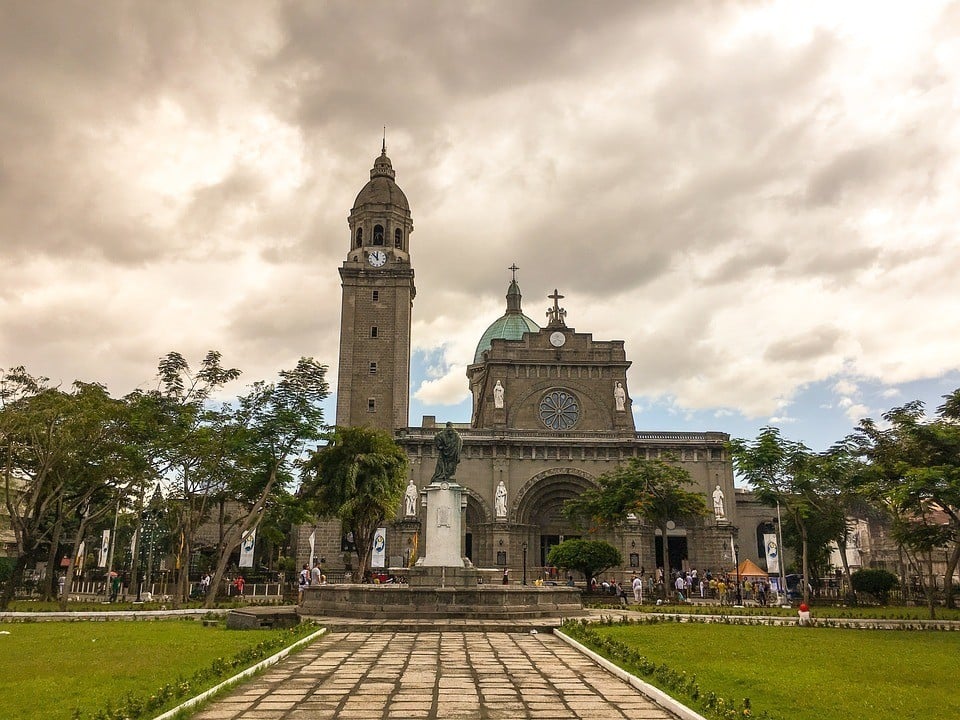
As the seat of the Archbishop of the Philippines, Manila Cathedral is suitably grand! The cathedral even counts the incumbent Pope Francis as one of its esteemed visitors! Be sure to admire the stained glass windows and vaulted ceiling. Consider taking a bike tour to explore this place.
Insider Tip: To really feel in awe of this impressive cathedral, try to attend a mass. This will allow you to experience the Cathedral as it was meant to be enjoyed and is a great way of joining in the local culture! You’ll find a schedule of mass services on the website or the cathedral’s noticeboard.

Wanna know how to pack like a pro? Well for a start you need the right gear….
These are packing cubes for the globetrotters and compression sacks for the real adventurers – these babies are a traveller’s best kept secret. They organise yo’ packing and minimise volume too so you can pack MORE.
Or, y’know… you can stick to just chucking it all in your backpack…
Chinatown | Malacañang Palace | Rizal Park | National Museum of Fine Arts | Manila Baywalk
Wondering what to see in Manila on your second day? Well, there’s a great combination of historical and natural landmarks on our 2-day itinerary in Manila!
Day 2 / Stop 1 – Chinatown
- Why it’s awesome: Full of history, food, culture and lots of energy, Chinatown is a place you have to visit when in Manila!
- Food nearby: There’s a huge variety of great food in Chinatown. Dong Bei Dumplings is a local favorite that serves fresh dumplings made right before your eyes!
Start your day with a trip to Binondo, the oldest Chinatown in the world! There have been Chinese traders in Manila since the 9th century, making a visit to Chinatown something you must do on your Manila vacation!
Binondo was originally its own town, home to Hokkien Chinese traders. It grew throughout the Spanish colonial period and experienced its heyday during the 1930s. During this period, the Americans transformed the quarter into a commercial center, complete with luxury stores and gorgeous Art Deco buildings!
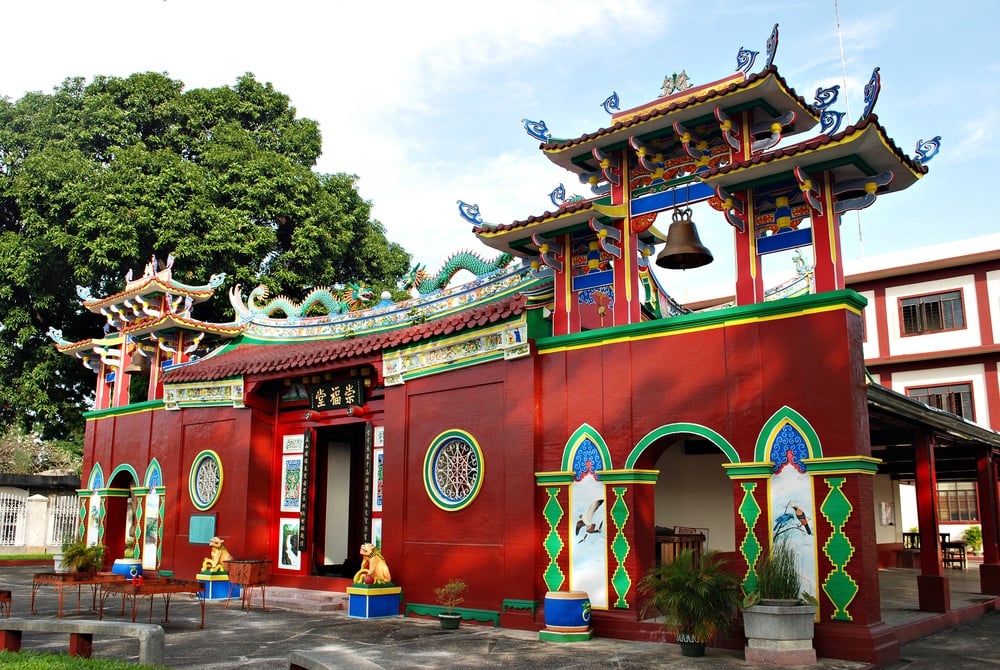
Binondo has since lost a lot of its former glamor but none of its energy! The best way of exploring this neighborhood is to take a horse-drawn carriage tour or just walk along the bustling streets. That said, there are a number of incredible things to do in Manila in this part of the city!
One of the major Manila landmarks in Binondo is the Arch of Goodwill. It’s one of the arches marking the boundary of Chinatown and was a gift to demonstrate the Chinese-Filipino friendship! Beyond the arch are Ongpin and Carvajal Streets. Here, expect to find traditional Chinese wares, such as traditional herbs. Go shopping in the colorful Feng Shui store near the arch. This is where local Chinese people buy Ying Yang charms and Feng Shui items!
It’s also worth putting the Temple of Kuang Kong on your itinerary for Manila! This temple is dedicated to the God of War who is also patron of martial arts and scholars. It’s a Buddhist temple where you can light incense, pray and have your fortunes told!
Day 2 / Stop 2 – Malacañang Palace
- Why it’s awesome: This has been the official residence of the leader of the Philippines since the Spanish era!
- Food nearby: Inside the palace is Casa Roces. It’s a 1930s family home that’s been converted into a restaurant and cafe! Even if you’re not hungry, it’s worth stopping by to admire the stunning decor!
Admiring Malacañang Palace is one of the best things to do in Manila! Apart from its long history, the palace is also very beautiful.
You’ll find Malacañang Palace perched alongside the Pasig River and taking in the view from across the bank alone is half the fun! The palace was first constructed in 1750 and became the official summer residence of the Spanish governor-general in 1825. Like many Manila landmarks, it’s been damaged and restored several times throughout the centuries.
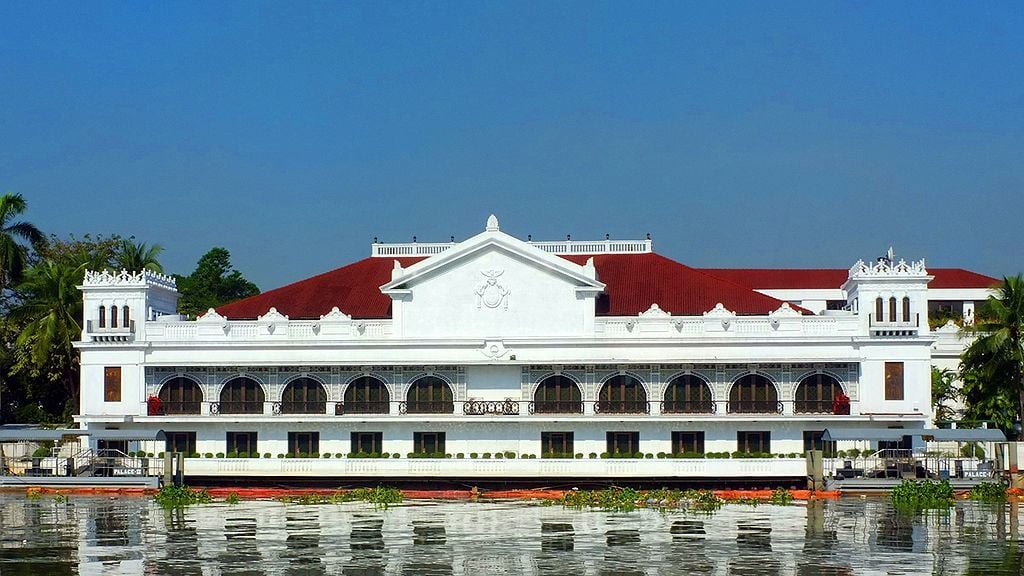
Malacañang Palace made headlines in 2016 when the newly elected president, Rodrigo Duterte, refused to move in, claiming that the palace was haunted! Even though he doesn’t live there, the president still uses the palace as an office so most of the complex is off-limits to visitors.
The Malacañang Museum is the main building open to tourists. It houses an impressive collection of memorabilia from the 16 Filippino presidents that have been in office since 1899.
You should also put it on your Manila itinerary to get a taste of the fabulous architecture in the palace — lookout for crystal chandeliers, gleaming wooden floors and paneling, and capiz windows (a traditional window made with oyster shells instead of glass)!
Insider Tip: To get inside the Malacañang Museum, you need to book at least five business days in advance. All you need to do is email the museum with your contact details, the number of people visiting, and copies of your passports!
Day 2 / Stop 3 – Rizal Park
- Why it’s awesome: This gorgeous green space is also the burial place of national hero Jose Rizal!
- Food nearby: Rizal Park is the perfect place to enjoy a picnic while touring Manila! If you want a sit-down meal, try Angel’s Pizza and Pasta!
Spanning 58 hectares, Rizal Park is a refreshing public park in the heart of the urban Jungle! It’s also one of the most important historical Manila attractions, as it is the burial place of Jose Rizal!
The iconic Rizal Monument is something that has to be on your Manila itinerary! You’ll find this gigantic monument in the center of the park. A 150-foot flagpole marks the entrance and sentries in full military uniform guard the monument day and night by!
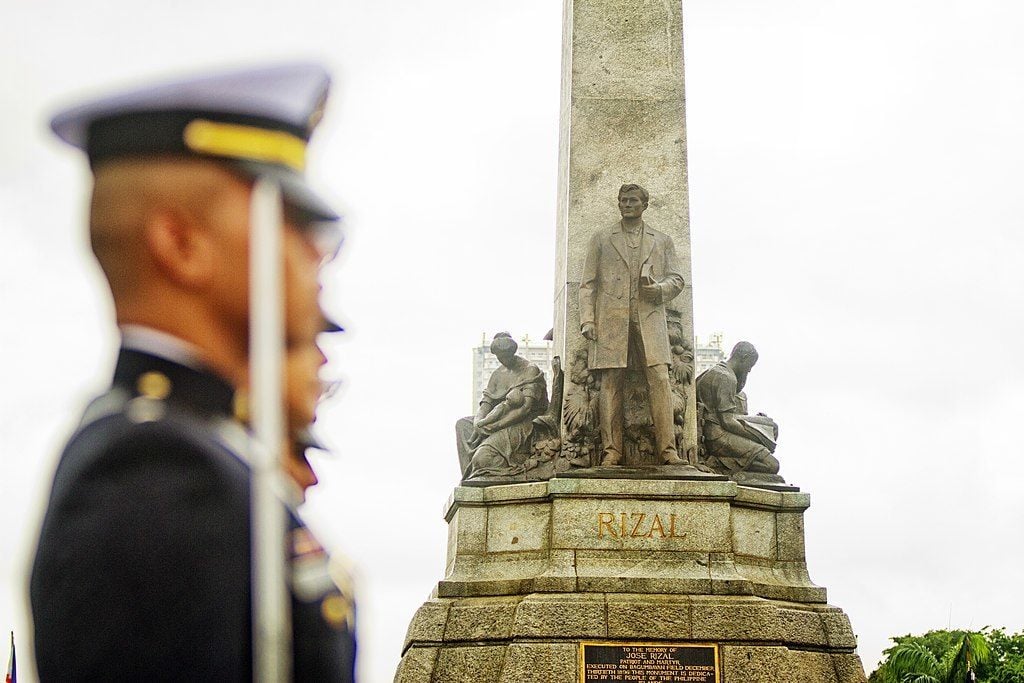
On one side of the monument is a plaque indicating the site of Rizal’s execution and an engraving of his final poem My Last Farewell . There are eight bronze statues around the column that depict the final moments of the nationalist hero’s life!
Nearby is the Central Lagoon. Busts of other Filipino heroes surround the pool and there is a dancing fountain that is illuminated with colorful lights at night!
On the eastern end of the park, outside the National Museum of Fine Arts is a statue of Lapu-Lapu, another Filippino hero. Lapu-Lapu was the ruler of Mactan and is seen as the first national hero since he was the first to resist Spanish colonization! Locals also celebrate him for killing Portuguese explorer Ferdinand Magellan when he attempted to invade Mactan after locals refused to convert to Catholicism!
Insider Tip: If your trip to Manila falls on a weekend, rather visit Rizal Park later in the evening. Then, you can attend one of the free rock concerts on a Saturday night or a classical music concert on a Sunday night!
Day 2 / Stop 4 – National Museum of Fine Arts
- Why it’s awesome: This incredible museum is bursting with magnificent pieces of local art!
- Food nearby: Macau Imperial Tea is a great place for an afternoon snack and, of course, milk tea!
Next up on your Manila itinerary is the National Museum of Fine Arts, which is conveniently located on the edge of Rizal Park! With 2 days in Manila, you have to visit this museum to learn more about the Philippines’ art and culture scene!
The museum is housed in a striking Art Deco building but the true highlight is still the artworks! The galleries are organized around period, media and themes, so it’s easy to find art that interests you. There are, however, a number of absolute must-sees!
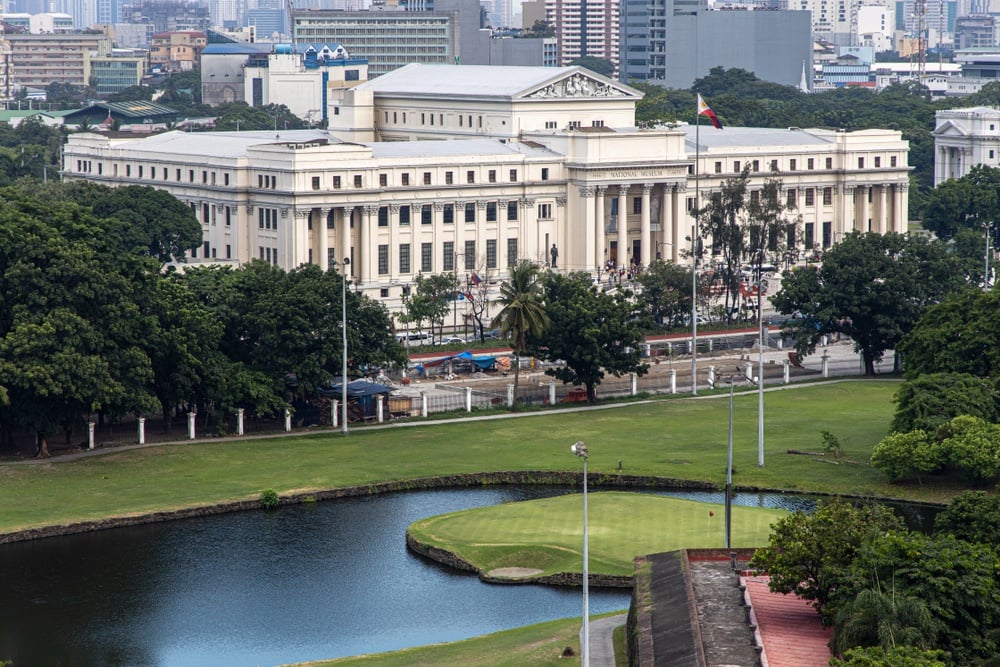
Portrait of a Lady by Juan Luna y Novicio is one of those pieces of art with a story! It’s rumored to bring misfortune to all of its owners, including its last owner, First Lady Imelda Marcos!
Felix Resurreccion Hidalgo’s La Barca de Aqueronte is another masterpiece to admire. The physicality of the painting won the artist plenty of awards and cemented his status as a great Filippino artist!
Painted during World War II, The Burning of Manila by Fernando Amorsolo y Cueto is a seminal work in the artist’s portfolio. The picture depicts Manila in flames, with locals fleeing the scene and is very evocative!
Another World War II-era painting to see is the violent Rape and Massacre in Ermita which vividly shows the real harm war does to families.
Finally, be sure to find Noli Me Tangere by Leonardo Cruz. It’s in a gallery dedicated to art inspired by Jose Rizal but even so, this piece stands out. It’s a beautiful compilation of scenes from Rizal’s work of the same name.
Day 2 / Stop 5 – Manila Baywalk
- Why it’s awesome: This seaside promenade is a wonderful spot to watch the sunset in Manila!
- Food nearby: Manila Baywalk hosts many food vendors so it’s the perfect place to try Filippino fast food, such as roast chicken followed by coconut cakes for dessert!
Watching the sunset over one of the great Manila landmarks is the perfect close to your 2-day itinerary in Manila! The best place to do this is at the Manila Baywalk, a promenade that runs along the seaside in the city!
Manila Baywalk overlooks the Bay of Manila. This enclave was the scene of a naval battle between America and Spain in 1898 that effectively ended 300 years of Spanish rule in the Philippines! Appropriately, the promenade starts at the American Embassy.
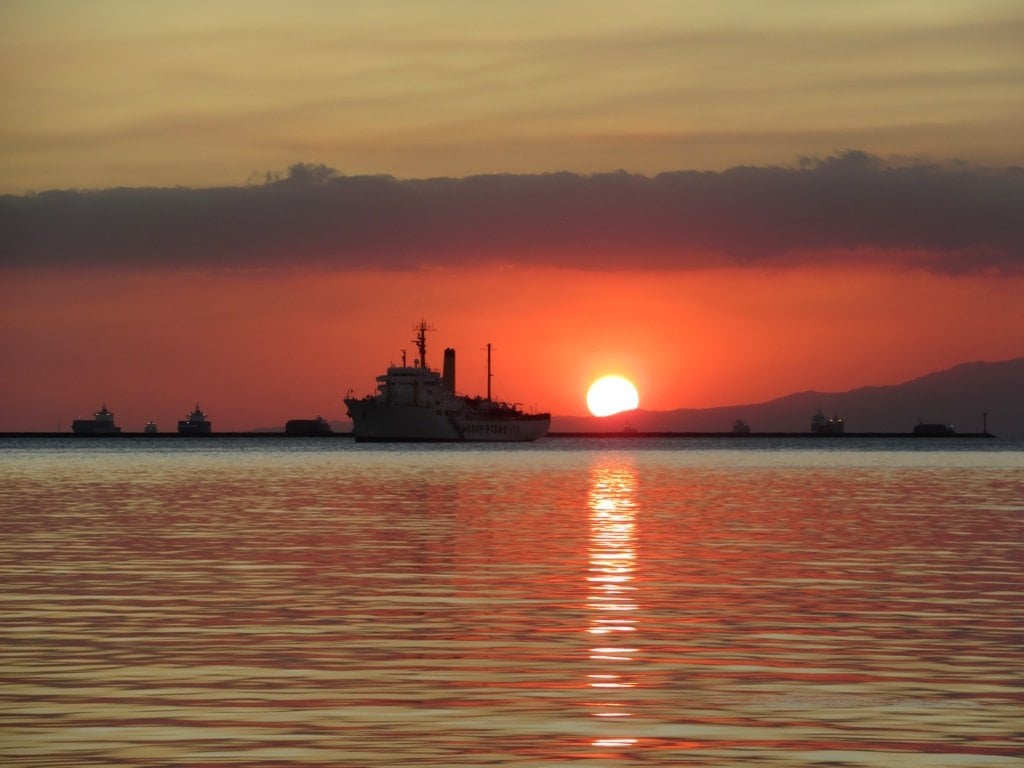
The promenade stretches for around a mile, alongside Roxas Boulevard. Palm trees provide shade and there are plenty of ornamental plants. As evening starts, live musicians set up, making this a charming place to stroll during your weekend in Manila! (If you’re very sporty, it’s also the perfect spot to go jogging).
Restaurants, cafes, bars, and dancing spots line the beach strip if you want to spend the night in the area. At the southern end of Manila Baywalk is the harbor, where you can take a sunset cruise around the bay. Even if you’re not catching a boat, it’s worth exploring the picturesque harbor. Finally, find a bench and get your camera ready for a spectacular sunset!
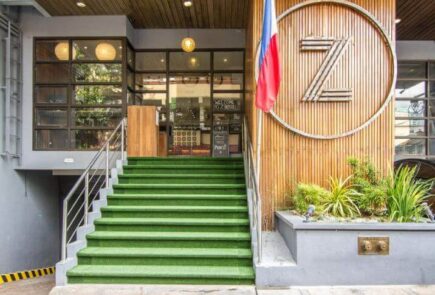
Manila-Z-Hostel
This hostel has the perfect location in the central district of Makati! It’s consistently praised for its cleanliness and friendly staff. For more great hostel options, check out these great Filipino hostels.
- Free Breakfast
Cultural Center of the Philippines Complex | Manila Ocean Park | Divisoria Market | SM Mall of Asia | National Museum of the Filipino People
If you don’t know what to do in Manila for 3 days, then stick close to our suggestions! Our 3-day itinerary in Manila will give the best ideas for how to entertain yourself in this gorgeous city!
Cultural Center of the Philippines Complex
- This is Manila’s premier theater and movie cinema!
- The sprawling complex is home to six grand performance venues!
- Whether it’s ballet or film, there’s something for everyone at the Cultural Center!
Since its opening to the public in 1969, the Cultural Center of the Philippines Complex has been the country’s top arts performance venue! It’s one of the loveliest places to visit in Manila and the best place to catch a show!
The Cultural Center was a pet project of President and First Lady Marcos and is considered emblematic of how Manila was at its best and most glamorous during the Marcos Era.
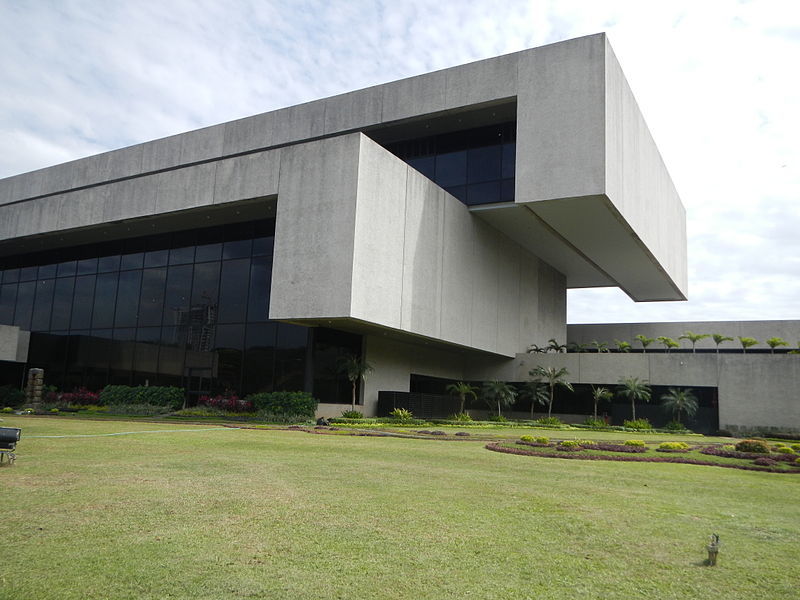
As well as being a performance venue, the complex is also home to a number of museums and galleries. You can explore the contemporary art museum, the ethnographic museum, as well as a number of exhibition galleries!
The architecture of the complex is also a great monument in itself. It was designed by esteemed Filippino architect Leandro Locsin. There are elements of the brutalist modern style (such as the heavy concrete and simple straight lines), as well as traditional Filipino features like the floating volume and a marble slab that has the appearance of floating in the air!
The best way to experience this venue is naturally to book a show! You can find classical music, theater, the National Ballet, and folk dance all at the Cultural Center. It’s the perfect treat to put on a 3-day itinerary in Manila!
Manila Ocean Park
- This huge aquarium is simply breathtaking!
- The aquarium is home to over 14 000 creatures!
- Ocean Park is one of the most fun things to do in Manila!
Manila’s Ocean Park is even bigger than Singapore’s and its size is echoed in the sheer diversity of creatures that call it home! It also runs lots of interactive public programs, making it the perfect place to visit with kids if you have 3 days in Manila!
The Oceanarium is one of the stellar Manila attractions you’ll visit. This aquarium focuses on marine life that is indigenous to the waters of South-East Asia. The water in the facility comes directly from Manila Bay and is filtered to suit the animals perfectly! In the midst of the aquarium is a 220° curved walkway tunnel. From here, you can see the marine life swimming blissfully overhead!
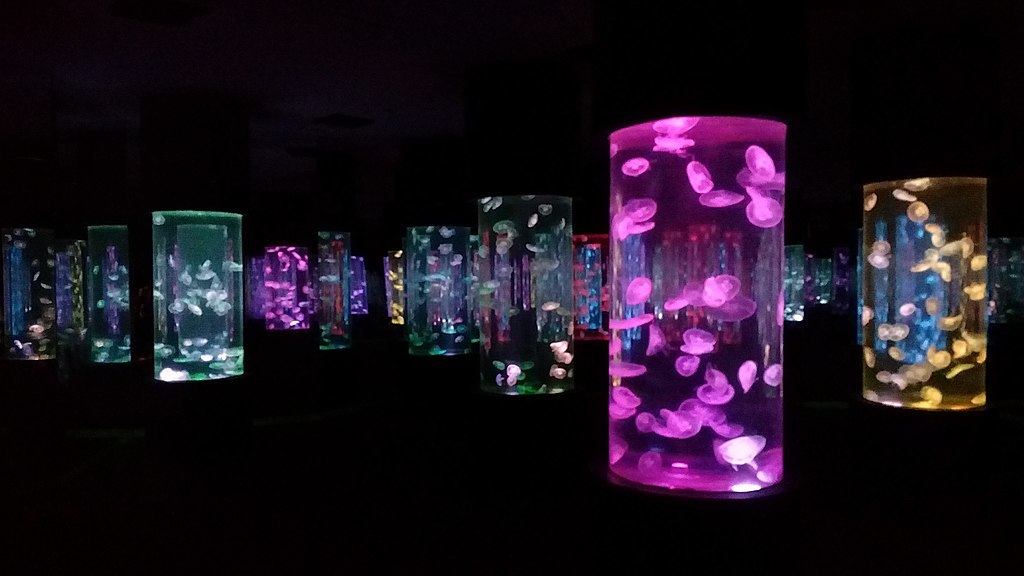
If you’d like to get into the water, you can book an Aquanaut Voyage. This experience allows you to explore inside the tanks with minimum effort, thanks to a special diving helmet that lets you breathe normally! You could also go for the Sharks & Rays Encounter, which lets you swim with these special creatures!
Another fun activity is a session on training sea lions. During this encounter, you can swim and perform a few tricks with the sea lions!
Divisoria Market
- Calling all shopaholics and bargain-hunters…you must put Divisoria on your Manila trip itinerary!
- This is where you will find everything you could need or want at the cheapest prices imaginable!
- The riot of color and noise inside the market make it an unforgettable experience from your Manila travels!
Divisoria Market dates back to the Spanish Era in Manila when people who weren’t Christians were forbidden from trading in Intramuros. Undeterred, they set up shop in Divisoria . The market is now one of the most vibrant and exciting attractions on any Manila itinerary!
When the nearby railway station opened at the start of the 20th century, Divisoria got a huge boost from the wholesale goods that were now easily available! Wholesalers still sell their wares at Divisoria, meaning things are even cheaper if you buy in bulk or know how to bargain!
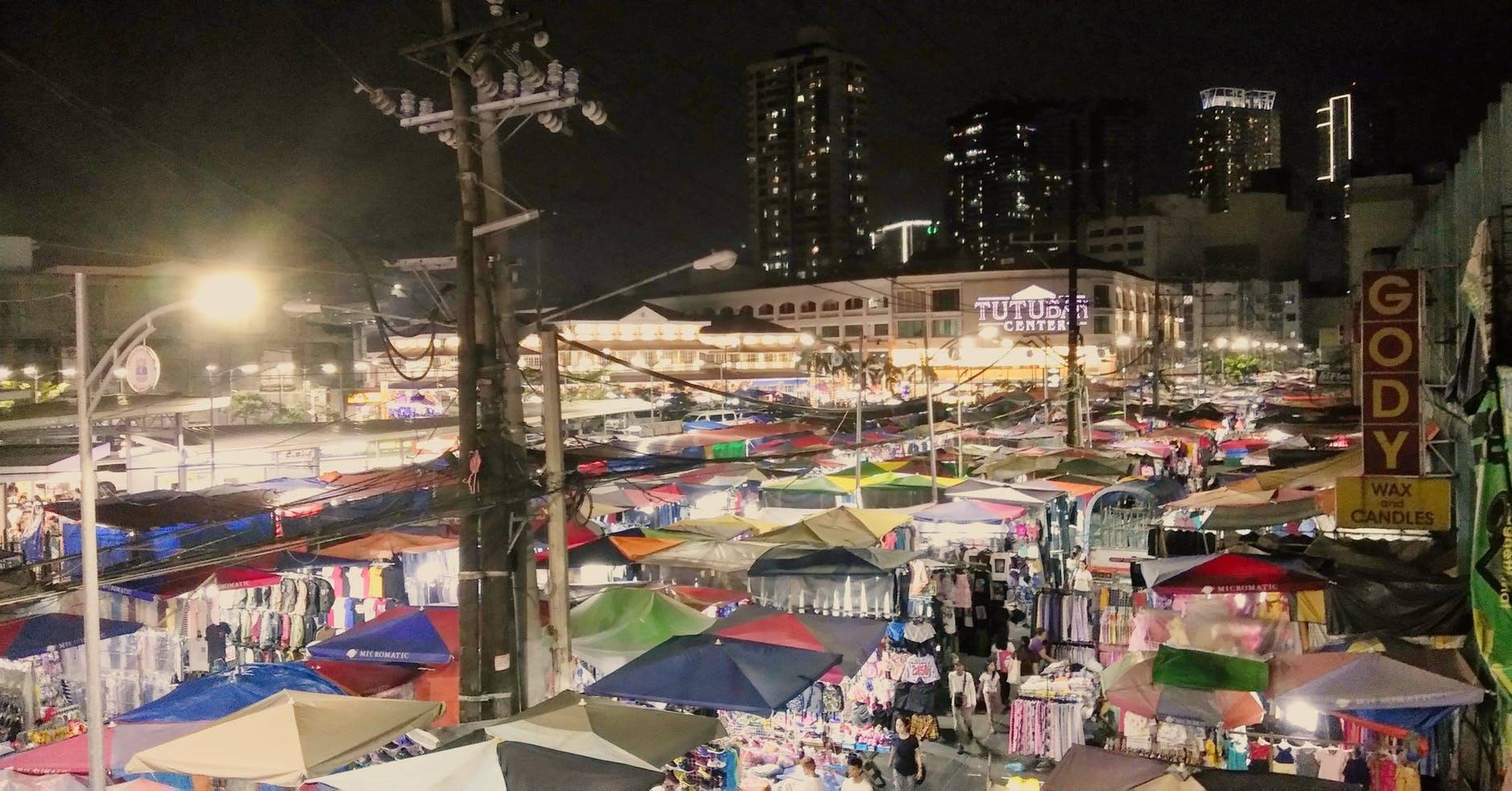
You can find everything imaginable at Divisoria — whether that’s clothes, toys, crafts or electronics! The bustling atmosphere of buying and bargaining can be infectious, pushing you to buy things you don’t need. Rather set a budget and take the exact cash with you so you’re not tempted to overspend!
Divisoria Market is also a great place to try some local street food at really affordable prices. Just remember to bring some bottled water along!
SM Mall of Asia
- This is the fourth largest mall in the Philippines and one of the largest in the world!
- It’s more than just a mall, with plenty of tourist attractions too!
- The 2-story entertainment complex could occupy you for days!
SM Mall of Asia may seem like an unusual place to include on your Manila itinerary, but there are so many fun things to do there!
Of course, there is a huge range of shops and restaurants to discover but that’s really just a sideshow! What you want to do here is visit the entertainment complex!
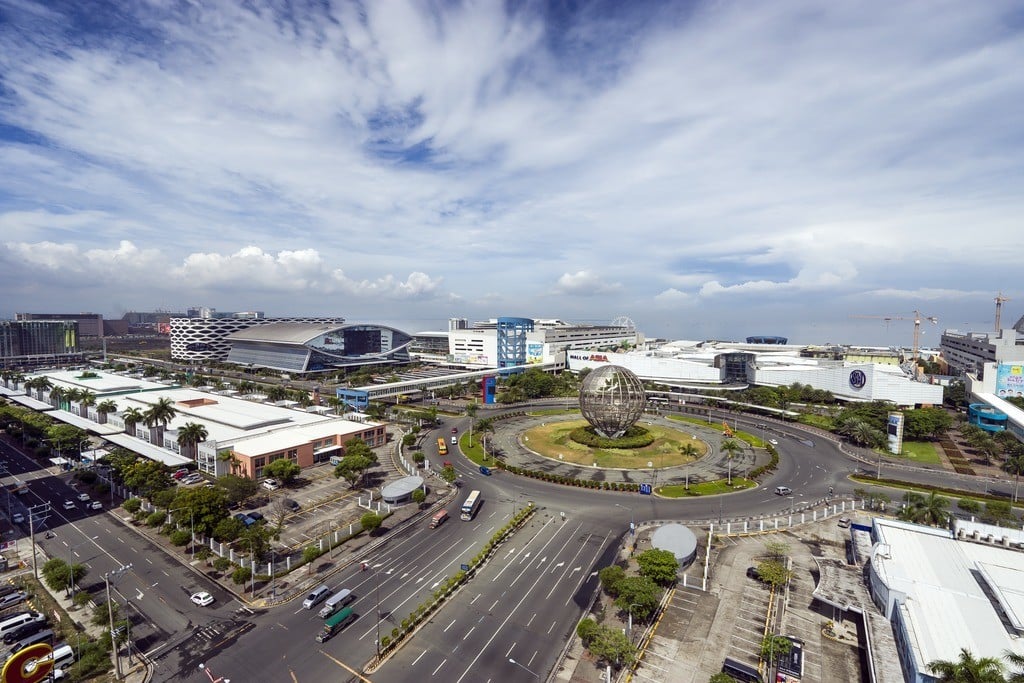
The entertainment complex is home to the first ice rink in the Philippines and IMAX movie theaters. There’s also a small amusement park outside! The mall is located right beside the Bay of Manila and offers great views of the sea! If you’re not up for the rides, it’s also a good place to picnic or sit on a bench with ice cream and enjoy the seaside breeze!
SM Mall of Asia is a great place to come to watch the sunset. On weekends, there are even firework displays in the evenings! If that doesn’t interest you, then avoid the weekend crowds and visit during the week.
National Museum of the Filipino People
- This massive museum houses archaeological artifacts from across the country’s history!
- There’s a large collection of stunning precious items like jewelry and porcelain!
- All of this is free to visit!
Also known as the National Museum of Anthropology, this amazing museum is a stellar curation of the Philippines’ history through fascinating objects! It’s a must while you’re in the Manila city center!
The ground floor is dedicated to the San Diego Exhibit which centers around a collection of 5,000 objects retrieved from the shipwreck of San Diego which sunk in 1,600 after a battle with the Dutch! There are common items like hazelnuts and chicken bones but also more valuable items. Tons of precious Chinese porcelain, rosaries and silver goblets are some of the highlights. You can also admire eleven canons!
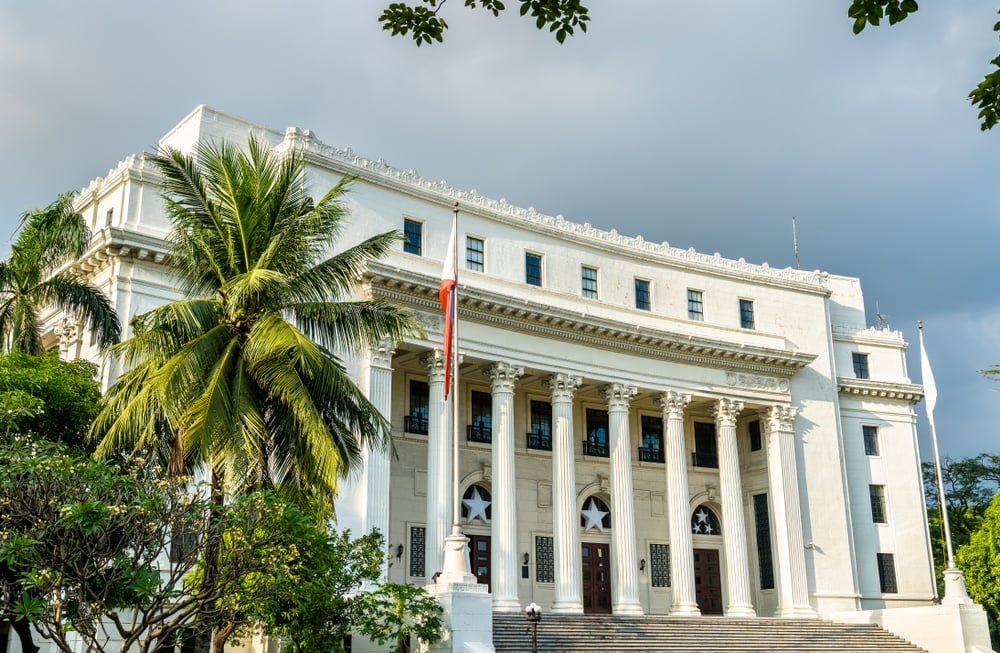
The gallery of Five Centuries of Maritime Trade Before the Arrival of the West does exactly what its long name indicates! Items like gold and porcelain bring the South-East Asian trade routes to life!
The Filipinos and Their Rich Cultural Heritage and Archaeological Treasures galleries focus on indigenous cultures and artifacts. One of the fascinating highlights is the Ayub Cave jars which date from 5 BCE! People would rebury the bones of their ancestors in these jars.
The Origin Gallery is also an intriguing trip through history in the pre-historic era! Here you can come up close to the skullcap of the earliest known inhabitant of the Philippines, the Tabon Man, who lived in 24000 BCE!
It’s always a good idea to learn more about safety when you’re planning a trip to Manila. Manila may not be a particularly violent city but there are petty crimes and health hazards that you should be aware of! Manila is mostly safe to visit.
As a tourist, you tend to see the wealthier parts of Manila, but the city is also home to a large population of very poor citizens and theft is common. Keep your belongings close, avoid walking around at night, and try not to wear expensive jewelry which could make you an obvious target!
Be careful of where you draw money or change currency. Avoid making currency exchanges at facilities that aren’t banks since you could be overcharged. It’s also best to only make ATM withdrawals at ATMs in banks or hotels so that you avoid those that are rigged to read your card information!
If you’re only in town for a short period, it isn’t worth putting your body through the challenge of acclimatizing to local tap water. The tap water is generally safe but foreign bacteria could make you feel queasy at first so stick to bottled water.
Don’t Forget Your Travel Insurance for Manila
ALWAYS sort out your backpacker insurance before your trip. There’s plenty to choose from in that department, but a good place to start is Safety Wing .
They offer month-to-month payments, no lock-in contracts, and require absolutely no itineraries: that’s the exact kind of insurance long-term travellers and digital nomads need.

SafetyWing is cheap, easy, and admin-free: just sign up lickety-split so you can get back to it!
Click the button below to learn more about SafetyWing’s setup or read our insider review for the full tasty scoop.
Whether it’s hiking, canoeing or relaxing in a resort, there are some incredible things to do near Manila! The most convenient way of exploring the surrounding areas is to go on one or two awesome day trips from Manila!
Taal Volcano Full-Day Adventure Tour from Manila
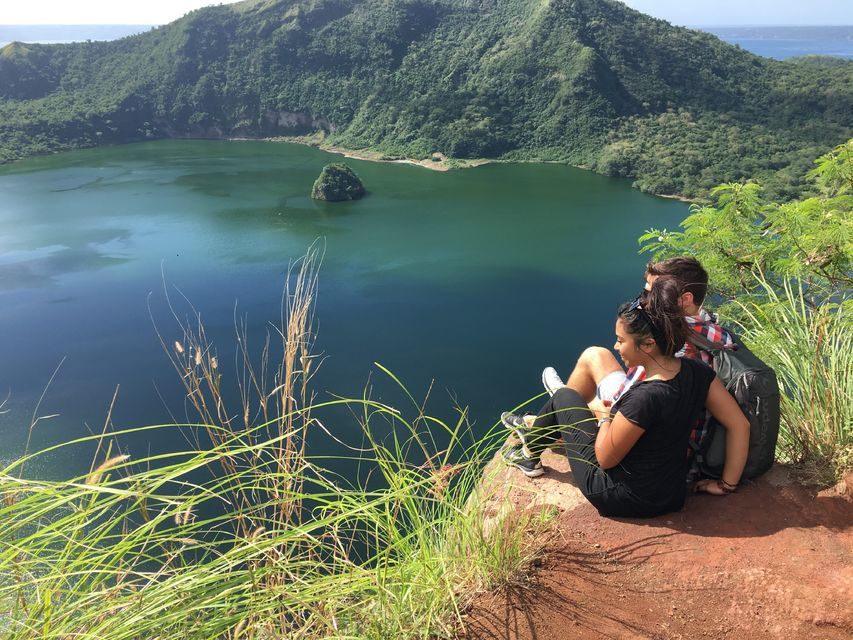
Taal Volcano is a such a popular attraction with those who visit Manila that it has to be on your Manila itinerary!
This is one of the greatest day trips from Manila, during which you can come up close to the Philippines’ second most active volcano! The volcano is atop an island that you can reach via boat. After that, it’s time to climb this terrific mountain! If you want more of a challenge, try taking a horse ride to the top! The panoramic views and crisp fresh air are the highlights of this epic trip!
Full-Day Tour Villa Escudero Plantation
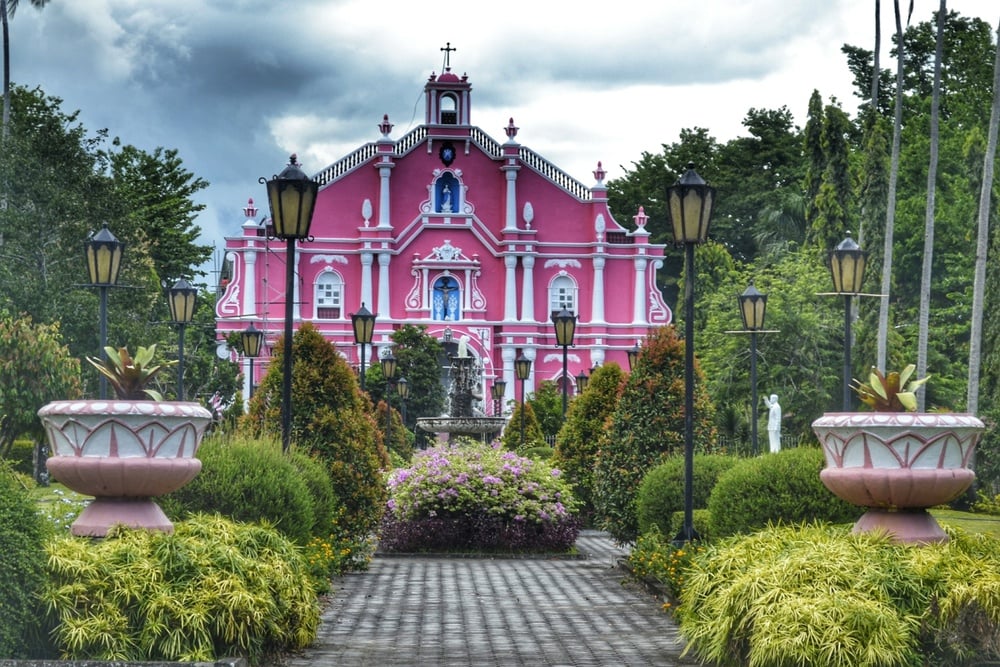
Outside of Manila is countryside so peaceful you will find it hard to believe that there’s a massive city just a few hours away! The area is home to plantations where you can experience rural life while on vacation in Manila!
Escudero Coconut Plantation is a tourist-friendly estate that teaches you about the history of coconut farming in the Philippines, as well as showing you how it’s done! There’s also a private museum that houses the family’s collection of historical artifacts dating from pre-Hispanic times! As if that’s not enough, you can enjoy a swim in one of the pools or lagoons on the estate!
From Manila: Majestic Pagsanjan Falls Adventure
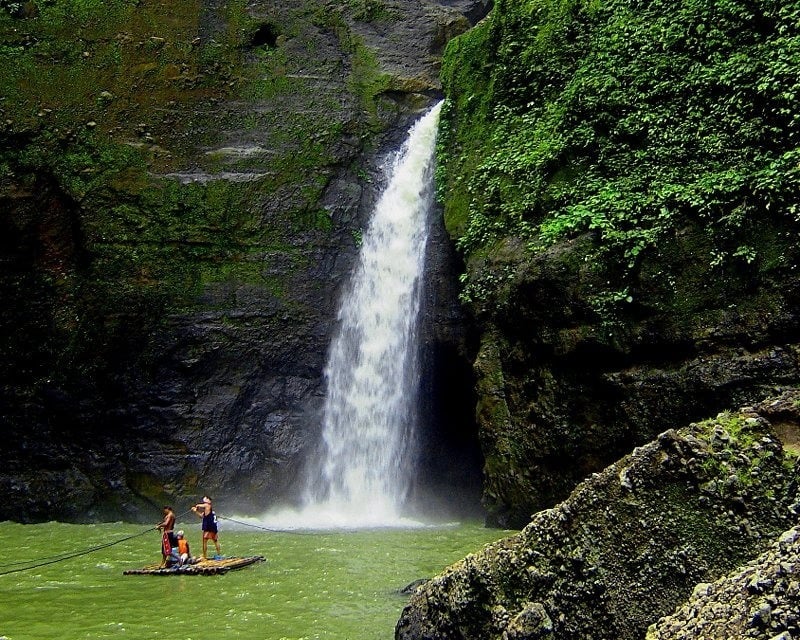
Visiting Pagsanjan Falls is one of the most incredible things to do in the Philippines! It’s located in the Pagsanjan Gorge National Park, a beautiful landscape of forests and waterfalls!
The best way to immerse yourself in the park’s breathtaking environment is on a canoe trip! You can hire an indigenous dug-out canoe, steered by two boatmen and explore the stunning area.
Behind the 300-foot waterfall is a cave of water in which you can swim or explore on a bamboo raft. This is an exhilarating experience that will stay with you long after your Manila travel experience ends!
From Manila: Full Day Trip to Tagaytay Ridge
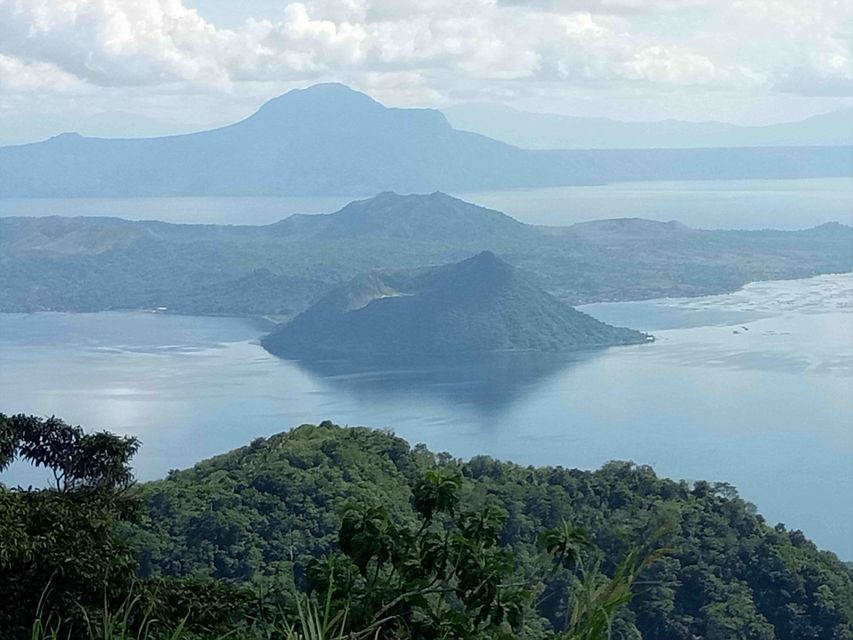
Just an hour and a half outside of Manila is the city of Tagaytay, which is surrounded by the majestic Tagaytay Ridge. Here you can enjoy breathtaking views of the encircling landscape, including Taal Volcano !
Along the way, you’ll also stop by Las Pinas to explore the iconic San Jose Church. It’s home to an organ made entirely out of bamboo! A Spanish priest created this unique instrument in the 19th century and it produces a special sound!
This trip also makes time to visit a jeepney assembly plant where you can learn more about this classic Filipino transport method!
Subic Bay Adventure
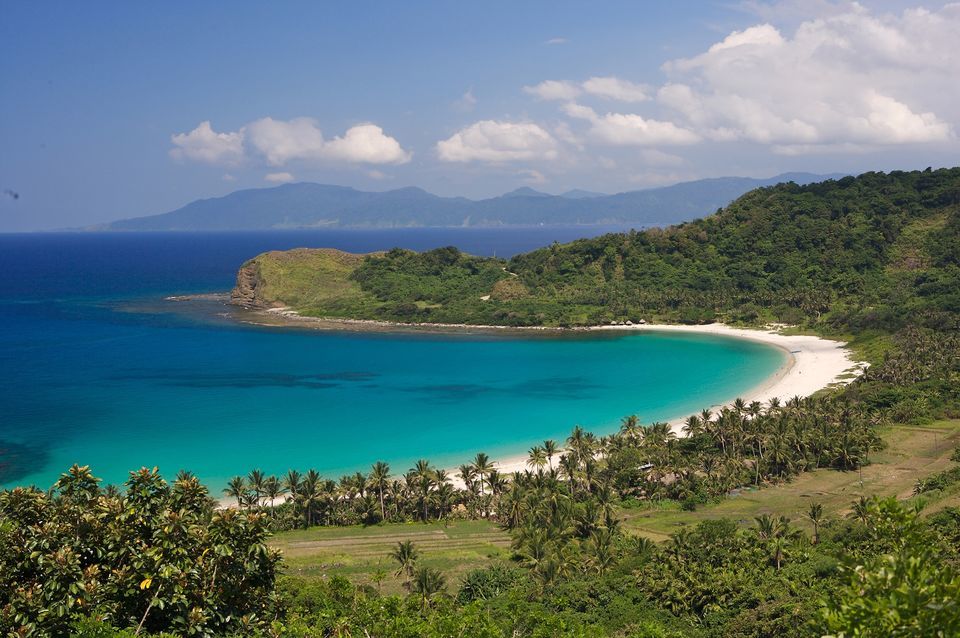
The 75-mile journey to Subic Bay is undoubtedly one of the best day trips from Manila! This gorgeous region is also full of military history!
Subic Bay was once the biggest American naval facility in the Asian-Pacific region until a volcano erupted in 1991. The government later redeveloped the area into a port and tourism zone.
The eruption of Mt. Pinatubo was the largest volcanic eruption of the 20th century. Learn more about the havoc it caused before relaxing in the gorgeous nature!

Stash your cash safely with this money belt. It will keep your valuables safely concealed, no matter where you go.
It looks exactly like a normal belt except for a SECRET interior pocket perfectly designed to hide a wad of cash, a passport photocopy or anything else you may wish to hide. Never get caught with your pants down again! (Unless you want to…)
Find out what people want to know when planning their Manila itinerary.
What can you do in Manila for free?
Most things! But head to the Intramuros area of the city to soak in the stunning Spanish colonial architecture and the buzzing streets surrounding it.
Is Manilla worth visiting?
It’s definitely worth a couple of days to see another and a more real side to this incredible and fascinating country.
Where in Manila is Instagrammable?
The colourful buildings of Manila’s Chinatown and the local Dong Bei Dumplings will give you heaps of content!
Where do couples go in Manila?
Couples will love a romantic stroll along Manila Baywalk at sunset on their Manila Itinerary.
Conclusion of Manila Itinerary
From museums to green spaces and churches to bars, there is something for everyone in Manila! With so many fabulous activities and attractions on our Manila itinerary, you’ll never need to wonder what to do in Manila, Philippines next!
Manila is often overlooked as a holiday destination in favor of its glamorous neighbors, Singapore or Kuala Lumpur, but it has so much to offer that no-one will ever regret a Manila trip! Larger-than-life heroes and monumental battles fill the city’s long history. Combine this with the many diverse cultures that have called Manila home over the centuries, and you have a truly cosmopolitan city!
Whether you’re in and out of Manila in a day or staying longer, we can promise an awesome trip with our epic Manila itinerary!

Rhenz Caguioa
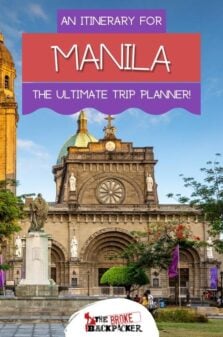
Share or save this post

Leave a Reply Cancel reply
Your email address will not be published. Required fields are marked *
Save my name, email, and website in this browser for the next time I comment.
Notify me of followup comments via e-mail.
Nomadic Matt's Travel Site
Travel Better, Cheaper, Longer
How to Visit the Philippines on a Budget

Today’s guest post comes from Will Hatton from The Broke Backpacker . He’s an adventurer and location-independent entrepreneur who has spent a great deal of time in the Philippines, and in this post, he shares his best tips and advice to help you travel the Philippines on a budget.
The Philippines is one of the most incredible budget travel destinations in the world due to its perfect white-sand beaches, enchanting seas, mesmerizing sunsets, friendly locals, and relaxed, tropical vibes.
I’ve been lucky enough to travel through the Philippines multiple times ( I even have a hostel here ). The country has everything, from towering volcanoes and pristine coral reefs to lush jungles, underground rivers, mammoth caves, and some of the most enchanting waterfalls in the world. You can snorkel around World War II wrecks, camp out in the jungle, and head deep within the earth through limestone cave systems.
And, on top of it all, The Philippines is ridiculously cheap!
Rum is cheaper than most soft drinks, and delicious Filipino foods like lumpias (fried spring rolls) or pancit (fried noodles), or halo-halo dessert (ice shavings, condensed milk, small chunks of sweet boiled kidney beans, coconut gel, and tapioca) are often less than a dollar. You can sleep in a hammock for less than five dollars a night in many hostels (or for free if you simply set up on the beach).
The Philippines is a country you can travel on for as little as $20 USD a day if you’re doing it on a broke-backpacker budget — and it’s possible to travel much cheaper than that if you really push it by hitchhiking and camping. Obviously, your budget can balloon, especially if you’re staying at luxurious beachfront resorts, eating out at fancy restaurants, and taking expensive tours.
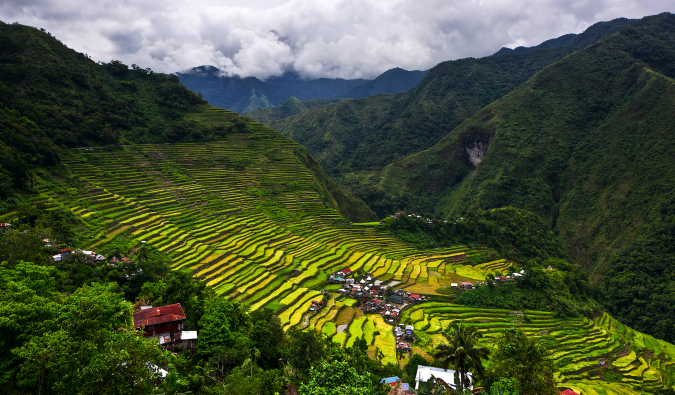
Here are some typical costs for backpacking the Philippines in 2023:
- Dorm bed in a hostel: $6–15 USD per night
- Public ferry ride: $6–8 USD per ride
- Jeepney ride: 20–50 cents
- Street food: $1.50–4 USD
- Restaurant meals: $5–7 USD
- Long-distance bus: $8–10 USD
- Domestic flight: $50–90 USD
- Local beer: $2–3 USD
- 1.5L bottle of water: 75 cents
- Island-hopping: $15–25 USD
- Diving with whale sharks: $25-50 USD
Accommodation – Posh backpacker hostels can be pretty expensive in the Philippines, setting you back as much as $20 USD a night for a dorm bed. Luckily, there’s plenty of budget accommodation available once you are out of Manila; for example, you can find dorm beds for as little as $6 USD a night in Palawan. Most hostels include patchy Wi-Fi and air conditioning. Local guesthouses and huts on the beach are even cheaper than hostels; you can sometimes score a hut for just $2 USD a night.
Food and drink – Street food can cost as little as $1 USD for a plate of tasty mystery meat. If you decide to eat in tourist-centric restaurants, prices will be higher with meals costing between $6-20 USD.
In Manila and other posh parts of the Philippines, you can end up spending a lot on food and drink, especially on a night out, so try to pregame (drink some beers on the street) before heading out for a night on the town. A coconut, for that inevitable hangover, will cost less than a dollar.
Transportation – Flights can quickly eat into your budget, so it’s best to stick to ferries if you are long on time but short on cash. There are pretty decent long-distance buses running across some of the bigger islands, such as Luzon, but inevitably you’ll end up on a ferry. It’s simply the only way to get to many of the islands.
Activities – The Philippines is one of the cheapest places in the world to learn to dive; a dive can set you back as little as $30 USD in some places, but generally costs more like $50 USD. Snorkeling is even cheaper; you can hire snorkeling gear for $3–5 USD a pop on many beaches.
How much it costs to travel in The Philippines really depends on your travel style and where you go. Manila (especially) and Boracay are significantly more expensive than other parts of The Philippines and once you are out of the tourist hot spots it’s relatively easy to thrive on a budget of $35-40 USD a day.
$35 USD a day will enable you to stay in a decent shared room if you’re splitting the cost with a buddy or a comfortable dorm in a cool hostel if you’re on your own. You’ll have plenty left over to eat in decent restaurants three times a day, get around by Uber and drink some beers in the evening.
You can go high or lower than that depending on how cheap (or expensive) you want to get with your accommodation, how much you drink, and how many Western meals you consume.
How to Save Money in the Philippines
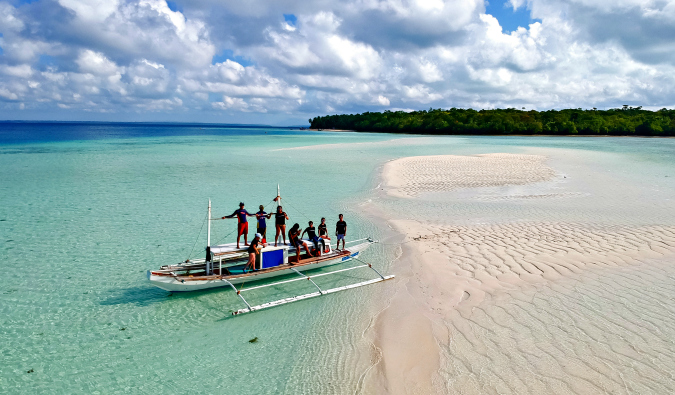
Stay with a local – Couchsurfing is very popular in the Philippines, and it’s a great way to meet people and save on accommodation costs. If you don’t fancy Couchsurfing, stay at a locally run guesthouse; they are often cheaper than hostels.
Keep an eye out for Air Asia sales – Air Asia is one of the cheapest airlines servicing The Philippines and has fairly frequent sales where you can snap up cheaper than normal fares – it’s worth signing up to the Air Asia newsletter to be kept in the loop on these so that you can pre-book all your internal Philippines flights next time there is a sale.
Buddy up – Most of the best activities are a lot cheaper if you can get a group together to split the cost.
Hitchhike – Hitchhiking is also pretty popular in the Philippines and a fantastic way to meet new people, have an adventure, and save some money at the same time. Hitchhiking does carry a certain degree of risk in every country but, in my opinion, The Philippines is one of the safer countries in the world to stick out your thumb.
The big risk is drunk drivers so if you think somebody has had a few too many, don’t get in the car with them.
For the most up-to-date hitchhiking info, use Hitchwiki .
Stick to food locals eat – There are plenty of tourist-trap restaurants that are very expensive. Avoid these and follow the locals — they know where the best value and tastiest food is! I like to ask hostel and guesthouse staff where they themselves like to eat – this is a great way to find hole-in-the-wall restaurants aimed at local Filipinos with cheap pricing.
Camp – If you’re really on a budget, I recommend taking a tent; there are lots of epic places to camp, and nobody will mind. You can camp for free on many beaches in The Philippines and plenty of hostels will also let you pitch in their garden when they have one if you’re buying drinks at their bar.
Bring a water bottle – The tap water here isn’t safe so bring a reusable water bottle with a filter so you can stay safe and save money (buying water every day adds up). Lifestraw makes a water bottle with a built-in filter so you know your water is always safe.
General Travel Tips for the Philippines
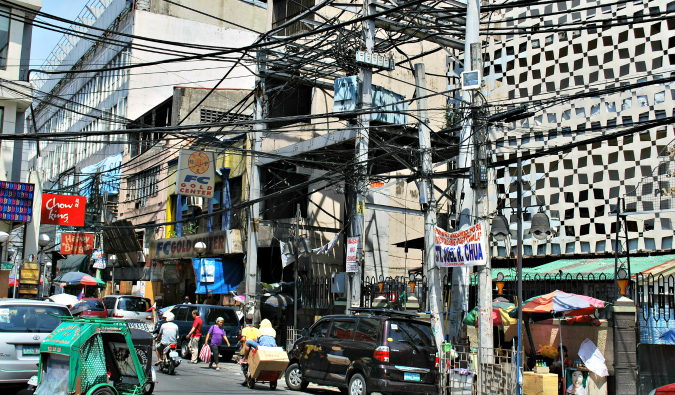
Unfortunately, it’s pretty hard to completely avoid Manila, as most flights around go through it. However, you can avoid scams while stopping over in Manila. The main travel scams concern transportation to a different terminal in the airport and when leaving the airport.
If you have arrived at a particular terminal but fly out of another, use the free shuttle bus that runs throughout the airport.
There are no metered taxis in the arrivals section, only private transfers. This is where the majority of travelers get ripped off, as they jump into a car without thinking, overlooking the exchange rate and how much it will actually cost. It’s the Philippines, so it’s going to be cheap, right?
When I first arrived in the Philippines, I very nearly ended up paying $50 USD USD for a private transfer to my hostel in downtown Manila! Thankfully, I knew the exchange rate and how ridiculous that was so I didn’t use that taxi and instead caught a metered taxi.
If you’re trying to get downtown, take a public metered taxi on the departure level instead. The lines are usually quite long, but they tend to go fast, as there are tons of cabs in Manila. Just make sure that you take into consideration peak-hour traffic. Manila is one of the most congested cities in the world; sometimes a ten-minute ride can take up to two hours. So avoid the 5pm–10pm crazy rush hour(s) and plan accordingly.
2. Expect your flights to be delayed – Of the seven domestic flights I took here, not one of them was on time. The weather can be a tad unforeseeable, especially during typhoon season. So expect delays and canceled or postponed flights in the wet season, which is from May to October.
3. Bring sunscreen – Sunscreen is three times more expensive in the Philippines as locals don’t wear it, therefore they charge an arm and a leg to tourists who desperately need some protection from the sun.
4. “What do you mean the ATM is out of money?” – My thoughts exactly. You should have seen the look on my face when I arrived in El Nido with no money and couldn’t get cash out. I had to wait two days until they restocked the ATM machine, and the line was huge! Apparently, it’s quite normal for it to run out of cash, as it’s the only one in town in this popular tourist destination.
Moral of the story: always carry some spare USD or PHP with you in case the ATMs run out of money or you visit a small town, like Port Barton, where there are no ATMs.
5. Wi-Fi connections are limited – Wi-Fi in the Philippines is similar to finding a needle in a haystack. Your chances are pretty damn slim, especially if it’s raining. If you rely on the internet, the Philippines will be a nice vacation for you — away from the online world. What internet is available, moreover, is slow and sporadic. If you’re visiting remote parts of the country, don’t count on being connected at all. Your best bet is to purchase pocket Wi-Fi — the best provider I found was Globe.
6. Get away from the tourist crowds – If you really want an authentic Philippines experience, venture away from the typical tourist spots and backpacker meccas. Holiday hotspots like Boracay and El Nido are amazing, but it’s the less touristy places like Sagada, Port Barton, and Siargao that give you a glimpse of real Filipino culture, traditions, and ways of life.
7. Use Uber – Uber has now come to the Philippines and is a much cheaper way to get around cities than by taxi! In general, an Uber will cost you 30% less than catching a taxi.
8. Bring a portable battery – When you head away from tourist hotspots and major population centers, you may struggle to find reliable electricity. If you are hiking in Sagada or Kalinga, it’s well worth bringing a portable battery charger to keep your phone and camera charged up!
The Philippines is still one of Southeast Asia’s best-kept secrets and many backpackers don’t make it here. My time in the Philippines was truly memorable; I met a lot of incredible people, was blessed with a Kalinga tattoo by a living legend and had my first proper experience snorkeling.
The Philippines is my favorite country in all of Southeast Asia. Get there before the secret is out and the backpacker hordes descend!
Adventurer and vagabond, entrepreneur, and hustler, Will has been backpacking around the world for a decade and likes to explore truly wild places. He blogs about budget travel and online entrepreneurship at The Broke Backpacker and enjoys a cheeky smoke, a good book, and a perfect sunset to round off the day.
Book Your Trip to the Philippines: Logistical Tips and Tricks
Book Your Flight Use Skyscanner to find a cheap flight. They are my favorite search engine because they search websites and airlines around the globe so you always know no stone is left unturned.
Book Your Accommodation You can book your hostel with Hostelworld as they have the biggest inventory and best deals. If you want to stay somewhere other than a hostel, use Booking.com as they consistently return the cheapest rates for guesthouses and cheap hotels. My favorite places to stay are:
- Tribal Bali (Canggu)
- PADI Backpackers House (Ubud)
- Manila-Z-Hostel (Manila)
Don’t Forget Travel Insurance Travel insurance will protect you against illness, injury, theft, and cancellations. It’s comprehensive protection in case anything goes wrong. I never go on a trip without it as I’ve had to use it many times in the past. My favorite companies that offer the best service and value are:
- Safety Wing (for everyone below 70)
- Insure My Trip (for those over 70)
- Medjet (for additional repatriation coverage)
Looking for the Best Companies to Save Money With? Check out my resource page for the best companies to use when you travel. I list all the ones I use to save money when I’m on the road. They will save you money when you travel too.
Got a comment on this article? Join the conversation on Facebook , Instagram , or Twitter and share your thoughts!
Disclosure: Please note that some of the links above may be affiliate links, and at no additional cost to you, I earn a commission if you make a purchase. I recommend only products and companies I use and the income goes to keeping the site community supported and ad free.
Related Posts
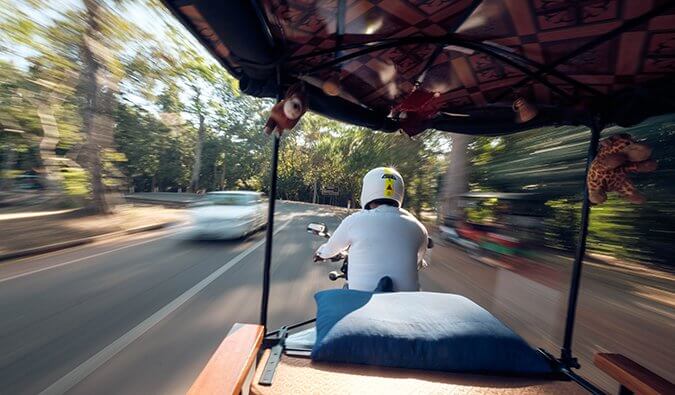
Get my best stuff sent straight to you!
Pin it on pinterest.

Top 19 Things to Do and Places to Visit in Manila City The Philippine Capital & Nearby

- 1. Travel Back in Time at Intramuros
Fort Santiago
Manila cathedral, san agustin church, plaza de roma, casa manila, baluarte de san diego, bahay tsinoy, 2. visit rizal park, 3. explore the national museum complex, national museum of fine arts, national museum of anthropology, national museum of natural history, national planetarium.
- 4. Have a Food Trip at Binondo
- Binondo Church
5. Shop Until You Drop in Manila Stores
Greenhills shopping center, tiendesitas.
- SM Mall of Asia
SM Megamall
6. pray at quiapo church.
- 7. Hop-On Board the Unique Modes of Transport
8. Enjoy a Visit to The Ocean Park
9. spend a day at roxas boulevard, cultural center of the philippines complex, bsp money museum.
- 10. Marvel at the Malacañang Palace
11. Explore the Modern Cities of Manila
Bonifacio global city, taft avenue, 12. get artsy at cubao expo, 13. visit paco park and cemetery.
- 14. Enjoy the Nightlife
Bonifacio Global City (BGC)
Tomas morato, 15. have a gastronomic food trip, maginhawa street.
- 16. Join the Weekend Markets
Salcedo Market
Legazpi market, mercato centrale, 17. visit fun modern museums, the dessert museum, lakbay museo (permanently closed starting july 2022), art in island, upside down, mind museum, 18. explore university campuses, the university of the philippines-diliman, the university of santo tomas, 19. join a day trip from manila.
- Mt. Pinatubo
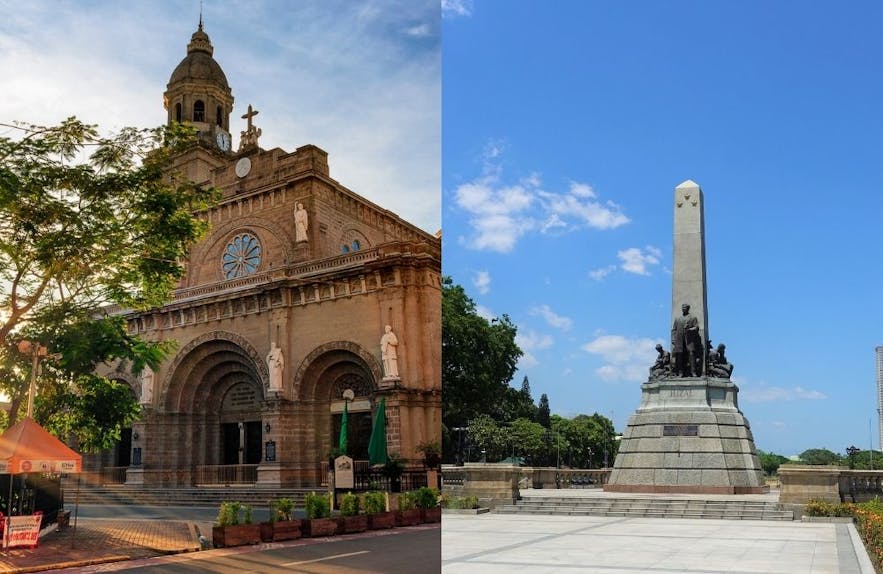
Discover Manila's lovely and vibrant city. Find out the best places to visit, the local delicacies you should try, and the different modes of transportation when visiting the metro.
The Philippines' capital city, Manila , is often the jump-off point to the country's incredible beaches, stunning islands, and unique natural wonders. However, there are many tourist spots to visit in Manila itself! It's a beautiful city full of surprises and amazing things to try.
See our popular Manila Tours & Activities
Manila intramuros historical express 90-minute tour in eco-friendly bamboo bike + optional upgrades, manila binondo shared walking food tour with guide, manila intramuros shared half-day walking tour with guide.
- Check out our article on Instagrammable cafes in Manila
For first-time visitors, Manila may seem overwhelming to explore. But it's quite manageable once you have a well-planned travel itinerary. You can also book a car rental in Manila if you want to explore at your own pace. Just make sure you have the requirements to rent a car in the Philippines .
- Find the best Manila hotels that you can book
- Book your flight ticket to Manila
You're bound to fall in love with Manila thanks to its interesting tourist spots, foodie destinations, and fun activities. Read on to find out the best things to do and places to see in the bustling capital of the Philippines and its neighboring cities:
1. Travel Back in Time at Intramuros
Intramuros , known as the "Walled City," is the oldest district and historic core of Manila. Intramuros tours are a must-try for history buffs because there are so many things to do in Intramuros .
This iconic Manila landmark is actually a walled area within the modern city. It was the seat of government and political power when the Philippines was still under Spanish rule.
Intramuros is Manila's only district where travelers can see complete architectural remnants of the Spanish Era. A day trip to Intramuros is enough for you to go sightseeing in this well-preserved historical attraction.
- Check out this San Agustin Church to Manila Cathedral tour
Wander along paved roads and visit historical monuments and sculptures. You can even join a bambike tour (you will explore via a bamboo bike), try riding a kalesa, or enjoy a horse-drawn carriage experience. Here are some of the must-visit attractions in Intramuros:

It's one of two significant squares in Intramuros. The plaza is regarded as the area's center of trade during the colonial past.
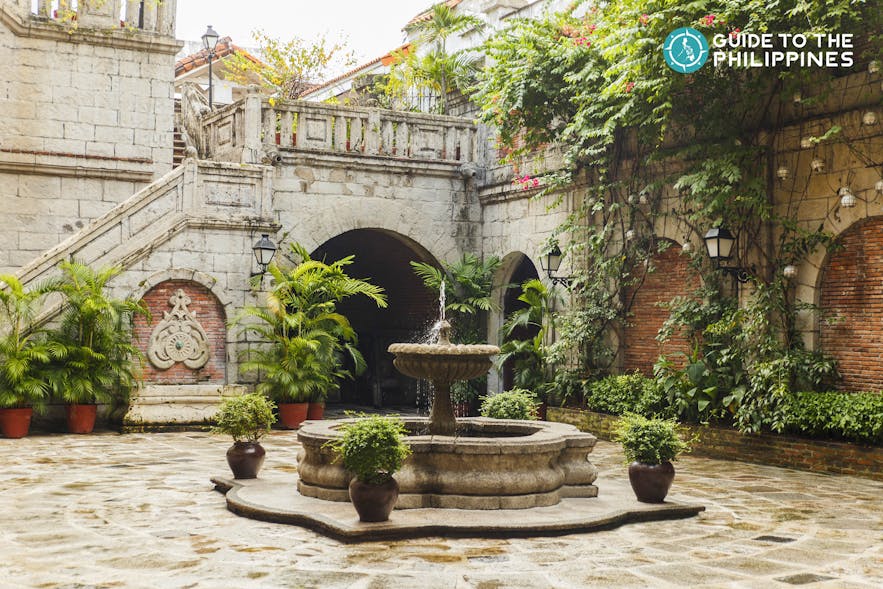
This building houses the Kaisa-Angelo King Heritage Center, a museum that documents the history, lives, and contributions of Chinese ethnicity in Philippine life and history.
See our popular Intramuros Tours
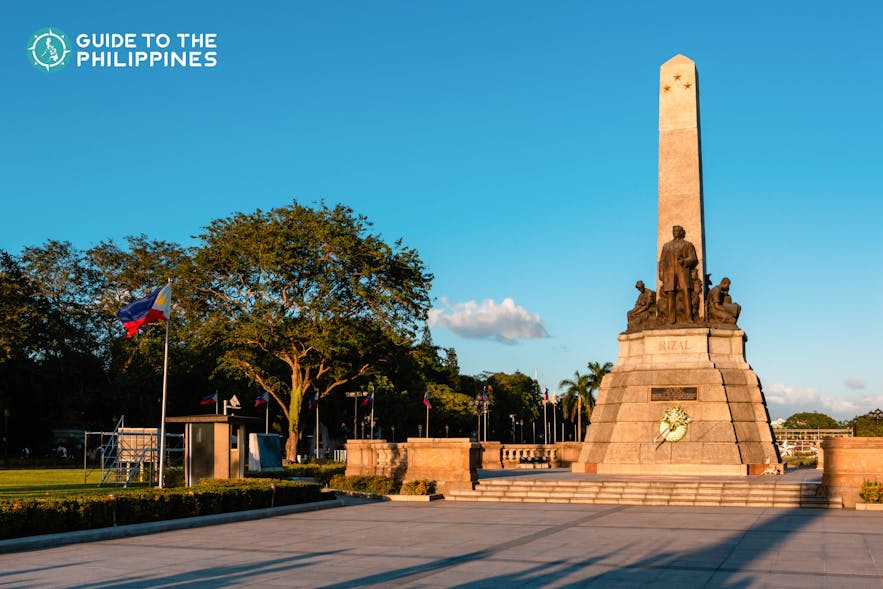
He was a doctor and novelist who was shot by firing squad at this site on December 30, 1896, on charges of fostering local rebellion against the Spanish government.
Rizal Park features monuments, squares and gardens, large stadiums, observatories, an open-air concert hall, sound and light theaters, shops, food kiosks, playgrounds, and many fountains.
The park is split into three areas, starting with the 16-hectare Agrifina Circle adjacent to Taft Avenue. It's where the Department of Tourism and the National Museum of Anthropology are situated.
Then there's the northeastern segment; followed by the 22-hectare park extending down to Roxas Boulevard. Lastly, the central section finishing at the southwestern part contains Burnham Green. Join a Rizal Park tour with Intramuros to get a full experience of this destination.
The National Museum of the Philippines has several sections included in National Museum trips: Art, Anthropology, Natural History, and the Planetarium.
All are within the same building complex and are home to permanent collections representing the various facets of art, culture, and history of the country. Joining a National Museum tour will take you around the best museums in the area.
The collection here contains both classical and contemporary Filipino paintings and sculptures. The famous paintings by the Philippine revolutionary artist Juan Luna, including The Spoliarium, are a must-see.
It features collections of artifacts of Anthropology and Archaeology. You can also have a look at the old Philippine script called "Baybayin," as well as a collection of cultural memories from native people throughout the nation.
This museum presents the rich biodiversity of the country, including Lolong's skeleton, which used to be the world's largest caught crocodile and placed in captivity. Another highlight is The Tree of Life, a glass elevator and a canopy-inspired roof.
It contains astronomic displays of celestial bodies and their real-life projections. They also offer displays, presentations, and demonstrations for travelers who would like to have a unique planetarium experience.
See our popular Museum Tours
Cebu city & lapu-lapu city top heritage attractions tour with transfers, private baguio city culture tour with snacks & hotel transfers, aklan calawag mountain resort & tibiao museum tour with lunch & transfers, 4. have a food trip at binondo .
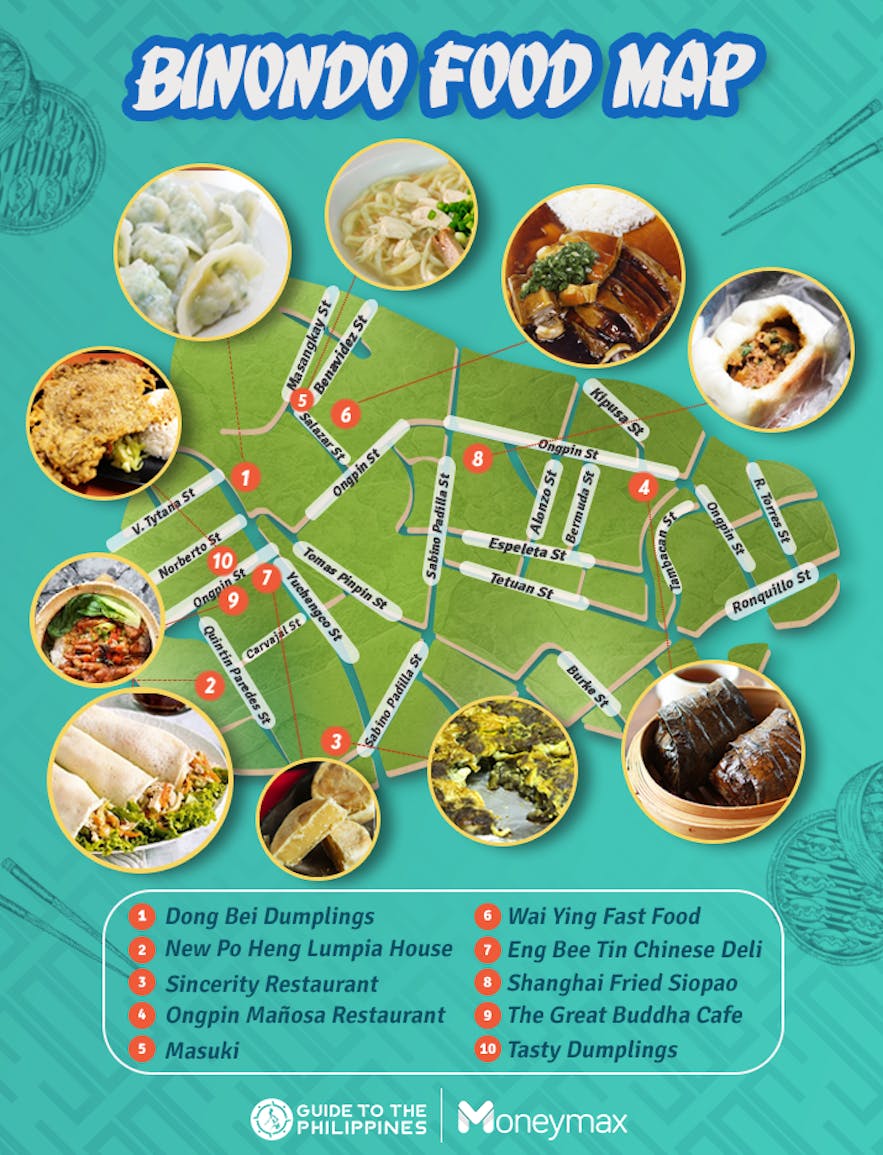
Binondo is a lively and historic Manila site. It was founded in 1594 and is considered to be the world's first Chinatown. Like the other Chinatowns, tours to Binondo restaurants are fun as the town is made up of tight and vibrant alleys with must-try foodie spots.
It is packed with hole-in-the-wall joints, traditional bakeries, and budget-friendly streetside shops. One of the best ways to see its beauty is by trying out a guided tour in Binondo .
See our popular Binondo Tours
Binondo church .
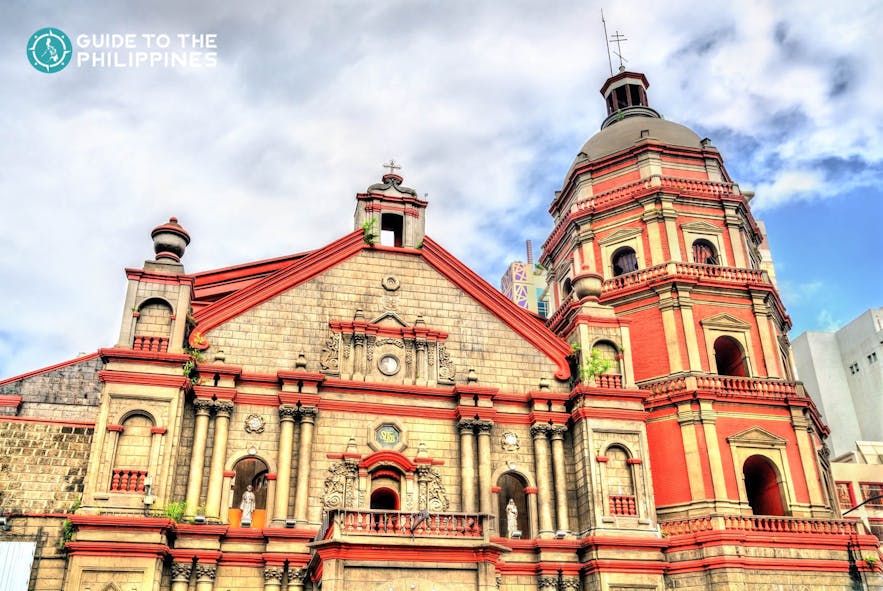
Mass generally takes place in English, Tagalog, and Chinese in this church. The church is also called the San Lorenzo Ruiz Basilica Minor.
Escolta
This used to house the stores of Chinese merchants during the galleon trade in Manila.
Food Trip
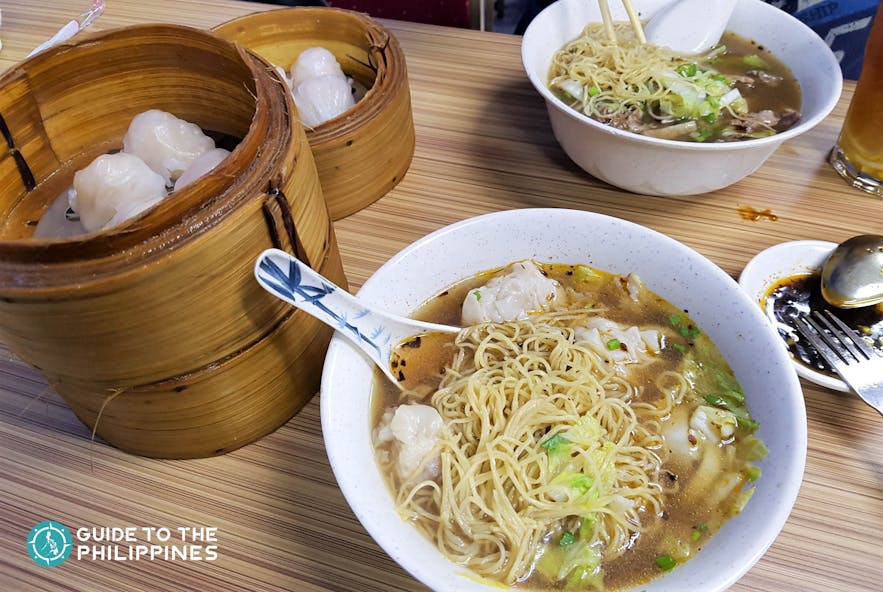
Shopping is one of the most enjoyable activities in Manila because of the multitude of malls here. Here are some of the best places to shop in the metro:
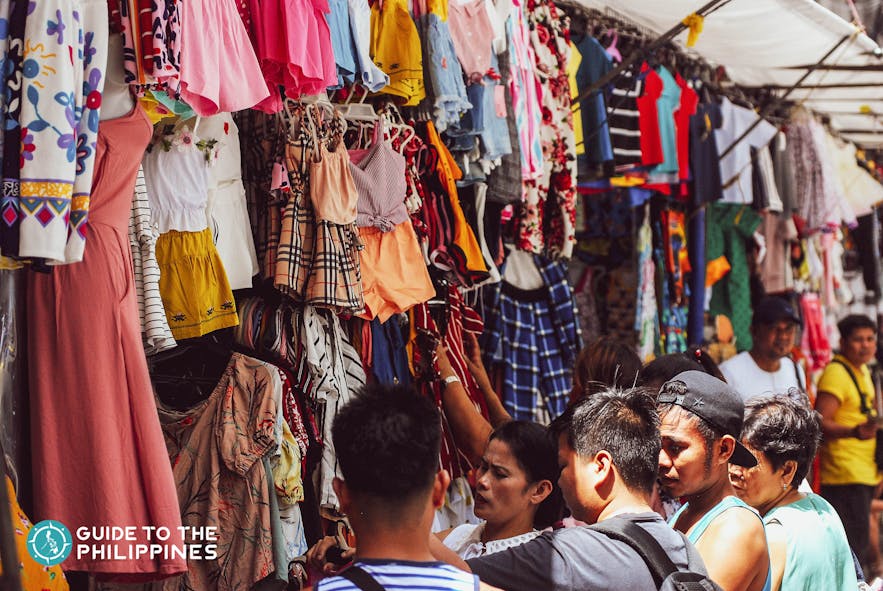
There are a lot of shops in Quiapo. For gadgets, you can go to Raon and Hidalgo Street. For arts and handicrafts, you can go to Palanca Street and Plaza Miranda. Go to Quinta Market and Carriedo Street for other necessities.
They have a big market. You can look through so many shops and stores. The stores have a variety of products, from very affordable to more costly.
It's a charming shopping mall and has a mix of thrift stalls and significant shops. There are also excellent restaurants around.
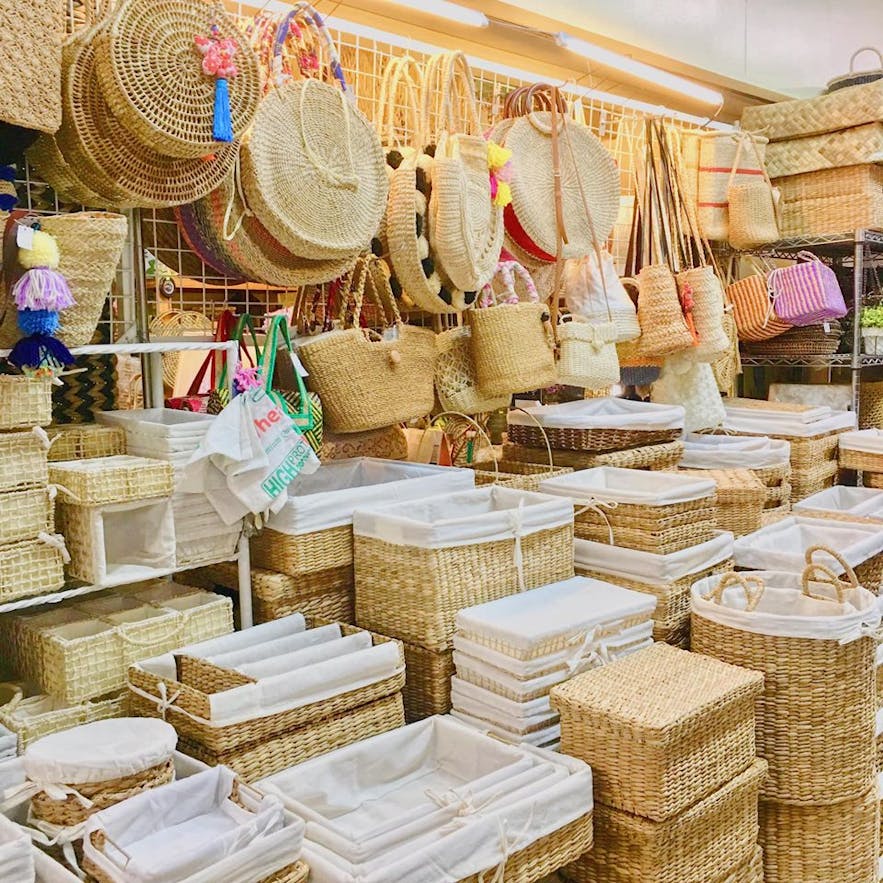
This place in Pasig City has it all, from indigenous cuisine and fashion to furniture, antiquities, arts and crafts. Tiendesitas has shops from over 450 merchants, most of whom offer specialty goods, mainly from Luzon, Visayas, and Mindanao.
SM Mall of Asia
SM Mall of Asia, or MOA, is particularly famous for both domestic and international visitors. It is the biggest shopping center in the Philippines and has several establishments. It's often part of a bargain shopping experience in Manila.
- Book a Gootopia 1-hour pass
- Make your own desserts with a Bakebe day pass
It's the third-largest shopping mall in the Philippines. Aside from their various stores in the different buildings, they have their own Mega Fashion Hall.
The establishment combines high-end boutiques, restaurants, shopping amenities, leisure areas, and entertainment halls.
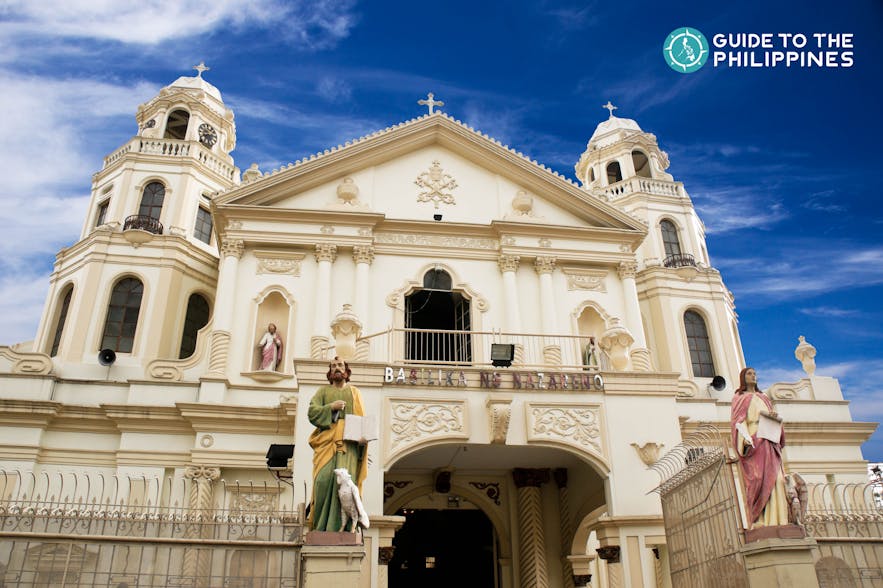
The façade of Quiapo Church, built in the baroque style, stands out from both sides with its rolling towers. A third of its column twists close to the foundation, while the bottom part has a soft surface.
The top of the four-story bell towers is adorned with balustrades and enormous scrolls. It’s a popular church included in most pilgrimage tours in the country.
In the early 1980s, a four-foil window in the center of the front of the church was screened, and a picture of the pope's crossed keys and tiara was substituted. Only the facade and the transept dome maintained the classic architecture with its latest refurbishment.
7. Hop-On Board the Unique Modes of Transport
There are distinctive transport modes that you can use to discover Manila . Jeepneys and tricycles are two of the most common transportation vehicles used by locals.

Inaugurated in March 2008, the park is famous for the Oceanarium, which has around 14,000 creatures belonging to around 277 different species native to the Philippines and Southeast Asia. A Manila Ocean Park ticket will allow you to see the Oceanarium and other park facilities.
The park is also highly informative and instructional, especially for sightseeing activities. If you want a hassle-free experience, you can book a 2-day Hotel H2O staycation package with a Manila Ocean Park day pass .
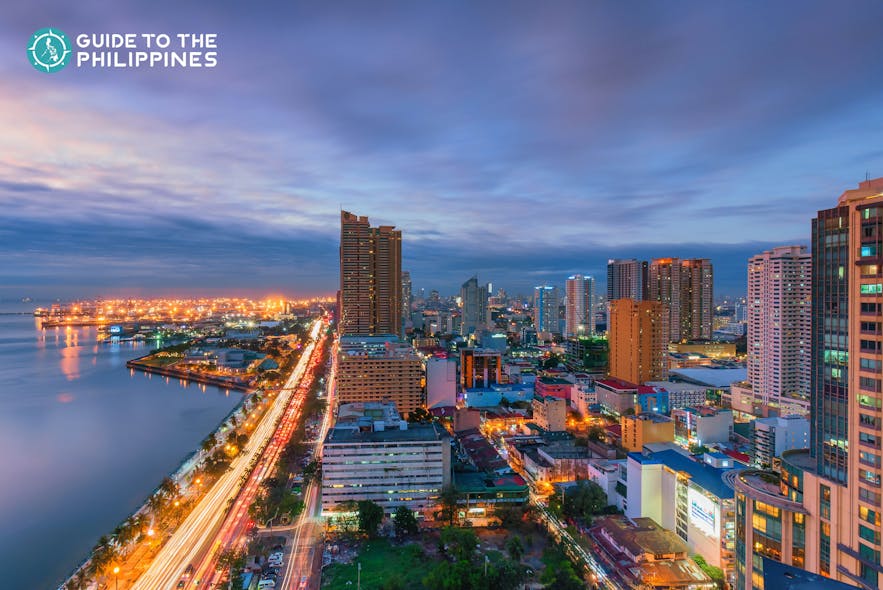
It has become famous for its country club, restaurants, eateries, commercial properties, parks, and gardens. It's also the location of the CCP Complex, Baywalk, Star City, and the BSP Money Museum.
The CCP Complex is an 88-hectare sport, cultural, and art playground. The National Theater, Folk Arts Theater, CCP Library and Archive, Philippine International Convention Center, and Manila Film Center can be found in the complex.
It's a promenade facing Manila Bay. The Baywalk is a two-kilometer path that starts at the US Embassy, and is close to Rizal Park and the Cultural Center of the Philippines, just past Manila Yacht Club.
The BSP Money Museum, located in central Bangko in the Philippines, shows the development of the Filipino economy and its past.
The displays are chronologically arranged from the Pre-Hispanic Period, Spanish, and Revolutionary Periods to the American, Japanese, and present-day Republic.
The museum is full of elegant barter coats, gold rocks, gold barter chains, old paper money, envelope bills, and silver banknotes.
See our popular Manila Vacation Packages
Family-friendly overnight lime resort manila staycation with buffet breakfast & dinner, enriching 10-day nature & heritage tour package to cebu, bacolod, negros & iloilo from manila, fancy 3-day crimson hotel alabang package with daily breakfast & one-time dinner, 10. marvel at the malacañang palace.
Malacañang Palace is the official building and principal department of the President of the Philippines. It's connected to Mendiola Street in San Miguel, Manila.
Malacañang includes many mansions and departments, primarily built in a neoclassical style. Among the many heritage trips in the country, visiting Malacañang Palace is one of the most recommended.
Originally built as a private household home, Malacañang has been transformed into a magnificent Spanish colonial home. It consists primarily of wooden buildings complete with courtyards and azoteas.
Visiting Malacañang Palace is a great opportunity to learn more about its contribution to the country’s history.
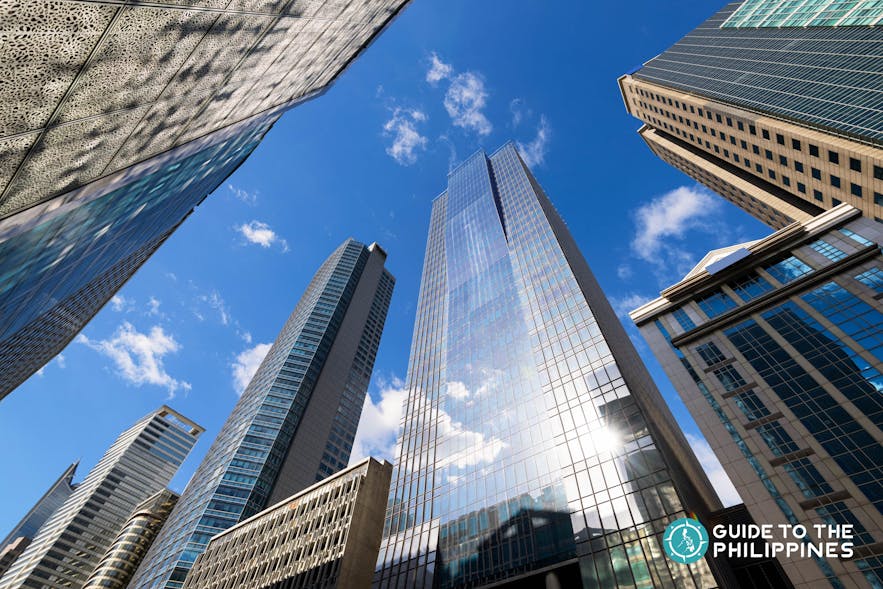
- Poblacion Makati rooftop hopping
- Poblacion Makati street party
- BGC game night
- Binondo Manila basic photography lessons
- Korean culture experience in Quezon City
There's much to learn from the remnants of the past and how it's incorporated into the present, which is why it's also great to join a Manila tour with modern and historical attractions . After all, the Philippines is a progressive country. Here are some of the modern cities of Manila you can visit during your trip:
In addition to being one of the significant financial, academic, and business institutions in all of Asia, it is the economic core of the Philippines.
- Book a Sentro Spa massage in Manila
More known as BGC, it's a leisure district in Metro Manila. Besides the tall buildings, you'll also see high-end retail stores here. You can dine in world-class hotels and restaurants and be amused by several activities.
It's primarily considered to be a component of the University Belt, with several of Manila's leading colleges and universities nearby.
This, plus its closeness to primary forms of travel, provides Taft Avenue, the youthful atmosphere and accessibility it is known for.
Cubao Expo has housed aesthetic institutions, art galleries, thrift stores, and shoe shops for several years. One may lose oneself among vintage comics, knick-knacks, and unique finds in this place.
Cubao Expo also serves as a lifestyle center. Here you will discover a handful of options for lunch or dinner. The place also hosts events such as poetry reading, book sales, concerts, and different kinds of conventions.
Paco Park is a leisure and nature park that was constructed by Dominicans in the Spanish colonial era. It is on the main street of General Luna in Paco, Manila and the eastern part of Padre Faura Street.
During the reign of President Diosdado Macapagal, the reserve was transformed into a national park in 1966. Since then, the park has been progressively rebuilt and has been a government beach and community promenade.
14. Enjoy the Nightlife
Filipinos love to party! With their passion for singing and dancing coupled with excellent humor, you're bound to encounter some exciting and enjoyable events when visiting Manila's hot nightspots.
- Crimson Hotel Manila package
- Ascott Bonifacio Global City Manila package
- Ascott Makati package
- Somerset Millennium Makati package
- Somerset Central Salcedo Makati package
- Somerset Alabang Manila package
- Citadines Salcedo Makati package
- Citadines Bay City Manila package
- The Belamy House Makati Manila hotel package
- City Garden Hotel Makati package
There are various places throughout Manila, Makati , and Quezon City , where you can encounter all types of bars and restaurants to eat, drink, and chill at. Naturally, it's based on whether you want something lowkey or a full-on club scene. Here are some locations you should visit:
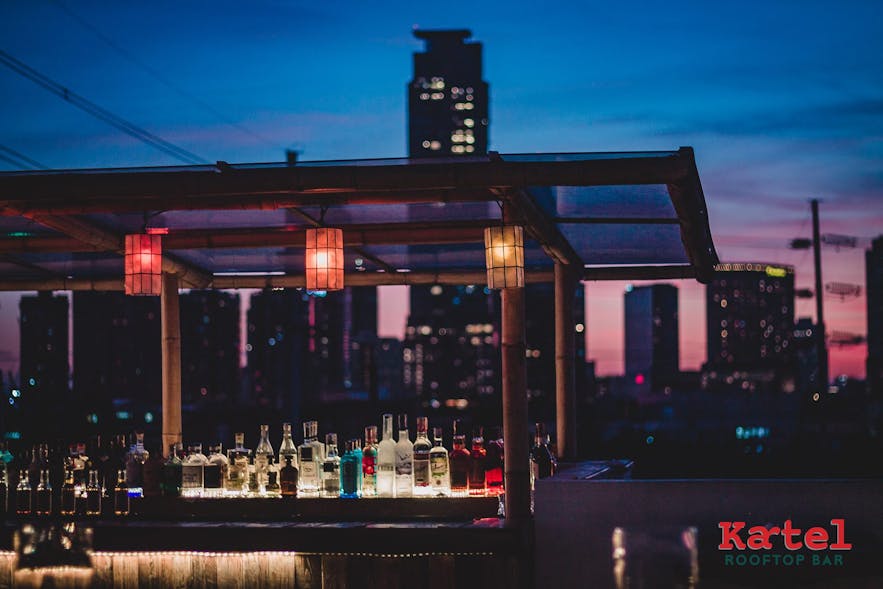
This is Makati's famous nightlife district, with a wide variety of beautiful hotels and bars to let individuals unwind from stress. Visiting this area is one of the fun activities in Makati .
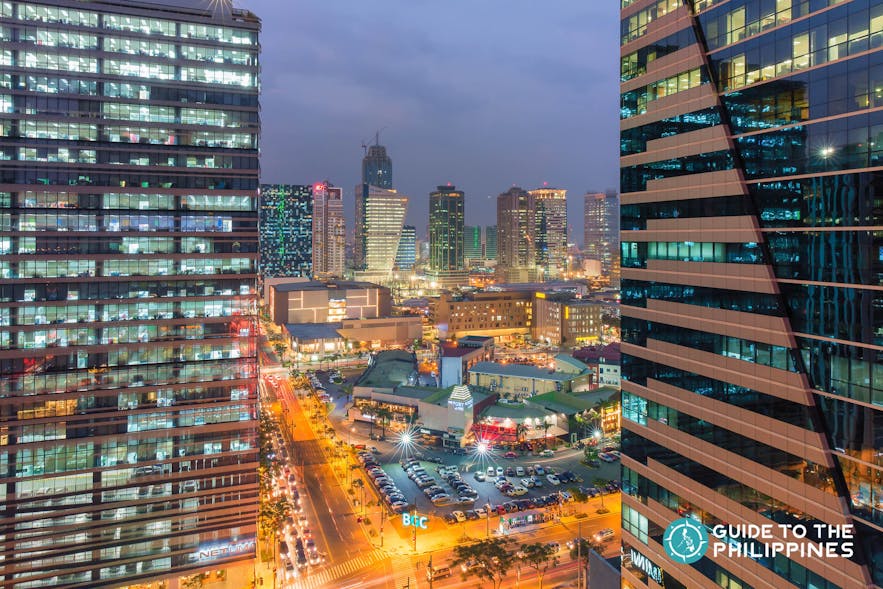
This is a famous place for amusement. There are many fine establishments and cafes along this street, including discotheques, karaoke joints, and comedy clubs.
One of the best things to do in Manila is to have a gastronomic adventure, and what better way try local cuisine than going on food trips ! Try street food such as the infamous balut.
- Read our article on the best buffets in Manila
There are also fish balls, kwek-kwek, kikiam, taho, and sorbetes that are generally marketed in tiny shops.
Try halo-halo, a famous Filipino dessert of shaved ice and evaporated milk, with several other components, for a delicious snack. Aside from Binondo, you can have a local food trip here:
Several local restaurants started on this 2.2-kilometer road as hole-in-the-wall food places before becoming increasingly popular due to locals loving the vibrant and trendy atmosphere.
This is the name of Makati's famous food trucks. They're affordable and found within area points in Makati. Local favorites are Sisig from Rada Street, Mang Lirio's from Palanca Street, and Bulalo and Pares from Esteban Street.
This is an area renowned for its charming and eclectic vibe. Kapitolyo has two primary roads. East Drive features cheaper, more inexpensive establishments, while West Drive offers more intimate date places and unique events.
16. Join the Weekend Markets
If you get excited about shopping for local products, an excellent activity is to join a city excursion at a weekend market in Manila !
Sample a combination of delicious meals and Philippine cuisine, observe local entrepreneurs selling products, and discover unique things visiting a weekend market, like those listed below:
This weekend market starts at 6 AM on Saturdays. There are delicacies from all over the world so that you can enjoy distinct global flavors as well as local culinary delights.
This market is available only at 7 AM on Sundays. What's unique about this market is its dry goods stalls. You can purchase many artsy items, from pictures to hand-crafted products.

This food night market is available during scheduled evenings in Makati, Pasig, Intramuros, and Rizal Park. You'll discover an enormous range of meals and snacks you can consume. Wash it down with your choice of drink.
Modern museums should be on your list if you're the type of traveler who wants to experience something new. It's a way for curators to present artwork in a different form. Here are some museum trips you can try in Manila:
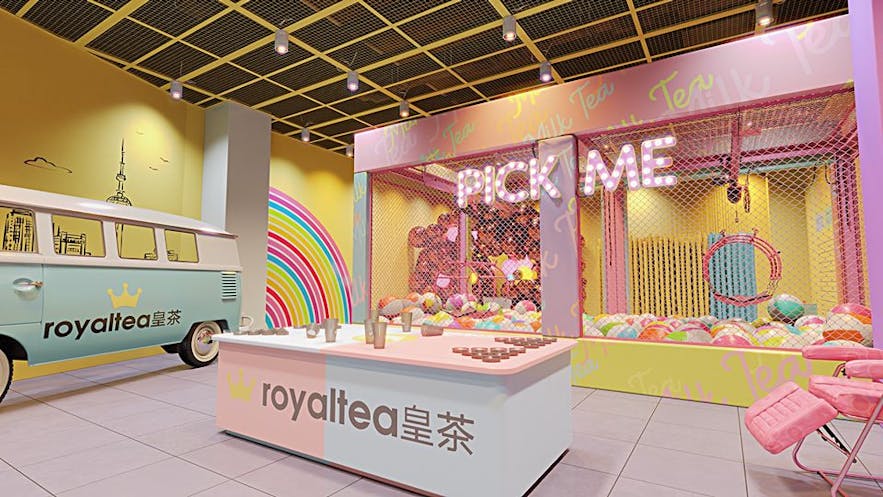
This is a great spot to see desserts, eat them, and take unique pictures as well. Buying an admission ticket to the Dessert Museum is worth it as it's different from other museums.
- Book a 2-hour Dessert Museum Ticket to 8 Themed Rooms & Complimentary Dessert
- See our other Philippine museum day passes

Art in Island, one of the world's largest animated 3D art museums, enables visitors to take beautiful photos with wall-to-floor sculptures. The employees can take your image as you give your best poses in each of the 12 areas.
If you like to take pictures in a unique manner, this museum will definitely surprise you. Discover creativity within yourself when you transform your pictures upside down.

The Philippines doesn't fall short of beautiful universities. These locations are not only home to academic institutions but are also notable Manila destinations.
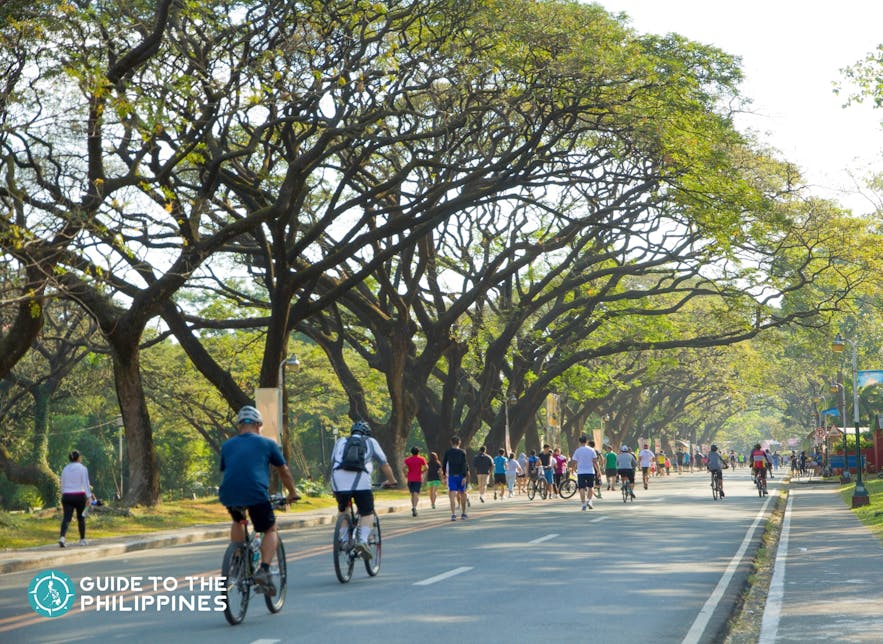
The University Academic Oval is a circular street lined with buildings with different architecture and shaded by a canopy of acacia trees. The University of the Philippines also has its own UP Cine Adarna next to the UP Theater and the UP Carillon tower.
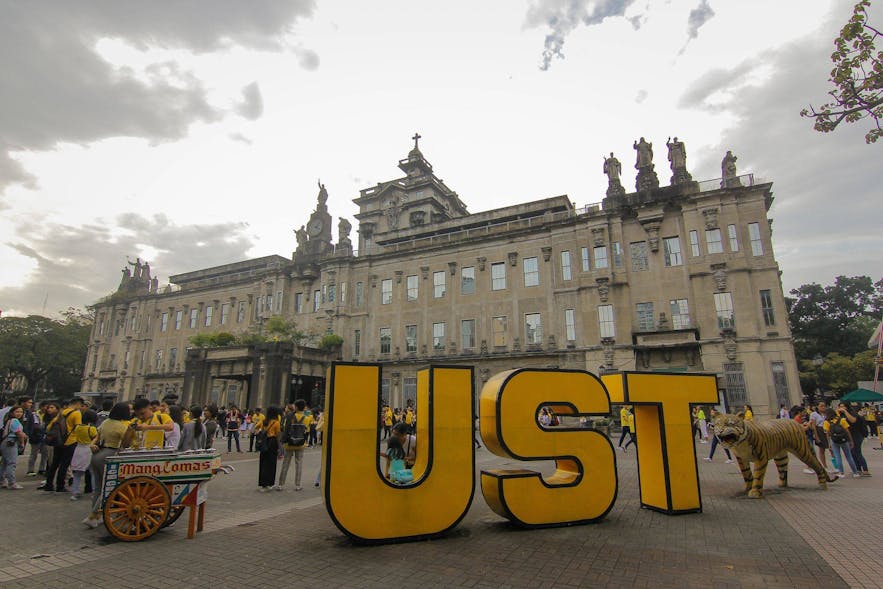
Known as one of Asia's oldest universities, UST has a wealthy heritage visible on its campus. There is even a magnificent museum full of memorabilia and pictures here.
After enjoying tours in Manila , you can venture out to nearby provinces. Whether you're a traveler wanting to discover more places beyond the metro or a local who wants to take some time off from the city, these are some great options:
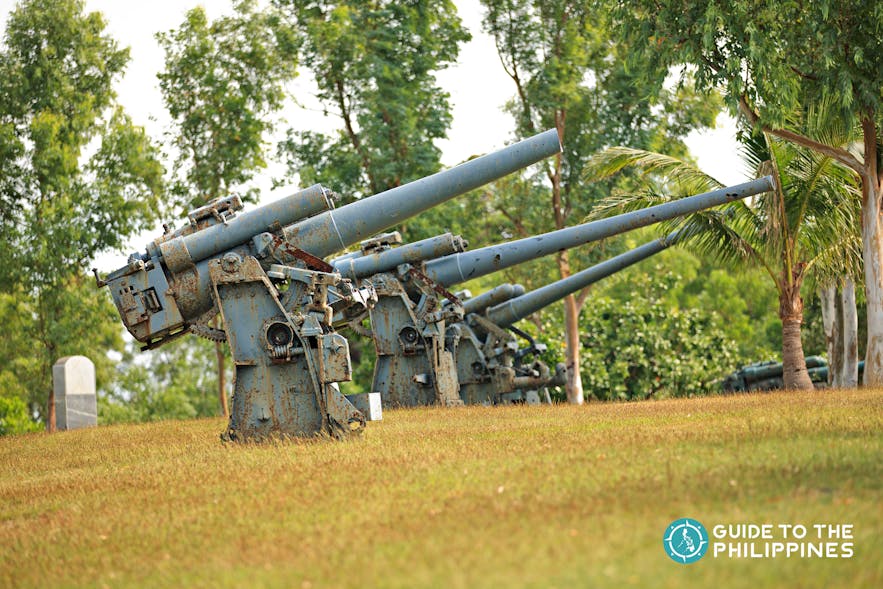
It's best to join a Corregidor experience to fully immerse yourself in this breathtaking piece of history.
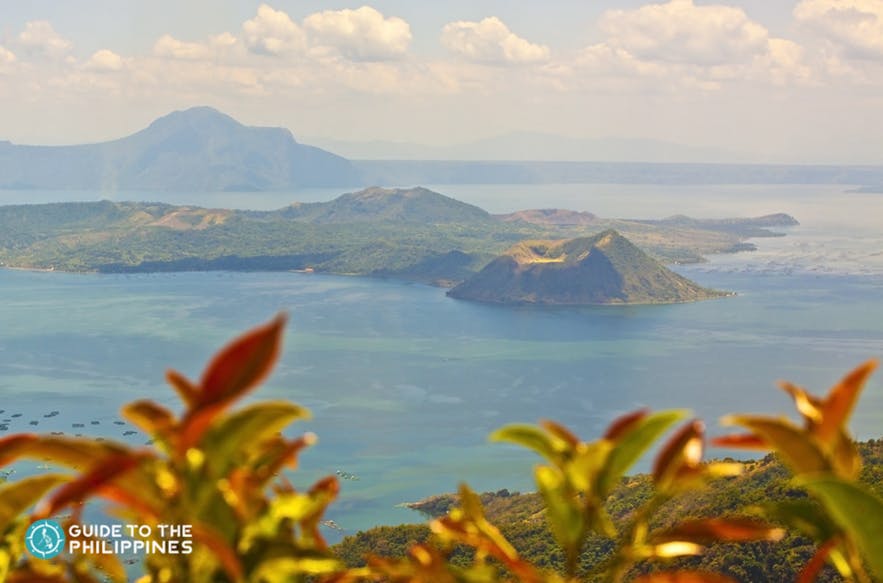
See our popular Tagaytay Tours and Activities
Tagaytay palace in the sky taal view & farms shared day tour with lunch & transfers from manila, tagaytay city sightseeing shared day tour with transfers from manila | picnic grove, twin lakes, coffee farm tour at amadeo cavite near manila & tagaytay with live brewing & tasting sampler.
This is the Philippines' third-largest lake. Taal Volcano, one of the smallest active volcanoes in the globe, is inside it. Make sure to enjoy and take photos of this fantastic destination.
Mt. Pinatubo
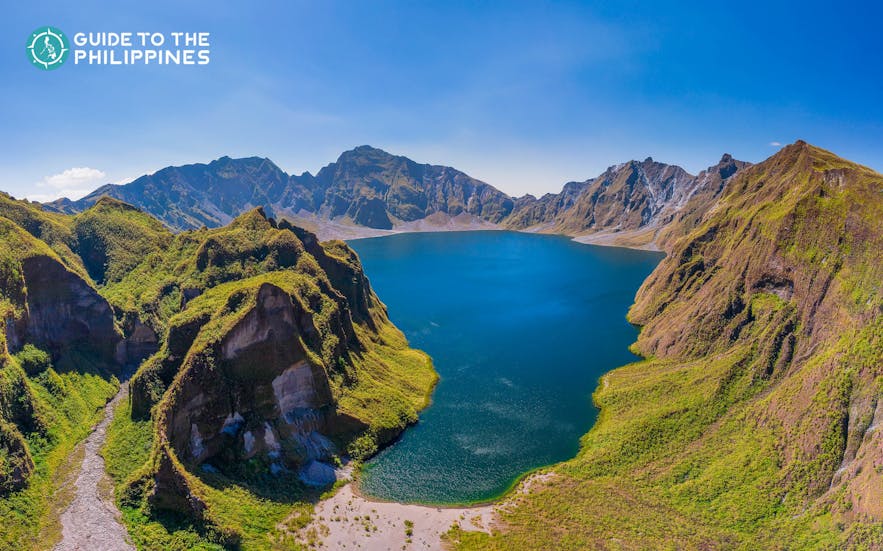
See our popular Mount Pinatubo Tours
Exciting 2-week history & adventure tour package to ilocos, mt. pinatubo, baguio & sagada, amazing 2-week heritage & scenic tour package to llocos, mt. pinatubo, baguio, sagada & bohol, exhilarating 10-day hiking adventure package to pampanga, cebu & baguio from manila.
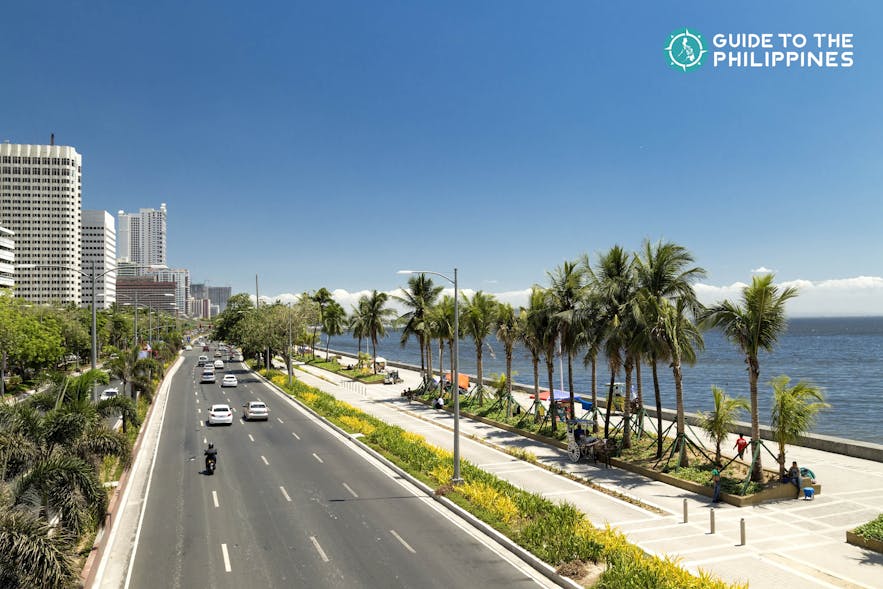
- Cebu to Manila flights
- Davao to Manila flights
- Tacloban to Manila flights
- Iloilo to Manila flights
- Bacolod to Manila flights
- Legazpi to Manila flights
- Boracay to Manila flights
- Bohol to Manila flights
It offers so many great things for both locals and internationals alike, such as sightseeing tours, food and culinary trips, museum-hopping excursions, biking trips, historical and heritage immersions, adventure and nature park visits, and hiking excursions.
Start planning your trip to Manila now! Explore Manila tours and activities that you can add to your itinerary for a complete and hassle-free travel experience.
Popular articles

Best Palawan Guide: Top Tours, Where to Stay, How to Get Around
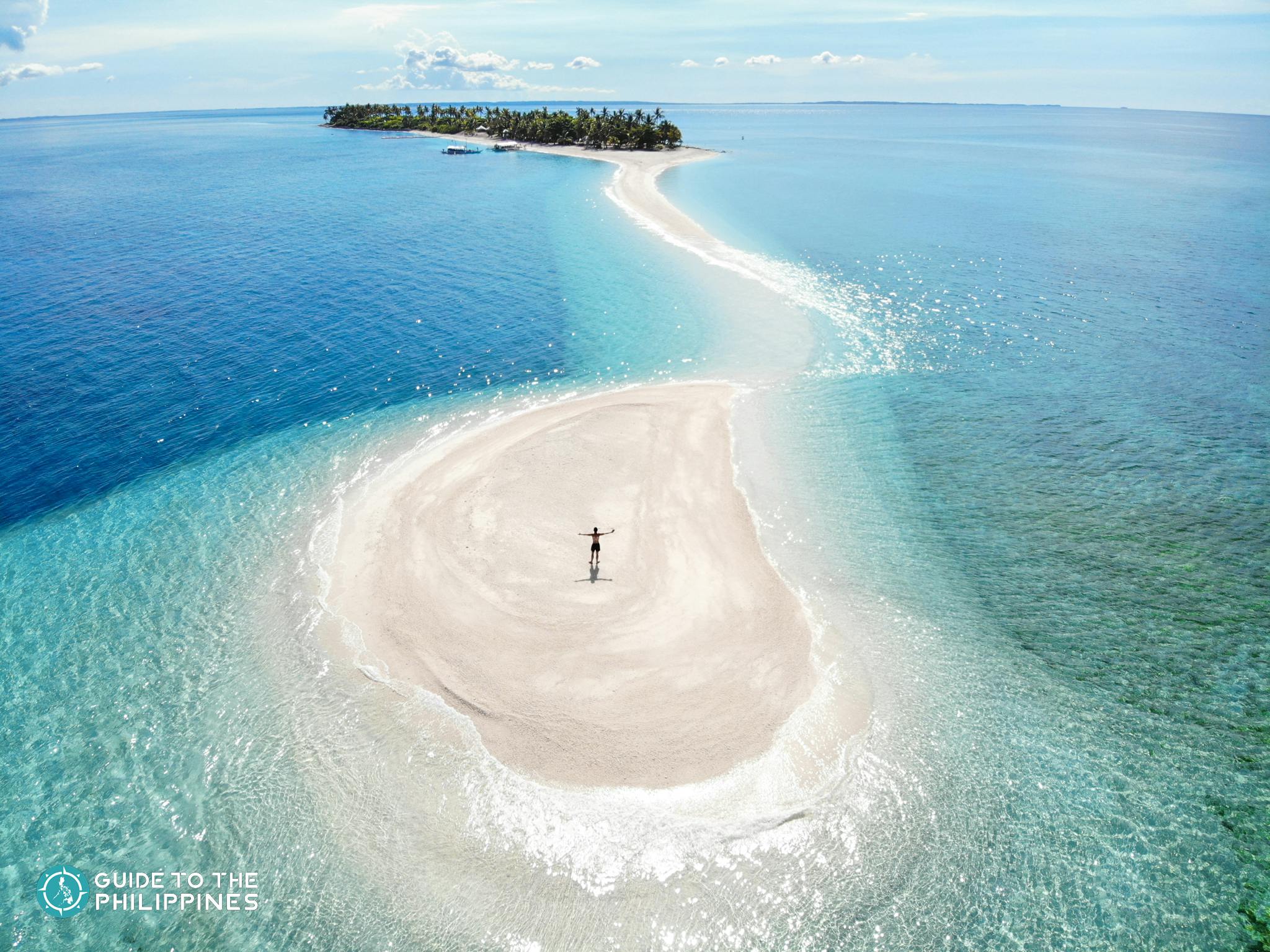
20 Most Beautiful Sandbars in the Philippines: White Sand, Longest, Vanishing
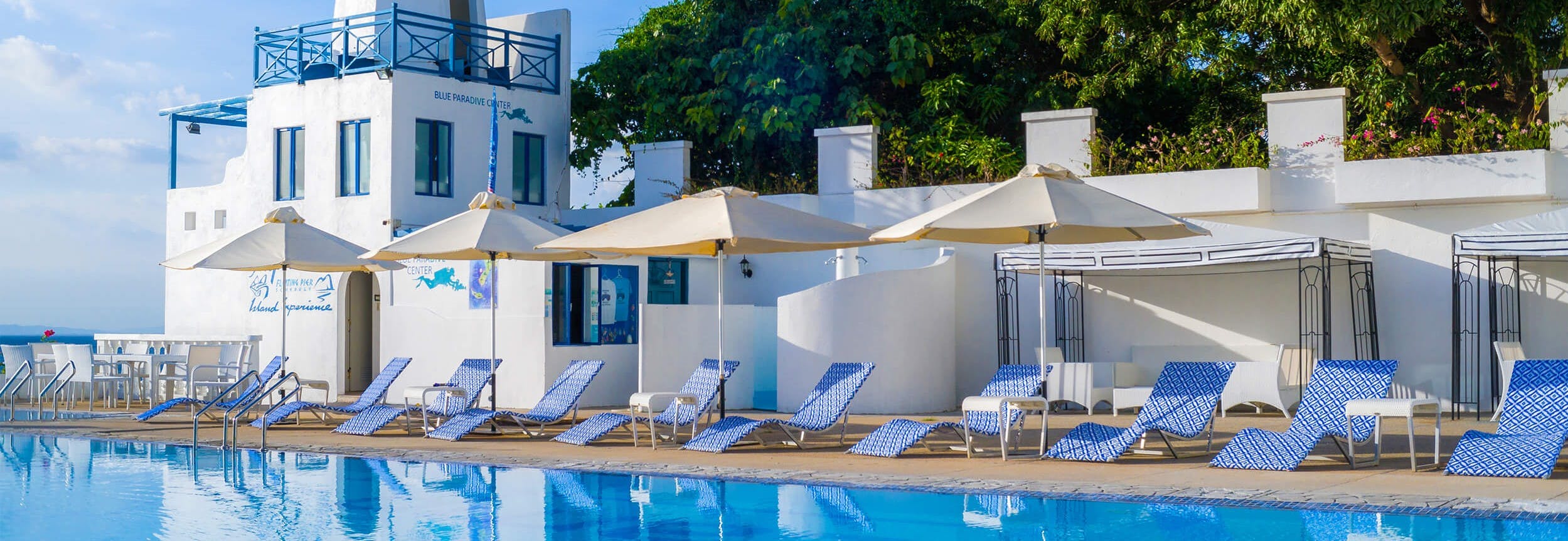
11 Best Santorini-Like Resorts in the Philippines: Near Manila, Cebu, Palawan, Vigan
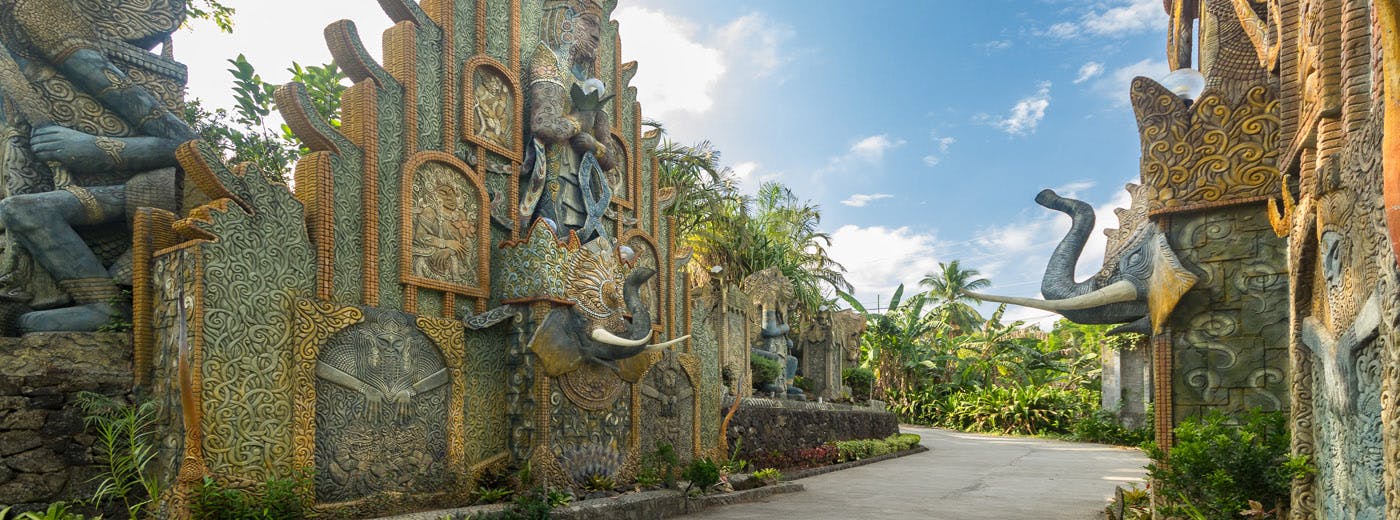
15 Best Tropical Bali-Like Resorts in the Philippines: Near Manila, Siargao, Cebu, Bohol
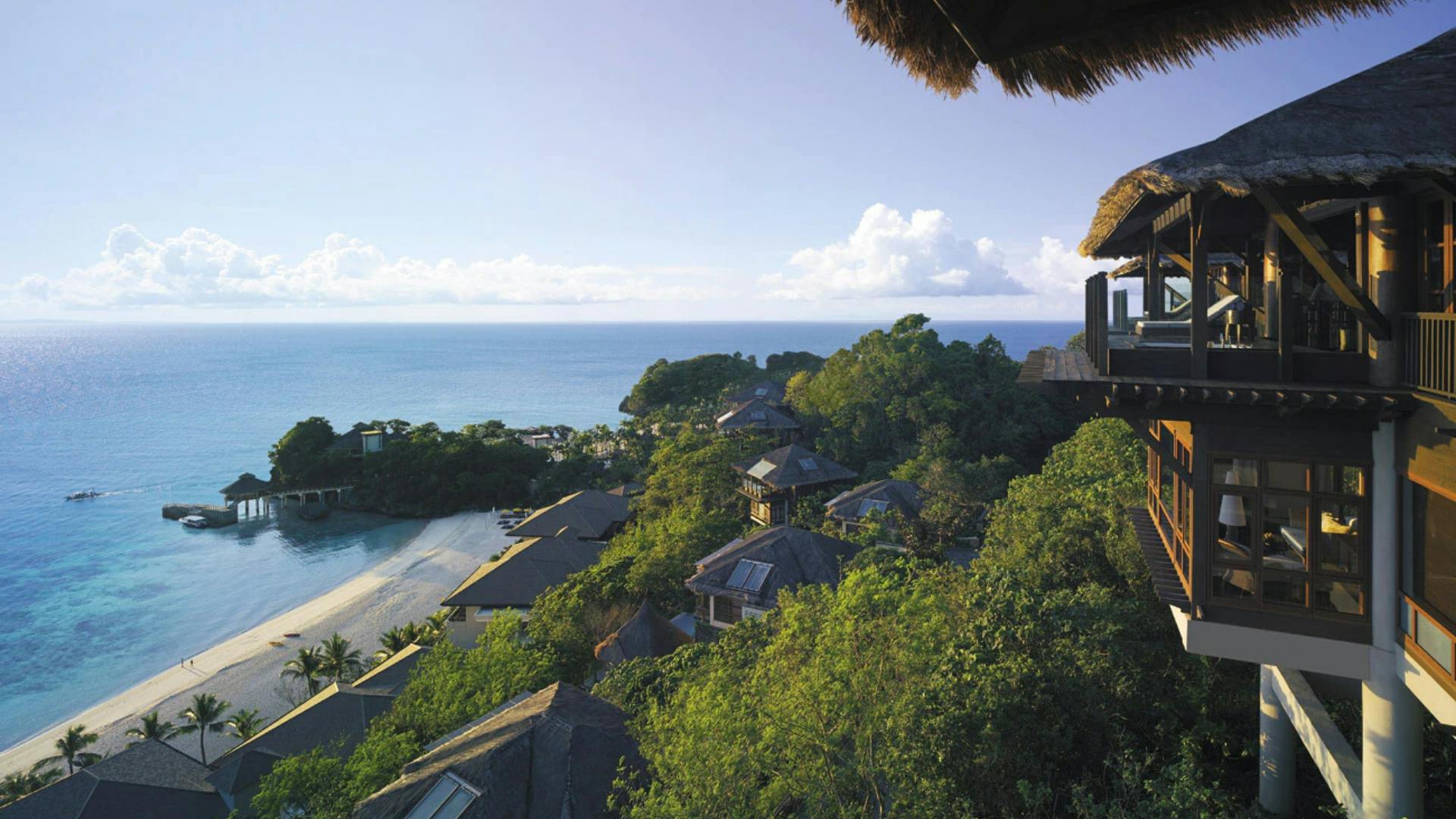
10 Best Treehouse Resorts in the Philippines for a Scenic Getaway at Mountains, Beaches & Rivers
Other interesting articles.

Cruise Ports in the Philippines: Nearby Attractions & Must-Try Tours for Shore Excursions
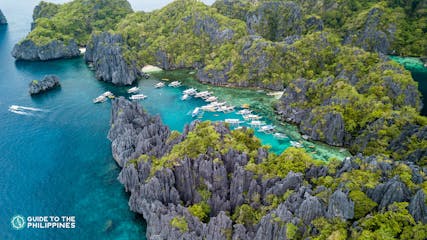
Top 14 El Nido Palawan Activities and Tourist Spots: Stunning Beaches, Islands & Lagoons
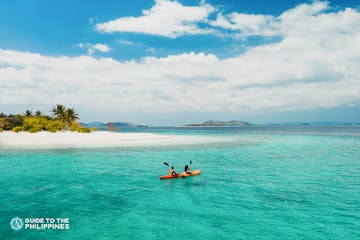
19 Most Romantic Destinations in the Philippines
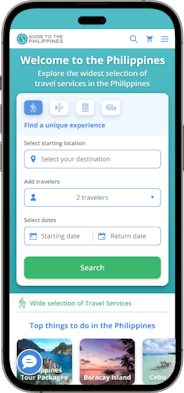
Download the Philippines’ biggest travel marketplace to your phone to manage your entire trip in one place
Scan this QR code with your phone camera and press the link that appears to add the Philippines’ biggest travel marketplace into your pocket. Enter your phone number or email address to receive an SMS or email with the download link.
Top things to do in the Philippines
Discover all the adventures you can experience in the Philippines
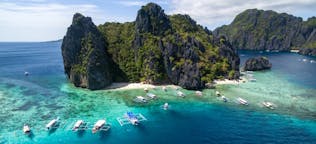
Philippines Tour Packages
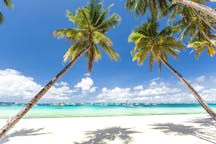
Boracay Island
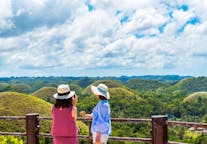
Bohol Island
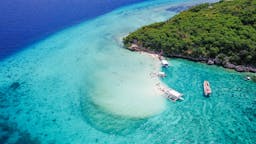
Cebu Island
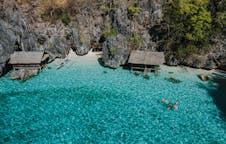
Coron Palawan
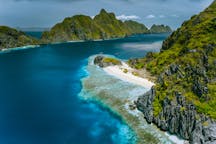
El Nido Palawan
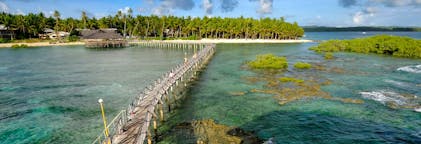
Siargao Island
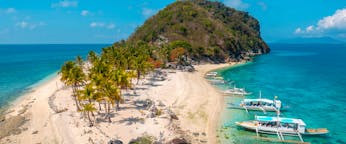
Iloilo City and Nearby
MANILA TRAVEL GUIDE with Travel Tips and Sample Itinerary
- share
- Share on Facebook
- Share on Twitter
DISCOVER MANILA: Explore with Our Expert-Curated Sample Itinerary
Table of Contents
Manila, the vibrant capital of the Philippines, offers a rich tapestry of history, culture, and modernity. It is a city where the past collides with the present; centuries-old churches and historic forts stand alongside bustling marketplaces and skyscrapers.
Manila presents an intriguing blend of experiences for travelers, from exploring the walled city of Intramuros to indulging in the culinary delights of Binondo , the world’s oldest Chinatown.

Planning a trip to this dynamic metropolis requires a thoughtful approach to cover its diverse attractions efficiently.
A strategically crafted itinerary ensures that visitors make the most of their time, whether they’re in Manila for a layover or an extended stay.
Such an itinerary might include visiting the iconic Rizal Park, a stroll through the cultural treasures housed in the National Museum, or an evening spent absorbing the Manila Bay sunset.
Tailoring a trip to personal interests is key in Manila, as the city offers varied experiences ranging from historical tours to modern shopping malls.
Engaging with the warm-hearted locals of Manila, enjoying its street food, and exploring its vibrant streets can provide valuable insights into the Filipino way of life.
Explore the vibrant city of Manila with this captivating travel guide blog! Discover everything you need to know for an unforgettable adventure in the bustling capital of the Philippines, including a detailed itinerary and breakdown of expenses.
Essential Travel Information
Before embarking on your exploration of the lively city of Manila, it’s essential to familiarize yourself with the key aspects that will ensure a smooth and enjoyable trip.
From the best time to visit to navigating the city’s notorious traffic, this section covers all you need for a well-prepared Manila adventure.
Best Time to Visit Manila
The best time to visit Manila is during the drier months, typically from January to April. These months offer more favorable weather conditions with less rainfall and are generally considered the peak season for tourism.
Although the dry season lasts from December to May, the ideal time to visit is from January to April, when average temperatures are comfortable. The best time to visit the Philippines, including Manila, is from December to February, when temperatures are around 75°F to 88°F, and the country is fully accessible, indicating that these months are also ideal for travel.

Arriving in Manila
Travelers usually arrive at the Ninoy Aquino International Airport , where one can opt for a taxi or use the ride-hailing app Grab to reach their destination in Manila.

Getting Around Manila
Traffic in Manila can be challenging, but various modes of public transport like buses , jeepneys , and the Metro (including LRT and MRT lines) are available.
For convenience, taxis and Grab are good options despite the possibility of traffic delays.
Accommodations
Where to stay in Manila ranges from luxury hotels to budget accommodations.
For backpackers, options like Z Hostel ( more info ) offer a sociable atmosphere, while areas like Greenbelt provide more upscale hotels .
Communications Tips
When communicating in Manila, it’s important to be aware of the local communication style. Filipinos tend to express their opinions diplomatically and with humility to avoid appearing arrogant. They also use a range of communication strategies, including indirect communication, nonverbal cues, and humor to defuse tension. It’s advisable to show interest in the local culture and ask questions to engage with Filipinos effectively.
English is widely spoken, making communication quite easy for travelers. It’s polite to include basic phrases, “salamat” (thank you), in interactions as a sign of respect .
Local Currency and Payments
The Philippine Peso (PHP) is the local currency.
Credit cards are accepted in most hotels, restaurants, and shopping malls ; however, having cash is essential, especially when using public transport or shopping in local markets.
Safety & Emergency Information
Manila is relatively safe for travelers, but one should exercise usual precautions and know their surroundings.
Keep emergency numbers handy and stay informed about local safety advisories.
Cultural Etiquette
When in Manila, it’s essential to observe certain cultural etiquettes. Showing respect to elders is highly valued, and using honorifics such as “po” and “opo” is customary. Additionally, maintaining eye contact during conversations is a sign of attentiveness and respect. It’s also important to avoid confrontational behavior and to express criticism indirectly to avoid causing shame to individuals or their families. These practices reflect the emphasis on harmony and respect within Filipino culture.
Filipinos are known for their hospitality. Show respect in cultural settings by dressing conservatively in places of worship and asking permission before taking photos of people.
Weather and What to Pack
The weather in Manila can be hot and humid.
Pack light and breathable clothing, a hat, sunglasses, and sunscreen. During the rainy season, an umbrella and waterproof gear are advisable.
Day 1: Historical and Cultural Treasures
Embark on a journey through Manila’s rich historical tapestry, with a day dedicated to exploring the city’s most significant landmarks and cultural heritage sites.

Morning in Intramuros
Begin the day within the storied walls of Intramuros , Manila’s oldest district and historic core. Here, visitors can traverse cobbled streets surrounded by Spanish colonial architecture .
A must-visit is Fort Santiago , a citadel used as a defensive fortress during the Spanish period.
Delve into Philippine history at the iconic Manila Cathedral , which stands as a testament to the country’s religious past.

Lunch in Binondo
Next, venture into Binondo , the world’s oldest Chinatown , for an authentic culinary adventure.
Savor a diverse array of Chinese- Filipino street food and dine at Binondo restaurants known for their delicious dim sum and noodle dishes.
Tasting the flavors here is not just a lunch break but a cultural experience linking Manila’s present to its past.

Afternoon at National Museums
The afternoon calls for a visit to several National Museums .
The National Museum of Fine Arts houses a vast collection of Philippine art, whereas the National Museum of the Filipino People offers an anthropology and archaeology perspective.
Keep an eye out for the stunning architecture and design as you explore, including the newly renovated National Museum of Natural History , which tells a rich narrative of the country’s biodiversity.

Evening Walk at Rizal Park
Conclude your day with a leisurely evening stroll at Rizal Park , also known as Luneta Park.
Overlooking Manila Bay , the park features beautifully landscaped gardens and monuments dedicated to national hero José Rizal.
Time your visit to catch the breathtaking Manila Bay sunset along the Manila Baywalk , a perfect end to a day steeped in history and culture.
Day 2: Modern Manila and Shopping Experience
On the second day of the Manila travel itinerary, visitors can immerse themselves in the dynamic atmosphere of modern Makati, indulge in a shopping spree at one of Asia’s largest malls, explore the contemporary landscape of Bonifacio Global City, and cap the night with vibrant dining and nightlife options.

Morning in Makati
Starting the day in Makati, travelers will explore the bustling streets of Metro Manila’s premier business district.
Visiting the Ayala Museum offers enriching insight into Filipino culture, art, and history.
Following the museum, a leisurely stroll through the lush gardens of Greenbelt Park to reach the Greenbelt Mall is perfect for both luxury shopping and admiring the combination of nature with sophisticated architecture.

Lunch and Shopping at SM Mall of Asia
As lunchtime approaches, tourists make their way to the SM Mall of Asia , one of the largest shopping malls in the world.
Here, one will find a diverse array of food options spanning local Filipino cuisines to international fare.
The mall’s expansive retail spaces present an ideal opportunity for shopping, with a mix of local and global brands available.
Afternoon in Bonifacio Global City
In the afternoon, Bonifacio Global City (BGC), known for its state-of-the-art urban planning, invites travelers to tour its dazzling architecture and impressive street art installations .
BGC is a striking example of modern development and a shopping haven with its array of malls and boutique stores.
Dinner and Drinks in Poblacion
As the evening settles, the district of Poblacion beckons with its eclectic mix of restaurants , bars , and pulsating nightlife .
Travelers can enjoy a variety of dining options, from local Filipino dishes to international cuisine, followed by an exploration of Poblacion’s vibrant bar scene.
Overnight in Quezon City
When the night winds down, Quezon City offers a range of accommodation options , from budget-friendly hotels to luxury stays.
Known for its own lively nightlife scene, visitors can find respite in the comfort of their chosen hotel or continue to savor the night in one of the many entertainment spots within the city.
Day 3: Beyond the City
On the final day of a 3-day Manila itinerary, travelers often seek a memorable adventure away from the metropolitan buzz. They venture to Mt. Pinatubo, where scenic landscapes and the thrill of hiking combine for an exciting day trip.

Morning Visit to Mt. Pinatubo
Travelers looking for a striking culmination to their Manila travel experience can embrace the opportunity for adventure at Mt. Pinatubo .
An early morning departure is crucial as the journey to the volcano requires a couple of hours’ drive from Manila.
A preferred destination for avid hikers, the trek to the crater lake of Mt. Pinatubo is a moderately challenging hike that offers a truly rewarding experience.
Upon arrival at the site, hikers traverse a lunar-like landscape, testament to the volcano’s historic eruption in 1991.
One should be prepared for a combination of 4×4 jeep rides across ash fields and a hiking adventure that unveils the majestic beauty of the volcano’s turquoise crater lake.
This unique destination masterfully contrasts the city’s cultural landmarks and provides a taste of the Philippines’ natural wonders.
For a thorough and seamless excursion, it is advisable to seek organized tours, which often include transportation, a local guide, and necessary permits.
The combination of surreal scenery and physical activity makes this hike an essential experience for those seeking to extend their Manila adventure beyond the typical urban attractions.
Culinary Journey Through Manila
Manila offers a vibrant tapestry of flavors shaped by Spanish, Chinese, and local Filipino influences. This itinerary promises an immersive experience into Manila’s culinary culture, from savoring street food to exploring the spirited nightlife.

Tasting Local Delicacies
The streets of Manila are a food lover’s paradise, with an array of dishes that reveal the Philippines’ rich cultural heritage.
A visit to Binondo , the world’s oldest Chinatown, leads to a gastronomic adventure of Chinese-Filipino cuisine. Here, travelers might sample lumpia (spring rolls), pancit (noodles), and sweet hopia (pastry).
For those after authentic Filipino flavors, the array of choices is diverse.
Restaurants serve classic dishes like adobo , meat marinated and braised in vinegar, soy sauce, and garlic.
A daring yet rewarding choice is balut , a fertilized duck egg known for its unique texture and flavor.
In Intramuros , the historic walled city of Manila, travelers find Spanish-influenced dishes such as the festive paella , which features a symphony of seafood, meat, and saffron rice.
An essential experience is biting into the crunchy skin of lechon , a whole roasted pig, often at gatherings and special occasions.
Experiencing Nightlife
Manila’s nightlife thrives in the districts of Malate and Ermita , where bars and pubs offer not just drinks but also the pulse of the city’s modern culture.
These areas are a blend of cozy spots, live music venues, and bustling nightclubs. Visitors might toast the evening with a cold San Miguel Beer , a favorite among locals.
In addition to libations, Malate is also a hotspot for nocturnal eats. Street food stalls and 24-hour restaurants cater to the late-night crowd, with offerings like grilled isaw (chicken intestines) or sisig , a sizzling plate of chopped pork head and liver seasoned with chili and calamansi.
Such dishes encapsulate Manila’s bold flavors and the Filipinos’ love for shared meals, any time of day or night.
Cultural and Heritage Sites
Manila, the vibrant capital of the Philippines, is steeped in history and rich in Spanish colonial architecture. Its cultural and heritage sites provide a window into the nation’s complex past.
From Spanish rule to the struggle for independence and the impacts of World War II, these landmarks are essential for tourists seeking to understand the Filipino identity.

San Agustin Church and Museum
The San Agustin Church and Museum is a remarkable testament to Manila’s historical tapestry. It showcases baroque architecture that has withstood the test of time, including natural disasters and wartime destruction.
Inside, visitors can admire intricate frescoes and religious artifacts that transport one back to the Spanish colonial era.

Manila Cathedral Highlights
Manila Cathedral stands as a symbol of resilience and faith. Rebuilt multiple times since its initial construction in the 16th century, the cathedral is a crowning jewel of Roman Catholicism in the Philippines.
The architecture is striking, combining neoclassical elements with local flair, and it serves as a central venue for significant religious and cultural events.

Casa Manila and the Colonial Lifestyle
Exploring Casa Manila offers insight into the opulent colonial lifestyle during Spanish rule. This museum is a replica of a 19th-century Spanish colonial mansion, replete with period furniture and fittings, illustrating the grandeur of the era.
Walking through Casa Manila is like stepping into a snapshot of high society life in Old Manila.
Ocean Park Adventures
Ocean Park stands out as a contemporary addition among Manila’s landmarks, providing family-oriented entertainment. This marine-themed park features an array of aquatic displays and educational exhibits.
It allows visitors to experience the rich marine biodiversity of the Philippines while enjoying interactive activities that are both fun and informative.
Manila Attractions for the Adventure Seeker
Manila offers a plethora of activities that cater specifically to adventure seekers. From the adrenaline-fueled experiences to the serene bike tours amidst lush greenery, the city is an urban playground waiting to be explored.
Exploring Outdoor Activities
For those who thrive on excitement, Manila doesn’t disappoint. Adventure seekers can dive into a variety of stimulating experiences that will satiate their need for a rush.
One can embark on hiking trails near Manila that promise both a challenge and breathtaking views. Strapping on a harness and tackling rock climbing is yet another pursuit guaranteed to elevate one’s heartbeat. Plus, Manila’s rich culture and diversity can be experienced firsthand through engaging outdoor excursions.
Bike Tours and Green Spaces
For a change of pace, Manila’s bike tours offer a unique way to explore the city. These tours allow visitors to experience Manila’s diverse neighborhoods and cultural landmarks on two wheels.
For those looking to immerse themselves in nature, Manila presents options like the historical Rizal Park, also known as Luneta Park, which is ideal for a leisurely day filled with biking or walking around its extensive greenery. Another gem is the Ayala Triangle Gardens, a greenbelt within the city, perfect for those who seek a tranquil escape amidst the urban hustle.

Frequently Asked Questions
Before embarking on your Manila adventure, it’s important to have your itinerary well planned. The following common questions can help travelers map out their journey to this vibrant city effectively.
What are the top attractions to include in a 3-day Manila itinerary?
In a 3-day Manila visit, one should explore the historical Fort Santiago, wander through the cobbled streets of Intramuros, and take in the bustling atmosphere of Rizal Park. A trip to the National Museum of Fine Arts offers cultural enrichment, and ending the day with a Manila Bay sunset is a must.
How can I maximize a single day tour in Manila?
To make the most out of a single day tour, start early by touring Intramuros, followed by a food tour for local delicacies, then visit key attractions like San Agustin Church, and finally catch a panoramic view of the city from Bayleaf Hotel’s Sky Deck.
Can you recommend a 5-day itinerary for a traveler visiting Manila?
For a 5-day stay, expand the previous attractions with a visit to Binondo, the world’s oldest Chinatown, on the third day. On the fourth, enjoy modern Manila with a trip to the Makati business district and BGC. On the last day, take a day trip to nearby Tagaytay or Corregidor Island.
What is the most efficient mode of transportation to navigate around Manila?
The Manila Metro Rail Transit and the Light Rail Transit systems are the most efficient transportation options. For areas not accessible by train, travelers should consider ride-hailing services for convenience and safety.
For first-time visitors, how many days are recommended to explore Manila fully?
For first-timers, at least 4 to 5 days are recommended, allowing ample time to see historical sites, modern areas and nearby attractions, while also experiencing the local food scene and vibrant nightlife.
Which destinations should not be missed in a 7-day travel plan for Manila?
In a week, one should not miss the historic district of Intramuros. The scenic Manila Bay area, the bustling Divisoria market, and the museums are also must-visit spots.
Additionally, include excursions to Rizal Park, and possibly a day trip to Mount Pinatubo or Taal Volcano.
Manila Travel and Tour Packages
Check out our list of affordable Algorta hotels and resorts via Agoda and Booking , or you may also see available Airbnb properties in the city.
Follow and Subscribe to OutofTownBlog.com on Facebook , Twitter , Instagram , Pinterest , and YouTube for more Manila travel and food-related updates.
- The Top 21 Ways to Explore the Philippines
- Manila Hotels with the Highest Traveler Ratings
- List of The Best Manila Luxury Hotels
Written by Melo Villareal
Melo Villareal is the Online Publisher of Outoftownblog.com. He is an Accountant by profession who left the corporate world at the age of 23 to explore his beautiful country and the rest of the world. Today, Melo works as a part-time Social Media Manager for local and international clients. His full-time work focuses on discovering interesting culture, explore different cuisines and take memorable photos from local and international destinations he's visiting.
What do you think?

TNT introduces ‘Budgetropa’ powered by ‘Sulit Saya’ offers

Sorsogon Sports Complex: A State-of-the-Art Facility in Sorsogon City
© 2024 by Team Out of Town
With social network:
Or with username:.
Username or Email Address
Remember Me
Forgot password?
Enter your account data and we will send you a link to reset your password.
Your password reset link appears to be invalid or expired.
Privacy policy.
To use social login you have to agree with the storage and handling of your data by this website. Privacy Policy
Add to Collection
Public collection title
Private collection title
No Collections
Here you'll find all collections you've created before.
THE 10 BEST Cheap Things to Do in Manila
Best budget-friendly things to do in manila.
- 5.0 of 5 bubbles
- 4.0 of 5 bubbles & up
- 3.0 of 5 bubbles & up
- Walled City
- Budget-friendly
- Good for Couples
- Good for Big Groups
- Good for a Rainy Day
- Good for Kids
- Good for Adrenaline Seekers
- Hidden Gems
- Honeymoon spot
- Adventurous
- Things to do ranked using Tripadvisor data including reviews, ratings, photos, and popularity.

1. Intramuros

2. Fort Santiago


3. San Agustin Church

4. Robinsons Place Mall
5. Rizal Park
6. Manila Cathedral

7. Museo San Agustin

8. National Museum
9. Casa Manila
10. Manila Bay
11. Quiapo Church
12. Divisoria Market
13. University of Santo Tomas
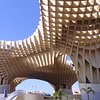
14. Binondo Church

15. Chinatown
16. Paco Park
17. San Sebastian Church

18. Museo Filipino Intramuros
19. Binondo
20. Bahay Tsinoy

21. Malate Church

22. National Museum of Natural History

23. Rizal Shrine

24. 168 Shopping Mall
25. National Museum Of Anthropology

26. Memorare Manila Monument

27. Presidential Museum and Library
28. Cultural Center of the Philippines
29. Chinese Cemetery

30. Santa Cruz Church

What travelers are saying


Manila travel guide
Manila tourism | manila guide, you're going to love manila.
The capital of the Philippines is a busy mass of energy and industry, and there are many reasons why it deserved its nickname "the Pearl of the Orient".

You can witness colonial sights like Casa Manila or Fort Santiago, or get a taste for how the city has thrived in an independent Philippines at the Museum of the Filipino People. Tuck into a freshly made lumpia wrapper, before heading to watch international music acts at the SM Mall of Asia Concert Grounds, or dance all night long to the rhythms of the city at clubs like Revel or Valkyrie.
Modern Manila is a heady mix of grand colonial churches, hyper-malls, museums, and street life that all combines to create a wonderful vacation destination.
Top 5 Reasons to Visit Manila
1. stunning architecture.
Manila was the capital of the Spanish Philippines for hundreds of years, and became one of the richest cities in the empire. Nowadays, visitors can explore this rich heritage at reconstructed colonial homes like Casa Manila, the ramparts of Fort Santiago, and lavish palaces like Malacañang (now the seat of the national government).
2. Superb Filipino Cuisine
Try lumpia (spring roll wraps) or adobo (chicken or lamb cooked in a rich garlic sauce) at restaurants like Sentro 1771 or Cafe Juanita.
3. Some of the Best Museums in Southeast Asia
Manila has all of the museums and galleries you could hope for from a national capital, and a few more besides. The largest is the National Museum, closely followed by the Museum of the Filipino People, but you might also head to more offbeat museums like the Museo Pambata (dedicated to children) and the science-oriented Mind Museum.
4. A Thriving Local Art Scene
Art is one of Manila's great passions, and with galleries like the Metropolitan Museum of Manila, the Yuchengco Museum, and contemporary exhibition spaces like 1335Mabini or Artinformal, visitors who share the city's love of painting and sculpture will be spoiled for choice.
5. Easy Day Trips to Beaches and Volcanos
Manila has plenty to offer on its own, but there are some superb attractions a few hours away. For instance, you could join tours to the peak of Mount Pinatubo or head to Tagaytay City, with its beautiful volcanic lagoon. You could also head to beaches like Calatagan and Zambales in no time at all.
What to do in Manila
1. intramuros: contrasted past.
Thick defensive walls once delimited the entire city of Manila, now a metropolis expanding far beyond containment. These streets hold the only remnants of a complicated past, and history unfolds with a tour of military headquarters Fort Santiago, or of lush colonial residence Casa Manila. Nearby, San Agustín remains the oldest active church in the country. Rizal Park stands at the outskirts of Intramuros, in celebration of the national heroes and the recent independence.
2. Binondo: World's Oldest Chinatown
Across Pasig River from Intramuros, this intensely contrasting neighborhood exemplifies the bustling culture of Manila as it is known today. Besides iconic Binondo Church, food is the main attraction. The famous Dong Bei dumpling house draws hungry visitors all day long. The local Cemetery extends northwards from this Chinatown, offering a break from the city amidst lovely Chinese architecture.
3. Manila Bay: Beyond the Busy Streets
Manila was strategically located on this bay for trade and defensive purposes, and today the city's greatest attractions surround its picturesque waters. Rides at Ocean Park and Star City send you soaring over the horizon, while the SM Mall of Asia offers endless shopping opportunities. The Cultural Center of the Philippines always has a local event going on, and is just a few steps from the boats that bear you to Corregidor Island.
4. Makati: Wall Street of the Philippines
Makati is the striking contemporary hub of Manila, and the Philippines' center for business and finance. Its skycrapers are iconic and jaw-dropping, with high-end department stores at their feet. Beneath the cityscape, side streets also hide smaller scale wonders worth a tour. The enjoyable Ayala Triangle Gardens with its cafés lie just behind the Stock Exchange, and the Greenbelt Chapel and Nuestra Señora de Gracia church harken back to earlier times.
5. Taal Lake: Lake-ception
A Lake within a Lake... Though Manila is teeming with energy day and night, the Philippines are also full of serene natural wonders. For a change of pace, make the day trip to Taal Lake, a dazzling freshwater crater south of the city. Take a boat to the isolated island at the center and make your way to the top of Taal Volcano on horseback. Light plays with the water that fills the mountaintop crater, as the rest of the lake expands in every direction down below.

Activities & attractions in Manila
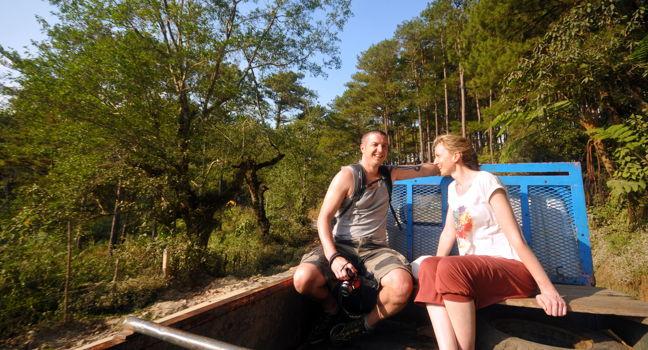
Where to Eat in Manila
If you want to try Filipino dishes, superb dining options include Sentro 1771, Kabila, and Wooden Spoon. However, there are also world-class Chinese restaurants like Tim Ho Wan, great Indian eateries like New Bombay, and European options like Caruso Ristorante Italiano. Manila has a massive range of dining options thanks to its multicultural nature, and gourmet food fans can dine very well for very little money. Expect high-quality meals to cost as little as ₱500.
When to visit Manila
The best time to visit Manila is during the country's dry season, which usually runs from around November to April. The city is a magical Christmas destination, and the weather will be ideal for sunbathing or sightseeing, so a festive break is an excellent idea. January is another option, with the added bonus of spectacular festivals like the Feast of the Black Nazarene.

How to Get to Manila
Most travelers from North America will arrive at Ninoy Aquino International Airport (MNL), which has good connections to all major American cities. When you arrive, the cheapest route into town is via the special Express Bus Service, which costs ₱300. If you choose to take a taxi, expect to pay around ₱700, and try to negotiate a fare before you leave the airport.
There are a number of car rental outlets at Manila Airport, including branches of Avis and TransAvia. If you are driving into the city, it's around eight miles to Intramuros (the center of town). Take the R-1 coastal road and it should lead you directly into the city.
If you are coming from provincial cities elsewhere in Luzon, Manila is well connected by bus, but every company will have its own drop-off point, so check the arrangements before you travel. Manila is a sprawling city, and it is not advisable to be dropped off in a distant suburb.
Airports near Manila
Airlines serving manila, where to stay in manila.
Those who need to be close to the sights in Intramuros could go for the comfortable Bayleaf Hotel, which has a rooftop restaurant. Other city center highlights include the Sofitel Philippine Plaza, Raffles Makati (which is very handy for the main business district), and Nobu Hotel, which has a huge on-site pool. Budget travelers could also have a look at Z Hostel in Makati, which is a modern, well-located but cheaper accommodation provider.
Popular Neighborhoods in Manila
Intramuros - literally "inside the walls", Intramuros is Manila's historical heart. Here you'll find almost all of the colonial-era attractions like the city ramparts, the church of San Agustín, Manila's splendid cathedral, and Casa Manila, a recreated colonial home.
Ermita - famous for its nightlife and restaurants, Ermita is where most tourists gravitate to at the end of a day of sightseeing, and with good reason. Ermita has plenty of family attractions like the Ocean Park Aquarium and the Museo Pambata, while eateries like Kamayan are a wonderful place to sample Filipino delicacies.
Sampaloc - home to most of Manila's higher education institutions, Sampaloc has a student vibe about it, but is also famous for its stunning Dangwa Flower Market. It's a good place to party and relax, while the many lechon (roasted pig) restaurants are excellent places to fill up at the end of the day.
Where to stay in popular areas of Manila
Most booked hotels in manila, how to get around manila, public transportation.
Manila is criss-crossed by three rail lines (colored yellow, purple, and orange), which provide good coverage of the major neighborhoods. Basic fares on the yellow and purple lines are ₱22 (for four stops), while the orange line is cheaper at ₱10. A good idea is to pick up a prepaid ticket with enough charge on it to cover your vacation travel, and you can do so at all major stations. Buses are also available and charge ₱10 for the cheapest fares.
There are a number of different types of taxi in Manila. The most fun is definitely a "calesa", which is a horse-drawn carriage; these only operate in the center of town. Calesas cost around ₱70 for an hour, so they aren't a budget option. Other than that, standard taxis are fairly cheap. Rates are metered (or should be) and start with a ₱40 flag drop, then ₱3.50 for every 300 meters, with a ₱3.50 charge for every two minutes of waiting time.
If you want to venture out of the city, renting a car in Manila is a must, and it shouldn't be hard thanks to local branches of Avis and Budget as well as local companies like Avalon. Expect a vehicle to cost about ₱300 per day. Inner city driving can be stressful thanks to chaotic traffic and driving, but rural highways are easy to use and make it much easier to get to sights like Tagaytay.
Best car rental deals in Manila
2 Adults, 2 Bags
4 Adults, 2 Bags
The Cost of Living in Manila
Shopping streets.
If you are looking for vintage clothing and designer gear from local talents, check out the Collective, a design community on Malugay Street. If you just want to wander endlessly from shop to shop, visiting SM Megamall - the fourth largest mall in the world - is essential. At the other end of the scale, diving into Ukay Ukay, mammoth used-clothes stores where you can rummage for anything from cheap finds to designer sunglasses.
Groceries and Other
The best places to shop for groceries in the Philippine capital are supermarkets like Rustan's, Puregold, and Walter Mart. Expect a gallon of milk to cost around ₱280 and 12 eggs to come to about ₱70.

First-Time Manila Travel Guide: Essentials To Know Before You Visit
Everyone who visits Manila comes back with a strong opinion of the city.
Sometimes it’s positive, sometimes it’s negative, but one thing is for sure: staying in Manila leaves a strong impression.
That raises some interesting questions for travelers.
What’s different between those who do and don’t like the city? What sort of expectations lead to a bad impression versus a good one? Most importantly, what should you know before arriving to have a great stay?
I had the advantage of first visiting Manila with a local. You may not.
After visiting the area several times, and eventually living there for over a year, here’s what every first-time visitor needs to know.
How Do You Describe Manila?
Whether they love Manila or hate it, I think every single traveler would describe it as a chaotic city. Manila is known for much more , but that’s the first word that comes to mind.
In any case, it’s nothing like the languid tropical paradise that the word “Philippines” might bring to mind.
However hectic, it’s also the national capital on almost every level—not just politically—so you’ll find abundant sites and attractions if you know where to look. That’s an important qualifier, since the good stuff doesn’t always jump out and may not be all that convenient, but it is most definitely there.
For perspective, the City of Manila proper is not that big of an area. “Manila” usually refers to the entire metro area (Metro Manila, a.k.a. the National Capital Region) and sometimes even beyond.
It’s the polar opposite of many European cities where most points of interest and nice neighborhoods are generally near a well-defined center. For a better sense of what I mean, take a moment to read about the different cities of Metro Manila .
Is Manila Worth Visiting?
Some Asian capitals are standalone destinations, and some are…well…not. Manila occupies a sort of middle ground, in my mind. It’s nothing like Tokyo, or even Bangkok , but it’s not remotely a war zone or backwater, either.
If you find hectic cities more exciting than draining, then Manila is well worth a few days of your trip. Most flights from outside Asia enter the Philippines through Manila anyhow, so it’s a convenient and affordable bookend to your island hopping, nature excursions, and so forth.
What Language Do They Speak In Manila?
Manila’s local language is Tagalog, but English is almost universally spoken at quite fluent levels. Read this article for more background on why and how both languages are used locally.
For travelers, there is essentially no practical need for Tagalog. Every venue and service with even the slightest appeal to visitors will have English menus/guides and English-speaking staff. I imagine there are exceptions, but I’ve yet to find one!
I believe it’s worth learning Tagalog if you’ll stay around Metro Manila/southern Luzon for an extended period. But there are several reasons Tagalog is tricky for native English speakers to pick up. Language learning is a terrific hobby, but it won’t yield much practical value over the time period that most tourists would stay in the area.
Is Manila Safe To Visit?
Let’s be frank: if you haven’t already seen lots of warnings about sketchy things and tourist dangers throughout the Philippines, you will. And they seem to happen at a higher rate than in Japan or France or Canada or what have you.
But understand two things.
First, realize that many of the most sordid events have involved expats involved (or whom we can reasonably guess were involved) in local businesses—often, but not always, of a controversial nature. That’s still a concern in the big picture, but pragmatically, it’s a world apart from anything you’ll do during your stay.
Secondly, and more specifically to Manila, there are bad areas and there are good areas. Tourists almost exclusively stay in the latter (which are easy to identify), if only because the former just don’t have much of interest. That’s not to say that all poorer areas are inherently dangerous or all wealthy ones are inherently safe, just that your priorities on a short-term stay will probably keep you around the well-lighted and more heavily policed districts.
Personally, I worry more about traffic safety than any of the above. I’ve tried to give the topic of Manila travel safety a fair treatment here , but in short: anyone who is reasonably cautious, self-aware, and happy to keep a low profile has no reason to expect problems.
What’s A Good Travel Budget For Manila?
When you visit a city that is a little chaotic and rough around the edges, one of the biggest advantages is that prices usually reflect this.
Manila is developing rapidly, has gleaming central business districts, and is home to a significant concentration of wealth and power. That pushes its prices noticeably above most of the Philippines, notwithstanding a few resort towns like Tagaytay .
Even so, if Western prices are your point of comparison, then you’ll find Manila both affordable and a generally good value. There are some nuances to this, since the good values tend to fall in the middle- to upper-tier spots, not so much at the bottom.
If you’re willing to be very frugal, then around $70 per person per day should get you a basic hotel room, decent meals out, and at least a short rideshare trip or two. Dorm-style hostels and a street- or fast-food diet will obviously reduce that number, but I’ll leave it to your judgment whether that’s worth it.
However, you’ll have a lot more fun and enjoy far nicer venues if you roughly double that number. Obviously, high-end tastes will cost significantly more to satisfy, but still less than you might expect.
In any case, you’re looking at an entire day plus night in Manila for less than a basic hotel room alone in many smaller and duller cities.
Read this Manila cost guide for more context and planning tips.
What’s The Best Time Of Year To Visit Manila?
Given the choice, try to visit Manila in the winter months. The Christmastime busyness has settled down, and the weather is at its most pleasant.
For better or worse, you get two seasons in the tropics: wet (roughly May-November) and dry (roughly November-May).
You can expect heat and humidity year-round, but springtime is warmest on average by about 5-7 degrees Fahrenheit.
Within the wet season, the rain still peaks dramatically in the summer months, so it’s best if you can visit outside late June through early October. Still, the rain tends to come in absolute downpours rather than all-day drizzle, so the (literally) bright side is that even rainy-season visitors will still see plenty of sunshine at times.
What Part Of Manila Should I Stay In?
If you have more than an ultra-tight budget at your disposal, and you want a nice area and minimal time in traffic, then there are basically four options. In no particular order:
The City of Manila is where you’ll find Intramuros, some remarkable churches and museums therein, Rizal Park, several national museums, Binondo’s Chinatown, and so forth. In a nutshell: all the major historical and cultural landmarks. Consider staying in the City of Manila if you’re only in town for a couple days, and want to spend them seeing the major sights.
Makati is the country’s finance hub and probably has more high-end venues per block than anywhere else in Metro Manila. It’s farther from the tourist attractions of Manila proper, but roughly the same distance from the airport. The Salcedo and Legazpi neighborhoods are expat favorites, and Poblacion is a lower-key but hipper choice. Consider staying in Makati if you’re in town for a longer period and prefer a more contemporary and (somewhat) orderly environment. It’s also the right choice if you’re into the club scene.
Bonifacio Global City (BGC) is a new-ish and very upscale central business district of Taguig. A lot of multinational firms’ offices are here, as are many Western expats. It’s just east of Makati, which adds a couple of awfully congested miles to reach tourist sites. BGC is a district, not a whole city like Makati or Manila, and feels a little calmer by Metro Manila standards. Consider staying in BGC if you prefer a modern, almost Singapore-like neighborhood and are visiting for long enough not to mind the distance to tourist attractions.
Finally, Pasay and especially the Mall of Asia vicinity, is just a couple of miles from the airport. It’s also quite close to the casinos and “integrated resorts.” There’s little of particular cultural interest, and it lacks the “cool” factor or (relative) walkability of Makati and BGC. Consider staying around Pasay and the Mall of Asia if you’re on a very brief trip and need mostly to be near the airport.
Some of the other cities of the National Capital Region are pleasant and have their own points of interest, but none are as nice or convenient for short visits.
How Many Days Should I Spend In Manila?
At a bare minimum, plan two full days to see the major sites without getting too stressed by Manila’s congestion. Four to five full days are enough for most things that most visitors want to experience in Metro Manila.
If you stay in one of the areas mentioned above—as opposed to a more outlying spot—then the ride between points of interest shouldn’t take too much more than an hour. That’s a long time for three or five miles of travel, but you’re better off planning for it than being stressed or disappointed when an overly ambitious itinerary proves impossible. (It’s hard to overstate just how badly congested this area is!)
Anyhow, two days allow for something like a half-day (at least in Intramuros), a half-day in Chinatown and/or more museums, then a full day to explore the more modern areas. That will suffice for all the must-sees.
If you are keen to explore further, then it’s easy to fill three to four days comfortably but fully. That gives time for the above plus a guided tour, exploring food/coffee/whatever-you’re-into, shopping, casino outings, and the like.
Unless you like a particularly leisurely pace, you’ll probably run out of major to-do’s after day four or five. So, if you’re in town longer, then consider spending a night or two for a change of scenery in a cooler, quieter town like Tagaytay .
Conclusion: Planning Your Manila Trip
Despite a reputation for chaos, and the need for extra (but entirely reasonably) safety precautions, it’s a welcoming and accessible place unlike anywhere else in Asia.
A handful of cities/districts each strike a good balance between minimizing time in traffic and maximizing the value and enjoyability of your surroundings. English speakers won’t have any trouble getting around—or doing so on a modest budget.
Manila is a worthwhile stop for the right sort of traveler with the right sort of expectations. If nothing else, I hope this guide has helped to set those expectations.

Erik is an American writer with family ties to the Philippines. After visiting and eventually living in Metro Manila, he launched Manila FYI to help visitors understand, enjoy, and thrive in this fascinating part of the world.
View all posts
Similar Posts

Manila Vs. Metro Manila: Understanding The Cities Of The NRC
Manila is a colossal metropolis that sprawls for miles around. It’s a vast yet dense microcosm of almost every facet of the Philippines, almost like a country unto itself. It may not be everyone’s cup of tea, but there are plenty of reasons that Manila is well worth visiting. But when we foreigners refer to “Manila,”…
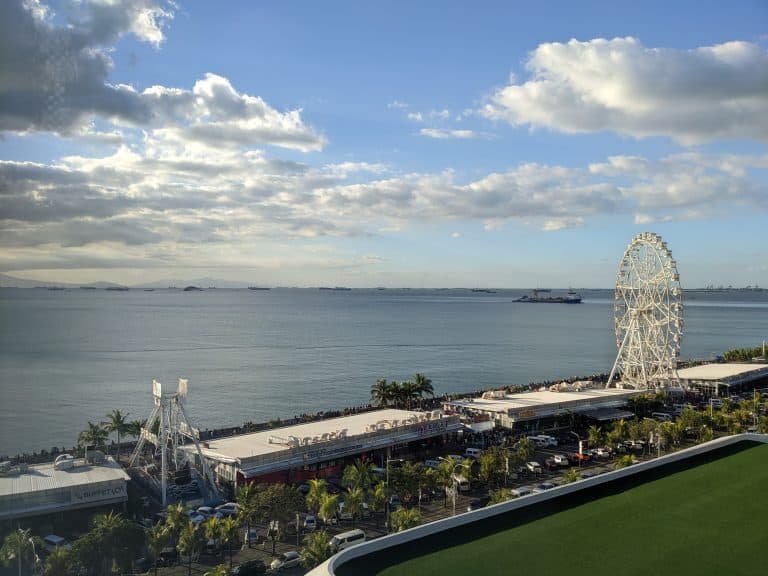
What Is Manila Known For?
Manila is a destination for some, a jumping-off point for others, and of course home to many millions. You’ll get as many takes as there are people. But, by and large, most will agree on a few particular things. Domestically, Manila is known as the political, financial, and commercial capital of the Philippines. To travelers,…
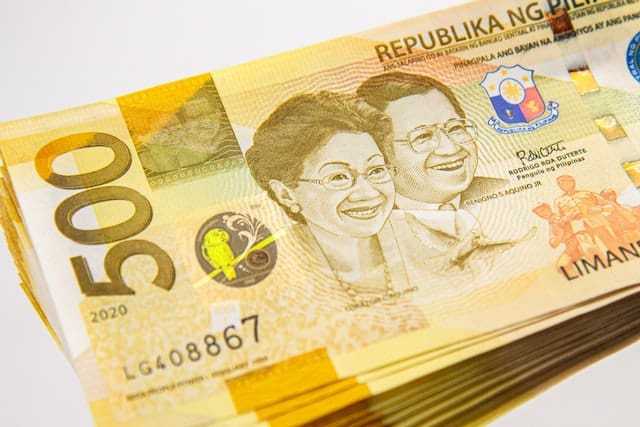
Is Manila Expensive To Visit? (What To Budget For A Great Trip)
Southeast Asia is on the top of every backpacker’s and budget traveler’s list. But if you want to splurge on pampering and futuristic luxury, there’s something for you, too. Where does the Manila fit in that spectrum? Here’s whether Manila is expensive Manila is not expensive to visit, by Western standards. Tourists in Manila will…
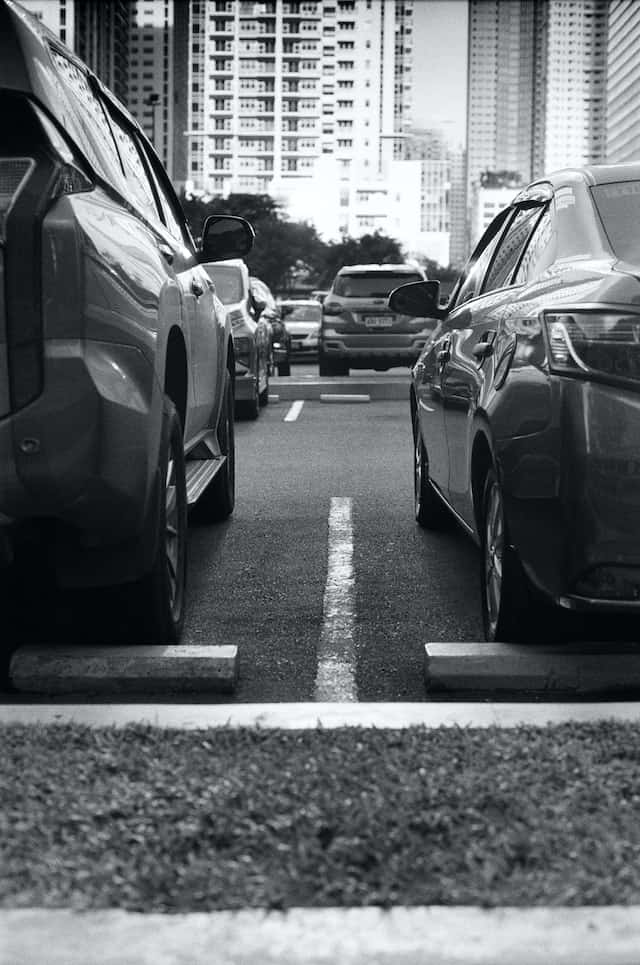
The 3 Biggest Reasons Manila Traffic Is So Bad
Just about everyone who visits Manila, especially from the West, is floored by one thing the second they leave the airport. Not the heat, not the density, not even the unique and oddly pleasant BBQ-and-exhaust smell…but the traffic. It even costs the Philippine economy about $70 million per day! Every big city has congested roads, but Manila’s traffic is particularly…

Is Manila Safe? (What I Learned From Living There)
Manila gets a bad rap for crime. “Well, duh,” you might think, “It’s a big, gritty city in a fairly poor country.” That’s not wrong, but it doesn’t reflect the reality that most foreigners will experience, either. Manila travel safety in brief Travel safety in Manila is more complicated than “yes” or “no.” Manila’s tourist…
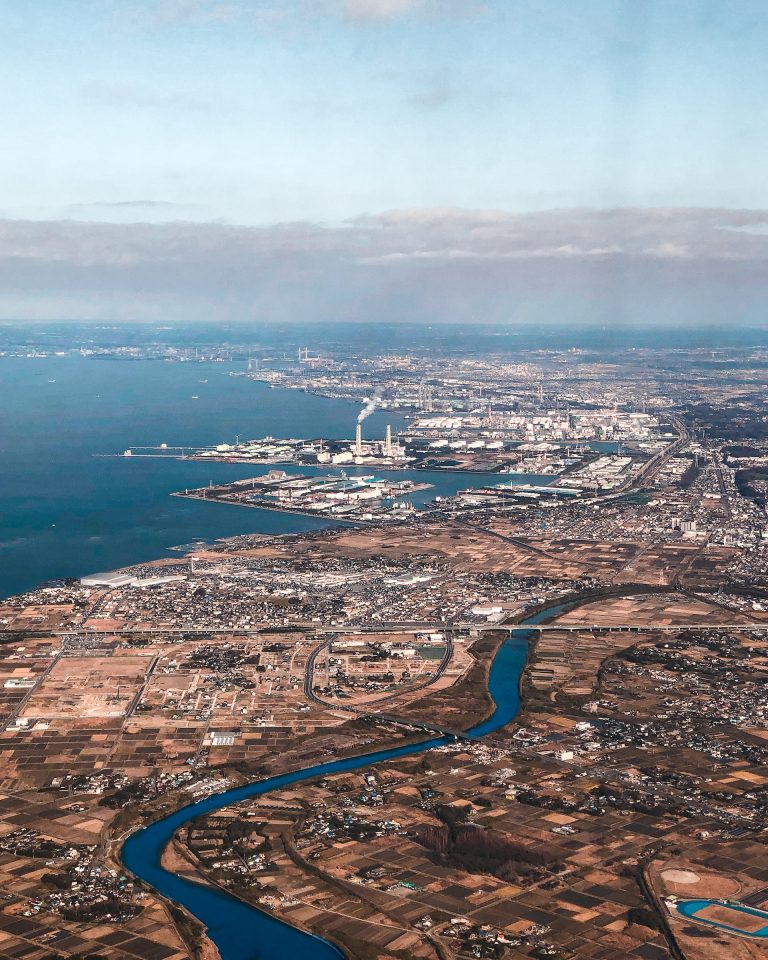
Is Manila Below Sea Level? (The Story Behind The Sinking & Floods)
From its epic sunsets to legendary battles, Manila Bay is a significant part of history and life around Metro Manila. Approaching the city from the air, you can’t miss the fish ponds and even impromptu houses that extend far into its water. It can be surprisingly hard to tell where land ends and the bay…
- Travel Planning Guide
Philippines Travel Budget - Visit Philippines on a Budget or Travel in Style
- Philippines Costs

- Is the Philippines Expensive?
- How much does a trip to the Philippines cost?
- Puerto Princesa
- Philippines Hotel Prices
- Philippines Cities: Hotel Prices by City
- Best Luxury Hotels in the Philippines
- Best Beach Hotels in the Philippines
- Best Romantic Hotels for Couples in the Philippines
- Best Hotels for One Night in the Philippines
- Best Cheap Hotels in the Philippines
- Best Hotels for a Weekend Getaway in the Philippines
- Best Party Hotels in the Philippines
- Best Hotels for Scuba Diving in the Philippines
- Best Hotels for One Week in the Philippines
- Best Family-Friendly Hotels in the Philippines
- Best Hotels for First Time Visitors in the Philippines
- Best Adults Only Hotels in the Philippines
- Best Pet-Friendly Hotels in the Philippines
- Best Business Hotels in the Philippines
- Hostel Prices & Reviews
- Philippines Tour Prices
- The Best Family-Friendly Tours to Philippines
- The Best 10-Day Tours in Philippines
- The Best 2-Week Tours in Philippines
- Tours for Outdoor and Nature Lovers in Philippines
- The Best Christmas & New Years Tours in Philippines
- The Best Adventure Tours to Philippines
- The Best Eco Tours in Philippines
- The Best Cultural Tours in Philippines
- The Best Camping Tours in Philippines
- The Best Romantic Tours for Couples in Philippines
- The Best Honeymoon Tours in Philippines
- The Best Tours Under $1000 in Philippines
- The Best Budget Tours to Philippines
- The Best Tours for Seniors to Philippines
- How much does it cost to travel to the Philippines? (Average Daily Cost)
- The Philippines trip costs: one week, two weeks, one month
How much do package tours cost in the Philippines?
Is the philippines expensive to visit.
- How much do I need for a trip to the Philippines?
- Accommodation, Food, Entertainment, and Transportation Costs
- Travel Guide
How much does it cost to travel to the Philippines?
You should plan to spend around $65 (₱3,768) per day on your vacation in the Philippines. This is the average daily price based on the expenses of other visitors.
Past travelers have spent, on average for one day:
- $15 (₱875) on meals
- $21 (₱1,210) on local transportation
- $49 (₱2,840) on hotels
A one week trip to the Philippines for two people costs, on average, $906 (₱52,749) . This includes accommodation, food, local transportation, and sightseeing.
All of these average travel prices have been collected from other travelers to help you plan your own travel budget.
- An island paradise at affordable prices Travel Style: All Budget (Cheap) Mid-Range Luxury (High-End)
- Average Daily Cost Per person, per day $ 65 ₱ 3,768
- One Week Per person $ 453 ₱ 26,375
- 2 Weeks Per person $ 906 ₱ 52,749
- One Month Per person $ 1,942 ₱ 113,034
- One Week For a couple $ 906 ₱ 52,749
- 2 Weeks For a couple $ 1,813 ₱ 105,498
- One Month For a couple $ 3,884 ₱ 226,068
How much does a one week, two week, or one month trip to the Philippines cost?
A one week trip to the Philippines usually costs around $453 (₱26,375) for one person and $906 (₱52,749) for two people. This includes accommodation, food, local transportation, and sightseeing.
A two week trip to the Philippines on average costs around $906 (₱52,749) for one person and $1,813 (₱105,498) for two people. This cost includes accommodation, food, local transportation, and sightseeing.
Please note, prices can vary based on your travel style, speed, and other variables. If you're traveling as a family of three or four people, the price per person often goes down because kid's tickets are cheaper and hotel rooms can be shared. If you travel slower over a longer period of time then your daily budget will also go down. Two people traveling together for one month in the Philippines will often have a lower daily budget per person than one person traveling alone for one week.
A one month trip to the Philippines on average costs around $1,942 (₱113,034) for one person and $3,884 (₱226,068) for two people. The more places you visit, the higher the daily price will become due to increased transportation costs.
Organized tours are usually more expensive than independent travel, but offer convenience and peace of mind that your trip has been planned by a travel expert.
The average price for an organized tour package in the Philippines is $185 per day. While every tour varies by total price, length, number of destinations, and quality, this is the daily average price based on our analysis of available guided tours.
- Coron Island Life Expedition (Coron to Coron 3D2N) 3 Days - 4 Destinations $ 457
- 12 Days Ultimate Manila and Cebu - Philippines Island Hopping 12 Days - 6 Destinations $ 3,272
Independent Travel
Traveling Independently has many benefits including affordabilty, freedom, flexibility, and the opportunity to control your own experiences.
All of the travel costs below are based on the experiences of other independent travelers.
The Philippines is a reasonably affordable destination to visit. It is in the top 25% of countries in the world for its affordability . If you're traveling on a budget, then this is a good destination with affordable accommodation, food, and transportation.
Within Asia, the Philippines is moderately priced compared to the other countries. The overall cost of travel here is comparable to Cambodia or China.
For more details, see Is the Philippines Expensive?
How much money do I need for a trip to the Philippines?
The average Philippines trip cost is broken down by category here for independent travelers. All of these Philippines travel prices are calculated from the budgets of real travelers.
Accommodation Budget in the Philippines
Average daily costs.
Calculated from travelers like you
The average price paid for one person for accommodation in the Philippines is $24 (₱1,420). For two people sharing a typical double-occupancy hotel room, the average price paid for a hotel room in the Philippines is $49 (₱2,840). This cost is from the reported spending of actual travelers.
- Accommodation 1 Hotel or hostel for one person $ 24 ₱ 1,420
- Accommodation 1 Typical double-occupancy room $ 49 ₱ 2,840
Hotel Prices in the Philippines
Looking for a hotel in the Philippines? Prices vary by location, date, season, and the level of luxury. See below for options.
Find the best hotel for your travel style.
Actual Hotel Prices The average hotel room price in the Philippines based on data provided by Kayak for actual hotel rooms is $41. (Prices in U.S. Dollars, before taxes & fees.)
Kayak helps you find the best prices for hotels, flights, and rental cars for destinations around the world.
Recommended Properties
- True Home Hotel Boracay Budget Hotel - Kayak $ 106
- Raffles Makati Luxury Hotel - Kayak $ 241
Local Transportation Budget in the Philippines
The cost of a taxi ride in the Philippines is significantly more than public transportation. On average, past travelers have spent $21 (₱1,210) per person, per day, on local transportation in the Philippines.
- Local Transportation 1 Taxis, local buses, subway, etc. $ 21 ₱ 1,210
Recommended Services
- Mactan Cebu Airport Transfer to City Hotels Viator $ 35
- Kawasan Falls Canyoneering w/ Lunch & Transfers from Cebu City Viator $ 122
Food Budget in the Philippines
While meal prices in the Philippines can vary, the average cost of food in the Philippines is $15 (₱875) per day. Based on the spending habits of previous travelers, when dining out an average meal in the Philippines should cost around $6.01 (₱350) per person. Breakfast prices are usually a little cheaper than lunch or dinner. The price of food in sit-down restaurants in the Philippines is often higher than fast food prices or street food prices.
- Food 2 Meals for one day $ 15 ₱ 875
Recommended
- Makati Street Food tour Experience with Mari Viator $ 73
- Manila Chinatown Food Tour Experience Viator $ 65
Entertainment Budget in the Philippines
Entertainment and activities in the Philippines typically cost an average of $14 (₱810) per person, per day based on the spending of previous travelers. This includes fees paid for admission tickets to museums and attractions, day tours, and other sightseeing expenses.
- Entertainment 1 Entrance tickets, shows, etc. $ 14 ₱ 810
Recommended Activities
- Immerse in Culture: Villa Escudero Coconut Plantation Experience Viator $ 145
- Chocolate hills Bohol Nature tour Viator $ 100
Tips and Handouts Budget in the Philippines
The average cost for Tips and Handouts in the Philippines is $1.96 (₱114) per day. The usual amount for a tip in the Philippines is 5% - 15% .
- Tips and Handouts 1 For guides or service providers $ 1.96 ₱ 114
Scams, Robberies, and Mishaps Budget in the Philippines
Unfortunately, bad things can happen on a trip. Well, you've just got to deal with it! The average price for a scam, robbery, or mishap in the Philippines is $1.46 (₱85), as reported by travelers.
- Scams, Robberies, and Mishaps 1 $ 1.46 ₱ 85
Alcohol Budget in the Philippines
The average person spends about $11 (₱627) on alcoholic beverages in the Philippines per day. The more you spend on alcohol, the more fun you might be having despite your higher budget.
- Alcohol 2 Drinks for one day $ 11 ₱ 627
- Panglao Pub Crawl Viator $ 18
- Cebu City Light's Pub Crawl Viator $ 99
Water Budget in the Philippines
On average, people spend $1.41 (₱82) on bottled water in the Philippines per day. The public water in the Philippines is not usually considered safe to drink.
- Water 2 Bottled water for one day $ 1.41 ₱ 82
Related Articles
The philippines on a budget.

At A Glance
- If you're interested in Filipino culture and history head to the Banaue area. There are rice terraces that have existed for over 2000 years. It's a very scenic area that has been designated as a UNESCO World Heritage Site, and shouldn't be missed if you're in the area.
- Because the Philippines is made of the many different islands you'll likely find yourself taking several different flights while you're in the country ( compare prices here ). Some of the most popular and affordable airlines include Philippine Airlines, Cebu Pacific and Airphil Express. Flights are usually reasonable in price but do increase around major holidays or during peak travel times. Most flights are economy class only.
- If you decide to take a trip on the Bicol Express Train you can decide between four different classes. These include the executive sleeper class which has private, air conditioned cabins with one bed; the family sleeper class which includes four beds in an air conditioned cabin; the deluxe class which offers reclining chairs in air conditioned cabins; and the economy class which includes benches and fans for ventilation.
- There are ferries that connect many of the islands. While this is a cheap form of transportation it is also somewhat unsafe. Use commonsense when you board a ferry. If the boat seems to be over capacity, do not get on it. Also make sure you check the weather reports prior to taking a ferry as some captains sail even in rough waters. Generally speaking, ferries are not safer than flying.
- Don't overlook the historic sights while you're in the Philippines. The natural beauty is perhaps the most impressive part of the country, but there are still some excellent museums and cultural areas that are well worth a visit.
Top Tourist Attractions
Popular foods, more related articles.
We've been gathering travel costs from tens of thousands of actual travelers since 2010, and we use the data to calculate average daily travel costs for destinations around the world. We also systematically analyze the prices of hotels, hostels, and tours from travel providers such as Kayak, HostelWorld, TourRadar, Viator, and others. This combination of expenses from actual travelers, combined with pricing data from major travel companies, gives us a uniqe insight into the overall cost of travel for thousands of cities in countries around the world. You can see more here: How it Works .
Subscribe to our Newsletter
By signing up for our email newsletter, you will receive occasional updates from us with sales and discounts from major travel companies , plus tips and advice from experienced budget travelers!

Search for Travel Costs
Some of the links on this website are sponsored or affiliate links which help to financially support this site. By clicking the link and making a purchase, we may receive a small commission, but this does not affect the price of your purchase.
Travel Cost Data
You are welcome to reference or display our travel costs on your website as long as you provide a link back to this page .
A Simple Link
For a basic link, you can copy and paste the HTML link code or this page's address.
Travel Cost Widget
To display all of the data, copy and paste the code below to display our travel cost widget . Make sure that you keep the link back to our website intact.
- Privacy / Terms of Use
- Activities, Day Trips, Things To Do, and Excursions

12 Top-Rated Tourist Attractions & Things to Do in Manila
Written by Anietra Hamper Updated Dec 23, 2023 We may earn a commission from affiliate links ( )
Author Anietra Hamper has traveled throughout Manila and the Philippines experiencing many of the top attractions and things to do off the beaten path.
The busy city of Manila, the capital of the Philippines , is an exciting and energetic metropolis. Hop on board any of the colorful and kitschy jeepneys to get around town. The iconic buses that usually pack in more people than they can hold are the main form of transportation and worth at least one ride during your visit, just for the experience.
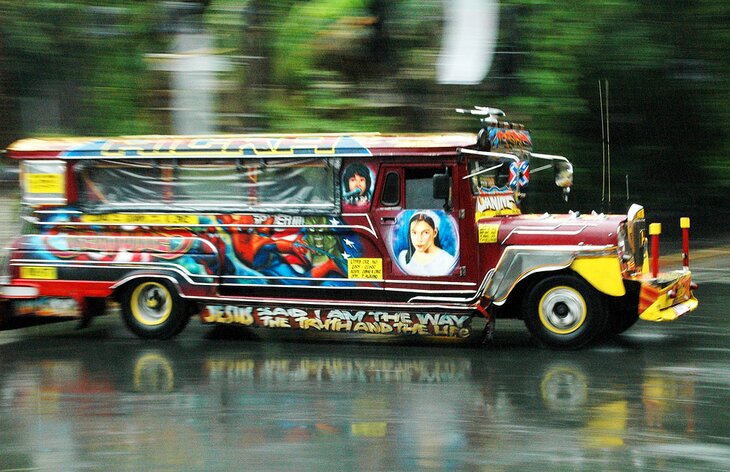
Manila has an eclectic mix of modern attractions and rich history , as evidenced by the many cathedrals and tributes to the city's 16th-century establishment alongside modern-day malls and amenities.
Some of the best places to visit in Manila are the churches, monuments, and impeccably landscaped public parks. Manila is full of restaurants that serve up local fare, including fresh seafood.
The city is a regular target for typhoons, so the best time to visit the Philippines is outside of the rainy season, which is May through November.
For other sightseeing ideas, read our list of the top attractions and things to do in Manila.
1. Experience Manila's Oldest Section in Intramuros
2. dive deep at manila ocean park, 3. san agustin church and museum, 4. stroll through rizal park, 5. walk the grounds at fort santiago, 6. admire quiapo church and public square, 7. view the skyline from manila bay, 8. discover filipino history at the national museum of the philippines, 9. robinsons place mall, 10. tour manila on bambike ecotours, 11. shop for bargains at divisoria market, 12. spend a day at the sm city manila super mall, where to stay for sightseeing in manila, map of tourist attractions & things to do in manila, manila, philippines - climate chart.
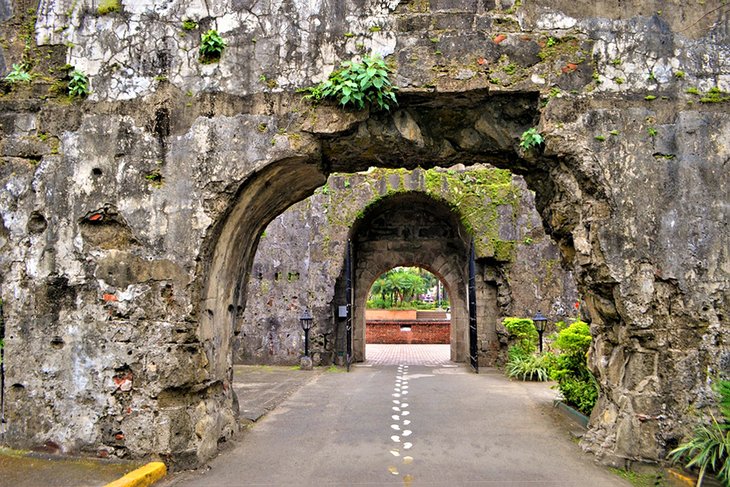
You will likely pass through the Intramuros whether you know it or not as you explore Manila. It is the oldest section of the city and characterized by its walled fortress. This section of Manila was once a walled city during Spanish Colonial times in the 1500s to the 1800s.
Walk around inside the three-mile-long stone wall that surrounds the district. While you can walk the grounds on your own, you might want to take a guided walking tour to learn more about the walled city and its significance to Manila.
Address: Bonifacio Drive & Padre Burgos Street, Manila, Luzon
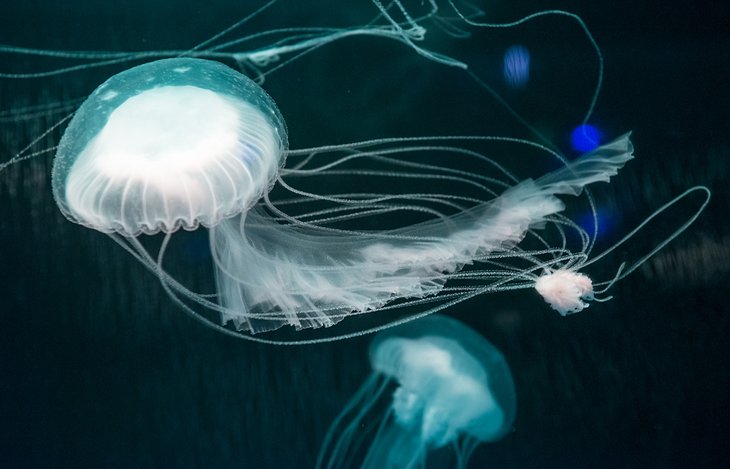
The Manila Ocean Park is one of the most unique adventures in the city and one of the top things to do for families visiting Manila. Get interactive with marine life with the Sharks and Rays Encounter; Trails to Antarctica exhibit; or the fish spa, where fish clean your feet in a small pool of water.
The park easily fills several hours depending on how many encounters you try. In addition to the state-of-the-art aquatic facility, you will see exhibits of birds and other animals.
The Manila Ocean Park is billed as a marine theme park . Besides the educational aquatic attractions, there is shopping, dining, and HOTEL H20 , where you can sleep surrounded by an aquarium.
Address: Manila Ocean Park Luneta, Manila
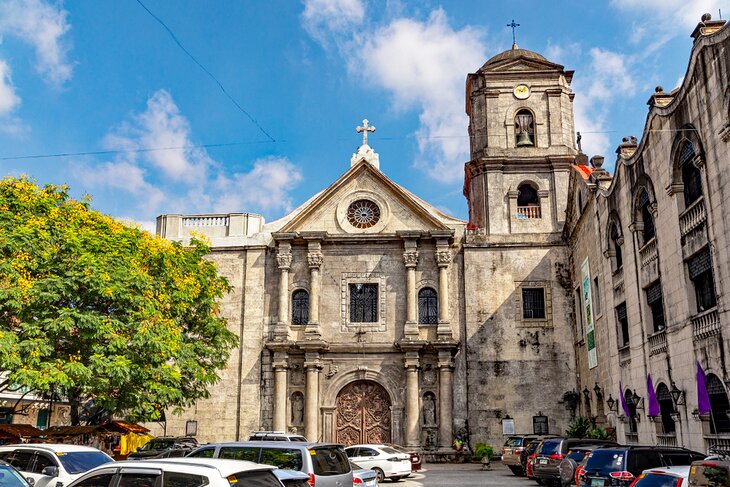
As a designated UNESCO World Heritage site , the San Agustin Church is a national treasure and one of the most popular places to visit in the Philippines .
This Catholic church has a unique history that is reflected in the details of the building. If you look closely, you will see both Chinese and Spanish influences in the design. The church has been rebuilt several times after battles and natural disasters.
Pay close attention to the carvings on the large wooden doors that open to the chapel. If you have an interest in history or architecture, it would be worth your time to hire a local guide who can take you on a walking tour of the area and describe intricate details of the church that you may not notice on your own.
Address: Gen Luna & Real Streets, Intramuros, Manila, Luzon 1002
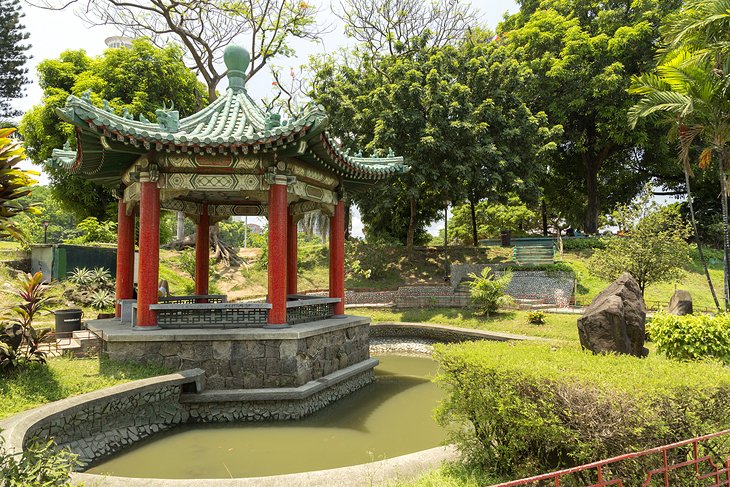
One of your first stops in Manila should be Rizal Park. Sometimes referred to as Luneta Park , this is a peaceful and manicured outdoor garden located in the heart of the city. The park is a social gathering place in Manila known for its open-air concerts and chess plaza .
The paved pathways through the park guide you through a lush landscape of blooming flowers, ponds, and more than 40 points of interest that range from statues to historical dedications. Of note is the century-old Monument of Rizal , which houses the remains of one of the Philippines' most celebrated heroes, Dr. Jose Rizal.
Be sure to stroll through the park to learn about the local flora and fauna. Keep your eyes open for the Narra tree, the national tree of the Philippines, and the small lake with an artistically raised archipelago structure in the middle.
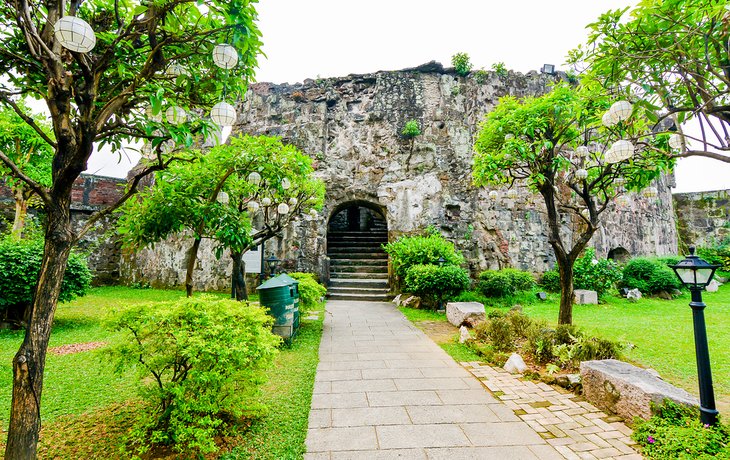
The site of Fort Santiago is an impressive stop if you are visiting the city and it is one of the most important historical sites in Manila . This 16th-century fortress was key in protecting the Intramuros, which is the oldest district in Manila, known historically as the Walled City.
You can explore the grounds at a leisurely pace. Be sure to take note of bullet markings that are still visible in the fortress walls and stop by the visitor center for more detailed information about the fort.
Address: Gen Luna Street, Intramuros, Manila, Luzon
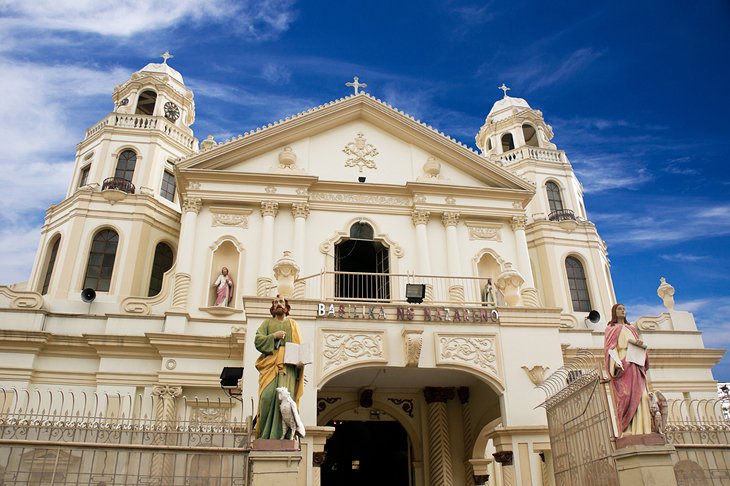
The Quiapo Church is one of the oldest and most admired Catholic churches in Manila. The more formal name of the church is the Minor Basilica of the Black Nazarene .
Depending on the time of day, the plaza surrounding the century-old church can be quite congested, which makes it an interesting place to visit to admire the devotion of the Filipino people.
Fridays are the busiest days, when thousands of people pile into the square and pray at the church for novena. Despite the large gatherings of church devotees, this is one of the top attractions in the city.
Take time to see the inside of the church, and stroll through the market stands outside to buy fresh peanuts, mangoes, or necklaces from local vendors.
Address: Plaza Miranda & Quezon Blvd., Quiapo, Manila, Luzon
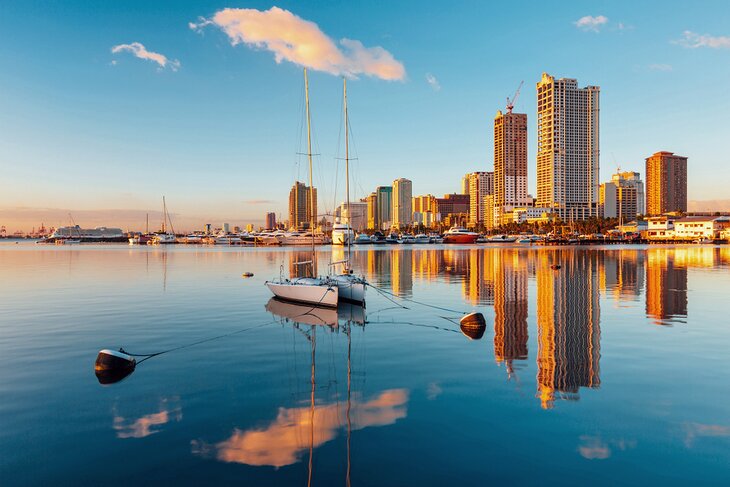
Strolling along the Manila Bay waterfront is one of the most enjoyable and scenic things to do in the city, and it does not cost anything to enjoy. The natural harbor is always bustling with activity. Take a walk along the Manila Baywalk at sunset for a great view of the city skyline.
The bayfront is accented by yachts and smaller boats anchored in the harbor, and open-air cafés where you can stop for a bite to eat. The bay front is also a popular place for locals taking in a morning jog.
Another relaxing way to enjoy Manila Bay is to book a sunset dinner cruise that will take you past local landmarks and includes dinner and live entertainment for an evening.
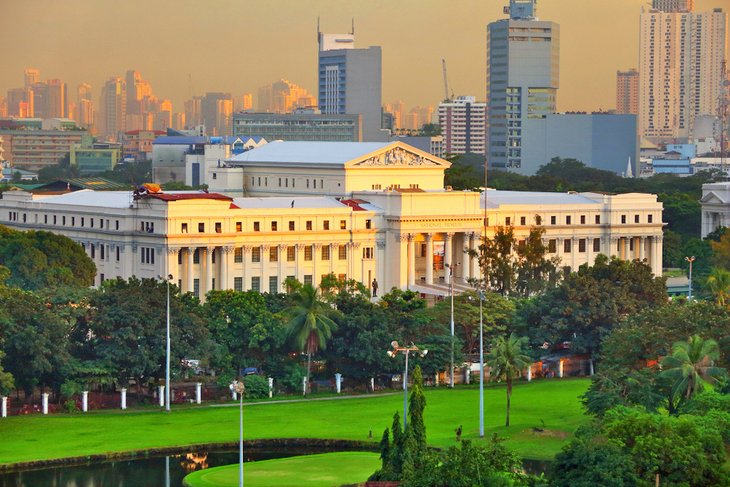
For a true exploration into the culture of the country, the National Museum of the Philippines is one of the best places to visit.
This museum has four main complexes including extensive collections and artifacts relating to art, archaeology, anthropology, zoology, biology, and natural history. The museum galleries help offer a sense of place, telling the cultural story beyond what you will find on your own visiting the city's many historical attractions.
Address: Padre Burgos Street, Manila, Luzon 2004
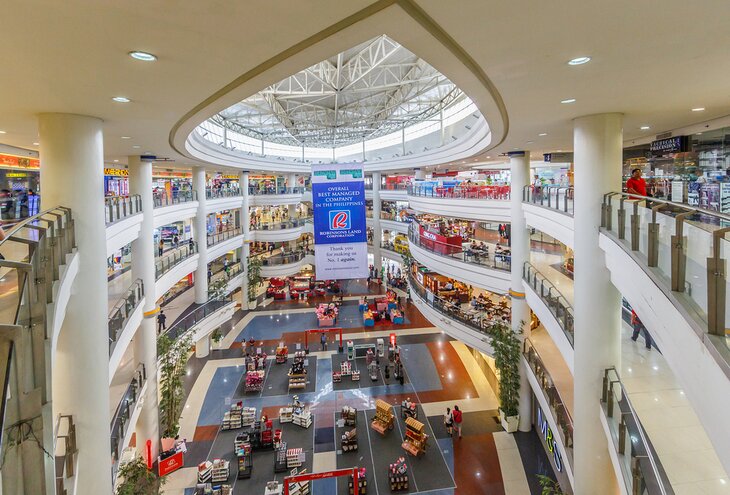
While a mall might not be on the top of your list for exploring the culture of Manila, Robinsons Place Mall has a surprising number of unique stores where you can find local items . While locals shop here, it's also a popular spot for tourists.
Be on the lookout for clothing, cosmetics, bags, and food that are unique to the Philippines. The mall is extensive, so plan time to walk the interior and explore the stores.
The mall's modern building is a stark contrast to the rustic and historic landmarks that surround it.
Address: Pedro Gil Corner Adriatico Street, Manila, Luzon
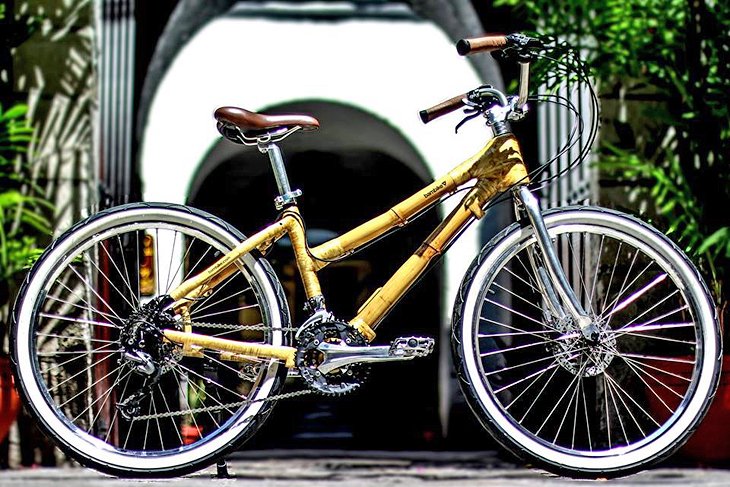
Manila is a pedestrian-friendly city , but if you want to explore the culture and history more efficiently, consider the Intramuros Bamboo Bicycle Ecotours .
These tours provide a unique, eco-friendly way to see urban Manila. By taking an ecotour, you are also supporting environmental sustainability efforts of local businesses.
Bambikes are locally hand-made bicycles custom-built from bamboo. The company has a social welfare initiative that employs villagers for the production of the bikes.
Address: Real Street, corner General Luna Street, Intramuros, Manila
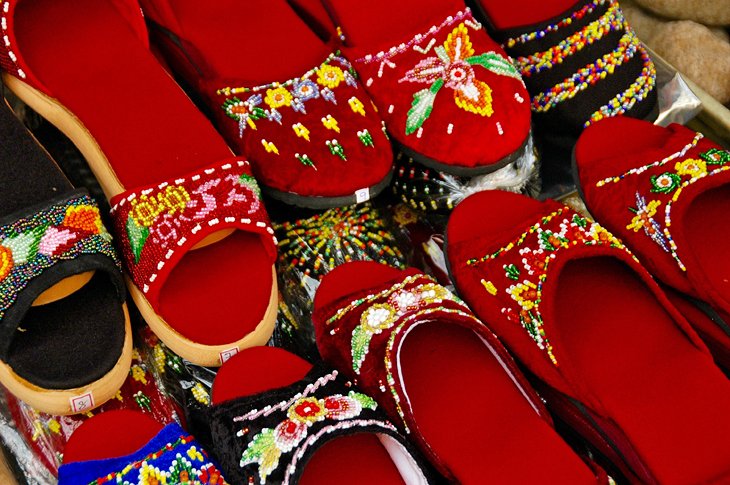
If you are in the mood to shop for a bargain, head to the lively Divisoria Market in Manila. It is located in the heart of Chinatown, where you will discover overflowing vendor stalls selling everything from fruit and spices to flip-flops and beads.
This is the best place to people-watch and take in the local flavor. The bustling atmosphere is like a flea market, and bargaining is the name of the game. You should only pay about 50 percent of the price of an item, and often you can get souvenirs for much lower.
Address: Claro M. Recto Avenue, Divisoria, Manila, Luzon
There's no shortage of places to shop in Manila, so if you want to fill your suitcase with treasures, plan a half day or full day at the SM City Manila Super Mall . It is like one-stop shopping for something to do in the city because the huge complex has retail stores, restaurants, and entertainment.
The SM City Manila is easy to spot. It has a mega globe structure on the grounds, which makes for a great selfie spot. This retail complex is popular with the locals, so it can get quite crowded.
If you are looking for more unique souvenirs, you might want to hit the smaller local markets but if you are after mainstream items, you are sure to find them at the super mall.
Manila hotels are quite affordable, even the high-end hotels. You will have no problem finding something in your budget on any side of town.
Luxury Hotels:
- One of the top luxury hotels in Manila is the Sheraton Manila Bay , which even provides all guests with butler service. It is a preferred choice for business travelers, but if you want a little extra pampering during your visit, the hotel offers top-of-the-line amenities.
- The luxury New Coast Hotel Manila sits on Manila Bay , so you have some of the best views in the city, and it is centrally located for easy walking downtown and to local restaurants.
Mid-Range Hotels :
- One of the most unique lodging experiences in Manila is Hotel H20 located at the Manila Ocean Park. Go to sleep in an aquarium-walled room and wake up next to marine life.
- The historic Manila Hotel is another mid-range lodging situated on Manila Bay close to many of Manila's attractions.
Budget Hotels :
- The affordable Red Planet Manila Binondo is highly rated and located close to Chinatown in Manila. The hotel is just a few blocks from several historic churches and the Divisoria Market .
- For a centrally located budget hotel the Ramada by Wyndham Manila Central is a good option. The Ramada is located close to many of the cultural sites and local transportation access points.
The Philippines Budget Travel – Top Tips
The Philippines budget travel requires a little creativity and resourcefulness. Compared to the rest of Southeast Asia, food, accommodation, and transportation are more expensive in the Philippines. However, budget travel can still be done on the cheap provided that you do some research ahead of time.
Is It Possible To Travel The Philippines On A Low Budget?
Backpacking Philippines is a popular choice for getting to know the country’s best sights on a budget. It is possible to spend as little as PhP 500 a day on food and drink if your needs are simple. Hostels are abundant, and so is cheap food; though it’s slightly more expensive in Manila than in Thailand , Vietnam , and Cambodia .
For example, while you can eat pho on the streets of Vietnam for just PhP 30, you will have to spend around PhP 80 and up for a decent meal in the Philippines since street food is not regarded as the safest, cleanest, or healthiest.
Hostel dorm beds can be as cheap as PhP 300 a night in Thailand, but the cheapest you’ll find in Manila starts at around PhP 700 per bed.
Travelling on a low budget in Manila is possible, but it’s transportation that is expensive. For this reason, it’s smart to book a hostel in the city center so that you can walk around the city instead of hiring a taxi or ride-sharing vehicle through the apps Grab and Uber.
However, when visiting more remote areas and beach destinations, it becomes much easier to find budget accommodation and the cost of transport, food, and activities are also much lower. In remote areas, there are many homestays and hostels with dorm beds as low as PhP 250 a night especially if you don’t mind a fan room with the most basic amenities – after all, you’ll be spending most of your time outdoors and exploring. Food in Philippine provinces, including beaches, is cheap, abundant, and delicious: for a homemade meal you can expect to pay PhP 50 up for a viand and a heaping cup of rice (Filipinos love their rice!).
You can find inexpensive Filipino food served at food stalls (locally known as carinderia , commonly found along the side of the road) in all tourist destinations, as well as mom-and-pop style restaurants where you can enjoy a wide variety of inexpensive and delicious food. Carinderias are not big on ambiance, but it’s the best option for budget travelers – plus it’s a great way to rub elbows with the locals, eat as Filipinos do, and perhaps make a new friend.
Budget Travel In The Philippines: Independent or Packaged Tour?
When planning your Philippines trip, you’ll be delighted at the many ways there are to enjoy your holiday even if you’re on a budget. The Philippines is very tourist-friendly even for price-conscious travelers.
There are two main ways to go about your Philippines trip: choosing between an independent or packaged tour. Here’s what you should know about the pros and cons of each.
Independent Travel
Independent travel is a popular way for budget travelers to visit the many sights and destinations in the Philippines. You can plan everything on your own with the help of a guide book, a map, and some research.
Flexibility: The main benefit of independent travel if being able to choose your own itinerary; see and do what you want, when it’s most convenient for you.
Relaxed: You can go at your own pace, allowing you to stay longer in a destination that you want. You can skip things included in common itineraries if it doesn’t interest you, even if it’s popular with other travelers.
Affordable: Creating your own itinerary in the Philippines is generally affordable. Hiring a private guide in the Philippines to take you around is affordable. Even if you arrange the itinerary on your own or work with a tour guide, hiring one won’t burn a hole through your pocket.
Research-heavy: Independent travel will require you to put in the time and effort to create an itinerary that suits you (and your travel companions). Depending on the destination within the Philippines that you want to visit, some places require you to invest more time in planning an independent travel itinerary. For example, in Manila and Cebu, there are dozens of possible itineraries to be enjoyed especially if you want to see the best sights these large cities have to offer. However, remote destinations such as Sagada or the islands of Boracay are much easier to plan.
Miss out on tourist attractions you might have enjoyed: In some cases, tourist attractions don’t sound as enjoyable when you read about on on a guide book. You might decide to skip the hassles of traveling an hour out of the city proper to see a waterfall, but in real life it actually is worth visiting.
Packaged Tour
Tour operators offer a wide range of packaged tours with generally good prices in Philippines. Even if you’re on a budget, it’s easy to find an organized tour that you can afford.
More affordable than independent travel in the Philippines: Tour operators have connections with the local tourism industry wherever they are based. This enables them to offer add-ons that would otherwise cost you extra money if you planned your trip by yourself. Simple add-ons such as a special dessert with a local vendor after a long day out boating, or hotel pick-up and drop-off services may already be factored in but at a discount with packaged tours.
Best choice for island hopping: The Philippines is best known for the many tropical destinations, which are best enjoyed via island hopping to nearby beaches. Hiring an outrigger boat privately will cost you a lot of money, but a packaged island hopping tour is generally around PhP800-1,000 for 3 travelers (sometimes up to 5) inclusive of one meal aboard the boat and simple refreshments. On the other hand, private island hopping tours can set you back PhP 800 per person if you’re looking for a more intimate island hopping tour.
Everything is included: Packaged tours already plan everything for you at a discount: plane rides, car service, snorkeling rental, boat rental, and a meal – there’s no need for you to worry about anything during your tour because your daily cost for a day or more is already accounted for plus you get to see the best attractions of your chosen destination.
No flexibility: With a packaged tour, there is no leeway to do things at your own time. You’ll have to take photo ops within the given time frame allotted to all travelers at the group, and when it’s time to leave, there is no choice or risk getting left behind.
Travel companions: Unless your own travel companions are enough to make up the minimum number of travelers required to join in a packaged tour, you may end up touring with others whom you may dislike.
Only see the most popular sights: Even in the most popular Philippine destinations, there is always a special site or two that are not included in packaged group tours. For example, driving a motorbike on your own may lead you to discover a beach that others don’t know much about but could be the highlight of your trip.
The best travel experiences in the Philippines are usually a combination of both independent and packaged tours, since both can be availed of on the cheap anyway. This is especially recommended if you are going to visit several destinations, instead of just staying in 1 or 2.
Top Budget Itineraries
The Philippines offers a plethora of travel experiences that can be enjoyed low-key. Here are the top budget itineraries to consider for your trip – destinations in the country where budget travelers can choose from a wide range of cheap accommodations, affordable food, and free attractions.
The country’s capital is abundant in budget travel-friendly experiences. Affordable hostels, inns, and guesthouses are found throughout the city, but your best bet is to stay in Poblacion, a gentrified area right on the outskirts of the central business district of Makati.
Poblacion has dozens of affordable restaurants where PhP 250 will get you a full meal (plus an ice cold San Miguel Beer).
Cheap shopping doesn’t get any better than going to Greenhills Shopping Center, a 30-minute Uber ride away from Makati where you’ll find a thousand stalls selling clothes, jewelry, bags, and more (don’t forget to haggle!).
For free attractions, walk around the free sites within the old historic town of Intramuros, relax at a lush park in Legazpi Village, and take photos with the street art in Bonifacio Global City.
El Nido is a quiet beach area located on the northern side of Palawan. It has become a popular choice for travelers looking for that perfect tropical Philippine experience, and is definitely much more affordable in all aspects of the trip especially when compared to the once-popular Boracay (it’s gotten very expensive over the last few years).
Budget accommodations are also easily found in many of the local beaches. El Nido is home to some of the most breathtaking beaches and sights in all of the country, and you can do it all on a budget. You can explore a handful of them for free, such as Marimegmeg Beach and hike on Taraw Peak.
Packaged tours to the best islands around El Nido shouldn’t be missed: choose from Tour A (Small Lagoon, Big Lagoon, Shimizu Island, 7 Commando Beach), Tour B (Pinagbuyatan Island, Snake Island, Entalula Island, Cudugnon Cave, Cathedral Cave), Tour C (Matinloc Shrine, Helicopter Island, Star Beach, Secret Beach, Hidden Beach), Tour D (Nat Nat Beach, Pasandigan Beach, Bucal Beach, Paradise Beach, Cadlao Lagoon); each of which can be done at roughly PhP 1,000 for a full day of touring plus meals on board.
If you’re looking for an affordable mountain destination in the Philippines, look no further than Baguio. Located just 5 hours by bus from Manila, Baguio is steeped in history and there are attractions to enjoy that don’t require you to spend a dime. Go thrift shopping (ask where the nearest ukay-ukay shop is) and visit the numerous gardens and parks around, most of which are free. These include Mines View Park, Burnham Park, People’s Park, and Igorot Garden. Shop at the Baguio public market where you can find fresh produce at a fraction of what they cost in Manila, as well as many inexpensive souvenirs.
Best Cheap Hostels/Hotels In The Philippines
Considering the cost of your accommodations should be the first thing to think about when planning how much to budget while in the Philippines. Fortunately, there are many inexpensive options to choose from throughout the country.
- Our Awesome Hostel (from PhP 700)
- Wanderers Guesthouse (from PhP 400)
- Pink Manila Hostel (from PhP 450)
- Amos Hostel (from PhP 600)
- Outpost Beach Hostel (from PhP 1,150)
- Where 2 Next (from PhP 700)
- Upstairs Bed and Bath Hostel (from PhP 1,500)
- Ashburn’s Transient Rooms (from PhP 800)
- Ibay Zion Hotel (from PhP 1,000)
Top Tips For Budget Travel To The Philippines
Investing time into research for your budget trip to the Philippines will save you money and minimize the risk for hassles down the road. Follow these tips for an smooth travel experience:
Book your accommodations as far in advance as you can. Due to the reputation of the Philippines as a well-loved budget traveler’s destination, not doing so may lead to difficulty finding affordable accommodation for the duration of your trip.
Canvass tour operators in the destinations you’re visiting before deciding on one. Shop around and negotiate before deciding on just one tour operator. Some charge much more, which can take a dent out of the cost of travel. The more travel companions you’re with, the cheaper a package tour usually gets.
Use budget airlines for getting around the country. CebuPacific and SkyJet offer the cheapest rates out of all the airlines. SkyJet’s rates from Manila to Boracay, Siargao, and Coron are unbeatable, although CebuPacific flies to dozens more destinations throughout the country for cheap too.
Book your trip during the low season. The months between June to September are the Philippines’ low season, which means that flights and hotels drop their prices. However, traveling during this season means you should also be prepared for more rain. Budget travelers are smart to avoid traveling during Christmas and Holy Week, which is when the prices of everything go up.
Try homemade food at carinderias : Carinderias, or local food stalls that serve homemade food, are found everywhere in the country. From the big cities of Manila to far-flung provinces, Filipinos rely on carinderias for cheap food where you can find delicious local cuisine on the cheap.
Negotiate: Almost everything can be haggled down to a better price in the Philippines. The exceptions to the rule are shopping at malls, hotels, or utilizing services that issue a receipt. You may try negotiating the price of a packaged tour, produce purchased at a public market, and thrift shopping.
The Philippines is a renowned tourist destination in Southeast Asia especially for budget travelers. You’ll meet some of the most hospitable locals, and enjoy breathtaking sights from the mountains to the beaches without having to go for broke. Just be creative and most importantly, approach it with an open mind.
12 Most Budget-Friendly Places To Visit In The Philippines
The Philippines isn't necessarily known for breaking banks, but these destinations are affordable enough to squeeze into anyone's budget.
Read update
- From the stunning beaches of Palawan to the historic streets of Vigan, the Philippines offers budget-friendly adventures for travelers.
- Experience dramatic sunset views in San Juan and explore the vibrant marine life in Puerto Galera without breaking the bank.
- Discover the Spanish colonial charm of Intramuros in Manila and the surfing paradise of Siargao on a budget-friendly trip to the Philippines.
The Philippines is composed of more than 7,600 islands; hence, there is a lot to explore, and tourists should plan their trip around the many things the Philippines has to offer. It's one of the ideal destinations for travelers on a budget, and it features a wide range of choices for a budget-friendly vacation. It's also one of the destinations where US dollars go extra far and is also one of the countries that are the nicest to American tourists (despite being an American colony for more than 40 years).
The country has diverse tourism featuring various mountains, cascading waterfalls, glistening rivers and lakes, enchanting caves, rich marine resources, rich history and culture, and, of course, tropical and pristine beaches! From the windswept shores and emerald-blue waters of Palawan to the gorgeous waves of Siargao, the Philippines is a crowning jewel in Southeast Asia!
To further explore the country, listed below are some of the cheapest places to visit in the beautiful country of the Philippines.
UPDATE: 2024/05/04 10:25 EST BY CORES GRACE MALAAY
With so much to see, there's no shortage of budget-friendly spots to visit in the Philippines. All accommodations mentioned were chosen due to several factors, chief among them being a minimum rating of 7.0 and a budget-friendly price for travelers, with embedded maps, more vibrant photos, and the best attractions to see.
10 Exciting Summer Activities In The Philippines (Other Than Swimming)
Coron, palawan, known for its turquoise waters and a rich marine ecosystem.
The Island of Palawan, the Philippines' last frontier , is one of the country’s best-kept secrets, and by that, it means hidden beaches and water caves. Its white-sand beaches and turquoise-clear waters are surrounded by lush green forests and amazing rock formations. Coron offers a more adventurous experience than other beaches on the Island of Palawan.
It is indeed a haven, especially for honeymooners, because it’s like the Maldives but cheaper and more secluded. A private boat ride only costs a starting price of $37 per person with a delicious picnic buffet lunch with seasonal fruits. Tourists can also enjoy kayaking, snorkeling, and hiking on this tour.
Vigan, Ilocos Sur
Known for its preserved spanish colonial architecture, cobblestone streets, and historic mansions.
One of the most iconic travel destinations in the Philippines is the historic city of Vigan, a UNESCO-listed site . The city is highly historical because the Spaniards settled in the city during the Spanish colonization of the Philippines for more than 300 years. The city truly gives a Spanish colonial vibe. The Liberation Boulevard is a perfect accommodation place for travelers on a budget, featuring comfortable transient rooms to stay in.
Vigan is a perfect spot for history buffs, given its long history with the Spaniards. Visiting historical sites is one of the great activities for an amazing summer holiday in the Philippines , including a visit to Calle Crisologo in Vigan, known as the Mestizo district, with its cobblestone streets, rustic mansions, horse-drawn carriages, and malecón.
This tour will take tourists to Old Town Vigan to sample local cuisine, visit historic spots, and try sandboarding at La Paz Sand Dunes in Laoag.
San Juan, Siquijor Island
Known for its pristine beaches, waterfalls, and caves.
The mysterious Island of Siquijor, also known as “Isla del Fuego” , is one of the most underrated travel spots in the Philippines and one of the most beautiful destinations in Southeast Asia . When people visit Siquijor, most of them will stay in the town of San Juan because it offers gorgeous, dramatic sunset views, which visitors love the most.
Another reason to stay in San Juan is the highly affordable hotels and resorts, which start at $14 per night. Most of these are beachfront or located near the coastline. The best tourist attractions here are Cambugahay Falls, Paliton Beach, Butterfly Sanctuary, Salagdoong Cliff Jump, and many more beautiful waterfalls, enchanting caves, and pristine beaches without breaking the bank.
Iloilo City, Iloilo Province
Gleaming with spanish colonial churches and old houses.
This vibrant city offers a range of wallet-friendly accommodations, from cozy guesthouses to budget-friendly hostels. Street food stalls tempt travelers with delectable local dishes at wallet-friendly prices. Exploring the city's rich heritage, including the Molo Church and historic Calle Real, provides an enriching cultural experience without straining one's travel budget.
Apart from the city, the province of Iloilo is also dotted with picturesque attractions for tourists, where they can ditch urban Manila for the Philippines' most scenic towns , including Carles in Iloilo, where the now-popular Islas de Gigantes is located. Nearby Guimaras Island, renowned for its sweet mangoes, is easily accessible for budget-conscious adventurers.
Puerto Galera, Oriental Mindoro
Known as one of the 'world's most beautiful bays' for its diverse marine life.
The Philippines is home to beautiful islands , including the Island of Mindoro, where the coastal town of Puerto Galera is tucked away. The Muelle Bay of Puerto Galera was awarded the "Club of the Most Beautiful Bays of the World" in 2005 by the Les Plus Belles Baies Du Monde , a Paris-based organization.
Its rich and diverse marine life and natural beauty have put this beautiful coastal town on the map. Puerto Galera is a haven for divers with its splendid diving spots, as well as beautiful snorkeling spots and pristine pocket beaches. The most popular beach destination in town is White Beach; the most affordable accommodation place here starts at $20 per night.
Island hopping is also a popular and relatively inexpensive activity for visitors. Visitors can also hike to Tamaraw Falls, a twin waterfall that flows through the human-made swimming pools.
Tagaytay City, Cavite
Close to metro manila and is known for the sweeping views of taal volcano.
Tagaytay is also a go-to place for the people in the metropolis to unwind because of its proximity to urban Manila. A day trip to Tagaytay gives a calm feeling to its visitors because of the nature and fresh air in the city. It's one of the exciting things to do in the Philippines' bustling capital city , given its proximity and easy access.
The cheapest thing to do here is to see the active Taal Volcano, which features a beautiful sunrise—a free experience and a free therapy for some. Aside from the Taal Volcano, other popular attractions here are the Sky Ranch, People’s Park in the Sky, Picnic Grove, and many more. Hotels in Tagaytay only cost $20 per night, which is perfect for travelers on a budget and who want to commune with nature but not too far away from the metropolis.
Baguio City, Luzon
Known as the 'summer capital of the philippines'.
Nicknamed the "City of Pines", Baguio City is known for its beautiful pines forests in the Philippines with a cool climate and is particularly visited throughout the summer season—hence its popular moniker, 'The Summer Capital of the Philippines'. Located about 4,800 feet above sea level, this beautiful mountain town is known for its popular attractions that are usually free to enter. All the visitors need is accommodation, bus fare, and food.
For only $60, a person can already have an excellent yet quick vacation. Baguio is truly one of the most beautiful cities in the Philippines, and it provides numerous picturesque views of various attractions. Things to enjoy here include Burnham Park, Mines View Park, Baguio Botanical Garden, Bell Church, Kenon Road, museums, and more. The cheapest comfortable accommodation place costs $10 per night.
Intramuros, Manila
A historic walled area known for its spanish-era landmarks.
Intramuros, the Spanish Colonial fortified center of the Philippines , is one of the numerous historic places one can visit in the Philippines on a budget, especially since it's free to enter. Also known as the Walled City, Intramuros is located in the capital city of the Philippines and is endowed with hundreds of years of Spanish history. During the exploration of this historic area, one will be met with old churches, beautiful stone fortresses, impressive cathedrals, and museums rich with artifacts ranging from cultural to artistic, musical, and historic.
Many of these attractions have surprisingly low price tags and 30-minute Kasela rides cost less than $10. Thus, one can easily drive around and have a wonderful time without straining one's pockets. As with many other parts of the country, food, water, and transportation are budget-friendly in Intramuros.
BESTivals: 10 Festivals In The Philippines That Exude Culture And Color
Cebu city, cebu, known as the 'queen city of the south'—the oldest city in the philippines.
Cebu City is the oldest city in the Philippines and the country's top tourist destination . It's the most populated city in Visayas, one of the three major islands in the Philippines, and has a population of around one million people. It's the hub from which the Visayas revolve and enjoys a booming tourist industry. Around two million foreigners flock to Cebu annually.
Prime attractions of the city include its proximity to white-sand beaches and spectacular diving spots. Plus, it's dotted with lively bars and emerging eateries, all of which are budget-friendly. Cebu City is the urban embodiment of tourism in the Philippines. As the oldest city in the country, it is nicknamed the Queen City of the South .
The best time to visit Cebu is in January when the whole province celebrates the biggest festival in the Philippines, the Sinulog Festival, which is one of the best festivals in the Philippines that exude color and culture .
Panglao Island, Bohol
Known for its pristine white-sand beaches and amazing diving spots.
Located in Bohol, one of the must-visit places in the Philippines for first-timers , Panglao Island is known for its pristine beaches and vibrant marine life. Panglao offers budget-friendly beachfront accommodations and delectable street food. Adventurers can explore the famed Alona Beach, go island hopping to uninhabited islets, or snorkel at Danao Beach on a shoestring budget.
A visit to the Hinagdanan Cave and the historic Baclayon Church adds cultural depth without denting one's wallet. Panglao Island, where thrifty dreams meet tropical paradise. Also, it's only less than two hours away from the UNESCO-listed Chocolate Hills, which are considered the 'Eighth Wonder of the World' .
When touring in Bohol and you see some Philippine Tarsiers , please do not touch them and keep your distance. They are harmless small creatures that are often shy and nervous and are already endangered. They don't live well in captivity, so please let them stay in the wild, as they only feed on insects. Turn off your camera flashes when taking photos of them. They get stressed easily, and they commit suicide by hitting their heads on hard objects.
Boracay, Aklan
An award-winning resort island in western visayas with unparalleled sunsets.
A resort island in Western Visayas, Boracay is a world-class travel destination. It has been awarded as one of the "Best Islands in the World" by prominent international travel magazines Travel + Leisure and Condé Nast Traveler. This tropical haven offers wallet-friendly accommodations in Station 3 and Bulabog Beach, allowing visitors to relish the island's natural beauty without breaking the bank.
Boracay has some of the most unique affordable resorts in the Philippines for a budget-friendly holiday . Budget adventurers can indulge in local street food, embark on island-hopping adventures, and partake in exciting water sports. Boracay's famed White Beach is a cost-free paradise, while sunsets at Willy's Rock are priceless.
10 Of The Best Beaches In The Philippines For A Tropical Escape
Siargao island, surigao del norte, known as the 'surfing capital of the philippines'.
One of the most visited islands in the Philippines, Siargao is a teardrop-shaped island known for its unforgiving surfing spots, hence the tagline 'The Surfing Capital of the Philippines'. This tropical paradise offers a myriad of budget-friendly accommodations, including beachfront hostels and cozy guesthouses in General Luna.
Street food stalls serve mouthwatering local flavors at modest prices. Adventurers can chase waves at Cloud 9 and explore tidal pools and lagoons without splurging. The island paradise also has a vibrant nightlife, with live music prevalent. Its budget requirements are among the lowest that travelers can encounter in the Philippines.

- TRAVEL GUIDES
- DESTINATIONS
- ADVENTURE TRIPS
- HOTELS & RESORTS
- FIND HOTELS WITH DISCOUNTED RATES!
ads_banners
Top 10 quick getaways near metro manila (for as low as 1,000 pesos budget).

Looking for cheap weekend getaways from/near Metro Manila? Okay, let me help you with these affordable destinations near Manila perfect for an awesome weekend getaway!
Budget-friendly destinations near manila this 2023.
.jpg)
1. Minalungao National Park, Nueva Ecija
- Bus Fare (Manila-Gapan) - PHP 160.00
- Tricycle Rental (Gapan - Papaya) - PHP 150.00
- Tricycle Rental (Papaya - Minalungao) - PHP 250.00
- Food and other expenses - PHP 200.00
- Jeepney (Papaya-Cabanatuan) - PHP 47.00
- Bus (Cabanatuan-Manila) - PHP 185.00
- TOTAL - PHP 992.00 (this will be even lower if you're a group of 2-3 persons or more!)
If you want to stay for a night or two in a nice hotel near Minalungao National Park, PLEASE CLICK HERE TO SEE THE LIST OF HOTELS/RESORTS NEAR MINALUNGAO .
.jpg)
2. River Rafting and Water Tubing Adventure in Magdalena, Laguna
- Bus Fare (Buendia - Sta. Cruz) - PHP 140.00
- Jeepney to Magdalena - PHP 15.00
- Rafting Package - PHP 550.00 (basic course)
- Packed Lunch + drinks - PHP 60.00
- Jeepney to Sta. Cruz - PHP 15.00
- Bus Fare (Sta. Cruz - Buendia) - PHP 140.00
- TOTAL - PHP 920.00 (This is best done for a group of 6 persons or more!)
[ CLICK HERE TO SEE THE LIST OF HOTELS/RESORTS IN LAGUNA ]
.jpg)
3. Mt. Manalmon and Madlum River in San Miguel Bulacan
- Bus fare from Pasay to San Miguel Bulacan - PHP 124.00
- Tricyle rental to Sitio Madlum (good for 3 persons) - 150.00
- Registration fee (per person) - 10.00
- Food and other expenses - 400.00
- Tricyle rental Madlum to Hi-way (good for 3 persons) - 150.00
- Bus fare from San Miguel Bulacan to Pasay - 124.00
- TOTAL - PHP 958.00 (this should be lower if you're a group of 2-3 persons)
[ CLICK HERE TO SEARCH FOR HOTELS & RESORTS IN BULACAN ]
.jpg)
4. Tinipak River in Daraitan, Tanay Rizal
- Jeepney Fare (Shaw blvd - Tanay, Rizal) -PHP 60.00
- Jeepney Fare to Brgy. Daraitan - 60.00
- Registration Fee - 20.00
- Guide fee - 500.00
- Food and other expenses - 200.00
- Jeepney Fare (Daraitan - Tanay) - 60.00
- Jeepney Fare (Tanay - Shaw Blvd.) - 60.00
- TOTAL - PHP 960.00 (This should be lower for a group of 2-3 persons or more!)
[ CLICK HERE TO SEARCH FOR HOTELS & RESORTS IN TANAY ]
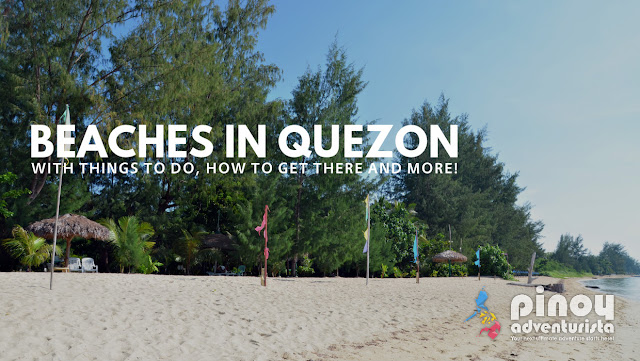
5. Beaches in Quezon
[ click here to search for hotels and resorts in quezon ].
.jpg)
6. Tagaytay City, Cavite
[ click here to search for hotels and resorts in tagaytay ].
- Bus Fare (Manila - Tagaytay) - PHP 120.00
- Food and other expenses - 500.00
- Transportation around Tagaytay - 100.00
- Bus Fare (Tagaytay - Manila) - PHP 120.00
- TOTAL - PHP 840.00
Where to Stay in Tagaytay?
- Taal Vista Hotel Tagaytay
- Summit Ridge Hotel Tagaytay
- The Lake Hotel Tagaytay
- One Tagaytay Place Hotel Suites
- Click HERE to Search for other Hotels in Tagaytay City
- Top Best Hotels and Resorts with Pool in Tagaytay
- Cheap, Budget Hotels and Hostels in Tagaytay for less than 500 pesos per night
- RIVERFRONT GARDEN RESORT IN MARAGONDON, CAVITE: Overnight Stay, Day Tour, Room Rates, Entrance Fee, How to get there and More!
- BUHAY FOREST, “Cavite’s Newest Tourist Spot in Magallanes Cavite!”

7. Beaches in Batangas
[ click here to search for hotels and resorts in batangas ].

8. Climb Mountains near Metro Manila
- Taal Volcano | Talisay, Batangas
- Mt. Talamitam | Nasugbu, Batangas
- Mt. Gulugod Baboy | Mabini, Batangas
- Mt. Manalmon | San Miguel, Bulacan
- Mt. Tagapo | Talim Island, Rizal
- Mt. Pundaquit | San Antonio, Zambales
- Mt. Kalisungan | Calauan, Laguna
- Mt. Batulao | Nasugbu, Batangas
- Mt. Maculot | Cuenca, Batangas
- Mt. Manabu | Sto. Tomas, Batangas
- Mt. Pico De Loro | Ternate, Cavite
- Mt. Romelo | Siniloan, Laguna
.jpg)
9. Witness a Festival
.jpg)
10. Pagsanjan Falls (aka Cavinti Falls)
[ click here to search for hotels and resorts near pagsanjan falls ].
- Bus Fare (Pasay to Sta Cruz, Laguna) - PHP 140.00
- Jeepney Fare (Sta. Cruz to Cavinti) - PHP 27.00
- Tricycle to Pueblo El Salvador - PHP 60.00
- Entrance Fee - PHP 270.00
- Food Expenses - PHP 250.00
- Tricycle to Cavinti Proper - PHP 60.00
- Jeepney Fare (Cavinti to Sta. Cruz) - PHP 27.00
- Bus Fare (Sta Cruz, Laguna to Pasay) - PHP 140.00
- TOTAL - PHP 974.00
I hope these trips near Metro Manila for under 1,000 pesos will help you plan your next adventure! Let me know how you enjoyed these destinations!
Read more - summer destinations series.
- Summer Destinations near Manila for Kids
- Beaches near Manila for less than 1,000 pesos Budget
- 10 Recommended Summer Destinations in the Philippines with Cool Climate
FOLLOW MY ADVENTURES ON YOUTUBE @PinoyAdventurista
2 comments :.
Very Helpful
your content is awesome keep it up
Looking for Budget Travel Guide Blogs, Hotel Reviews, and Sample DIY Itineraries? Welcome to Pinoy Adventurista, "Your Next Ultimate Adventure Starts Here!" Pinoy Adventurista is one of the Top Travel Blogs in the Philippines and the World. In 2013, he visited all the 81 provinces in the Philippines.
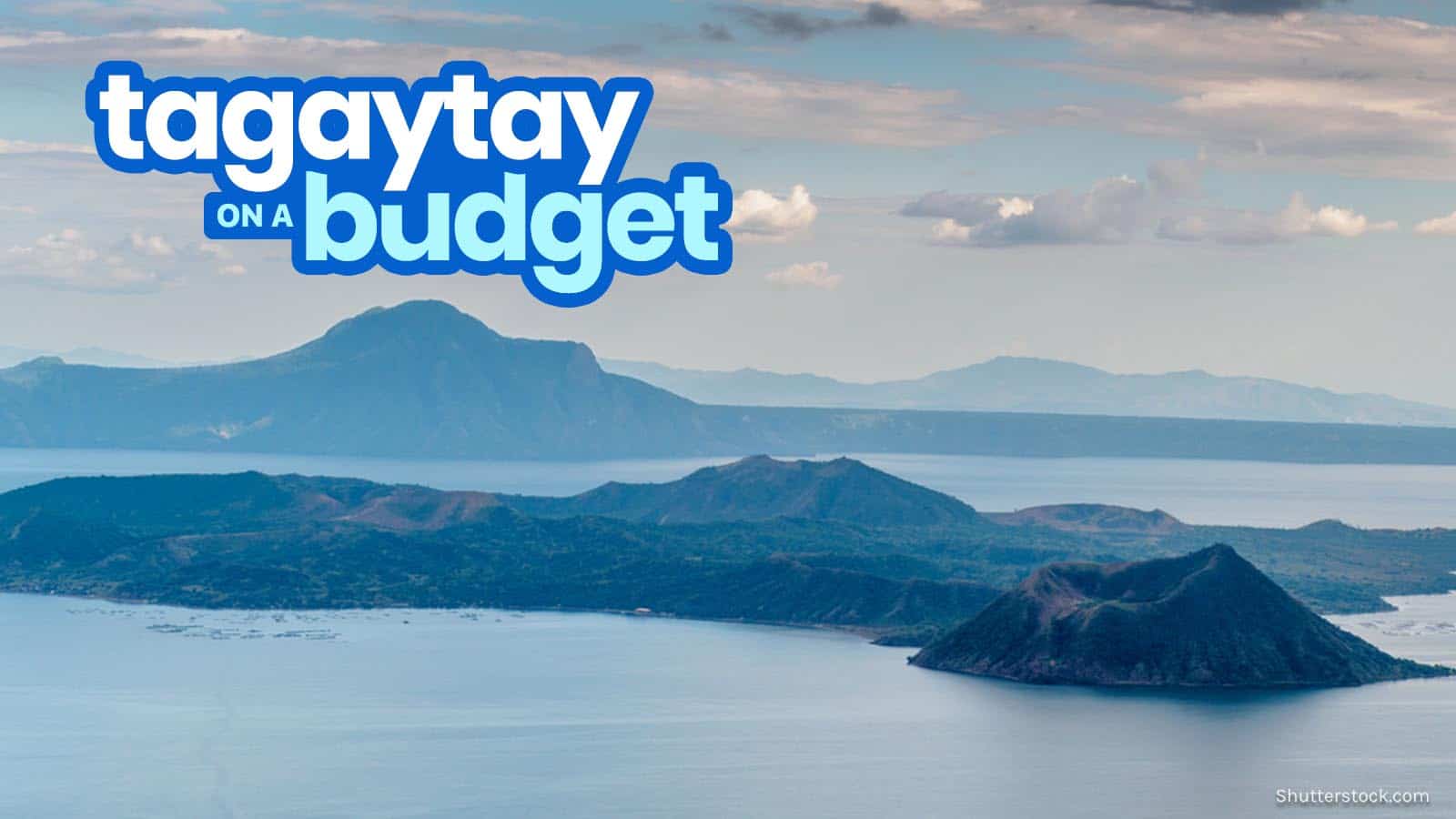
TAGAYTAY TRAVEL GUIDE with Sample Itinerary & Budget

Long before Manila-dwellers began a long-distance affair with the highlands of Baguio, Sagada and Kalinga, they have been in a long-standing romance with Tagaytay. It’s not a high-maintenance relationship. The physical connection is there. It is geographically close, easily accessible, and it doesn’t demand too much time or money. It’s the kind that will last over more decades.
Tagaytay is no stranger to me. I live in a Batangas town not too far away from Tagaytay. For the longest time, every time I would come back home, the van that I was riding would drive through the city. And since I started earning on my own, it would be my go-to place for clarity or peace of mind. And I’m not alone in this.
WHAT'S COVERED IN THIS GUIDE?
UNDERSTANDING TAGAYTAY
Located just around 60km from Manila, Tagaytay City has always been the go-to destination for those wishing to escape the searing heat of the capital, especially in the summer season. They come here for two reasons: a cooler climate and a breathtaking view of Taal Lake and Volcano.
Most people think that Taal Volcano is the small cratered hill on one end of the island in the middle of the lake often depicted in postcards and photographs. The truth is, that is Binintiang Malaki , just one of the volcano’s many cones and craters. Taal Lake itself was actually the caldera of an enormous ancient volcano formed after cataclysmic eruptions in the prehistoric times. The only active part now is that island in the middle of the lake called Volcano Island .
Like a giant balcony with a fantastic view, Tagaytay is perched on the northern ridges of Taal Lake, attracting thousands of vacationers and supporting its massive tourism industry. Its highways and inner alleys are lined with a wide array of accommodations, from luxury villas to budget hotels, and restaurants, ranging from fine dining to its homegrown fast food places.
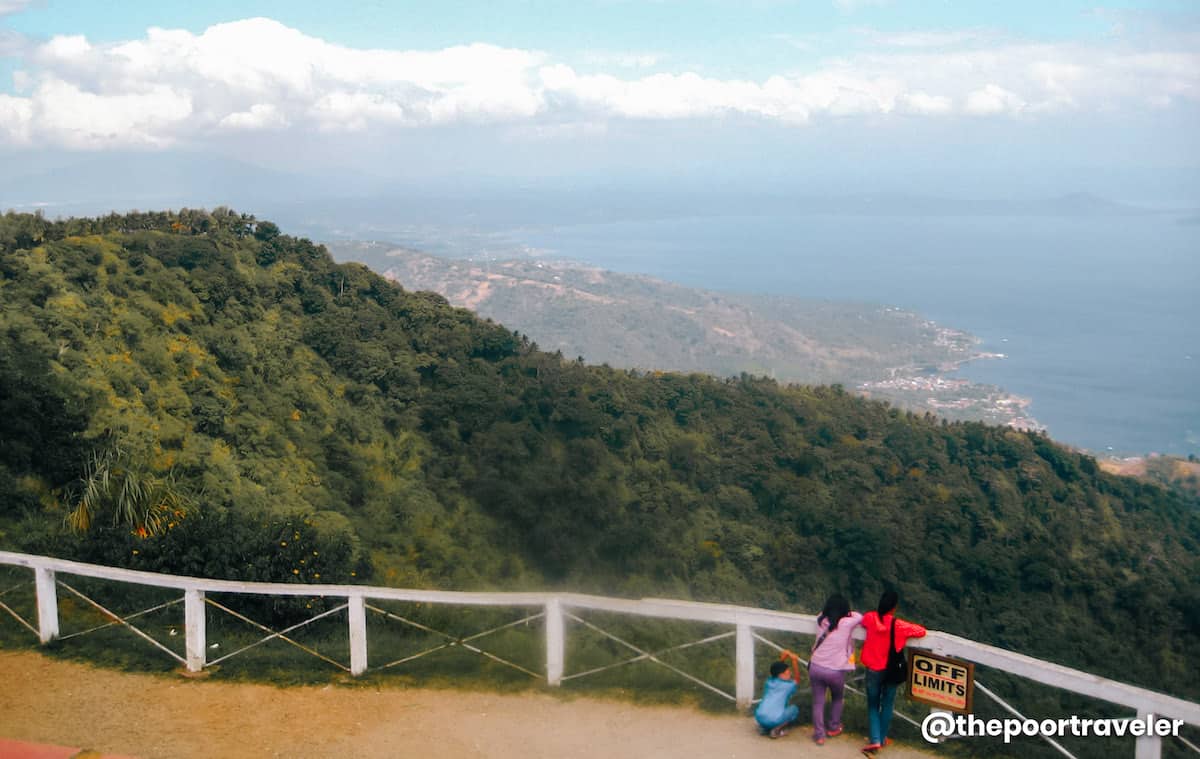
Tagaytay is also a great base for travelers who wish to explore neighboring municipalities like Alfonso and Amadeo, and even parts of Batangas like the volcano itself, Nasugbu, and Lemery.
Tagaytay takes a rectangular shape on the map, so it’s easy to navigate. At the very center of it is the Tagaytay Rotonda, from which stems out four main roads:
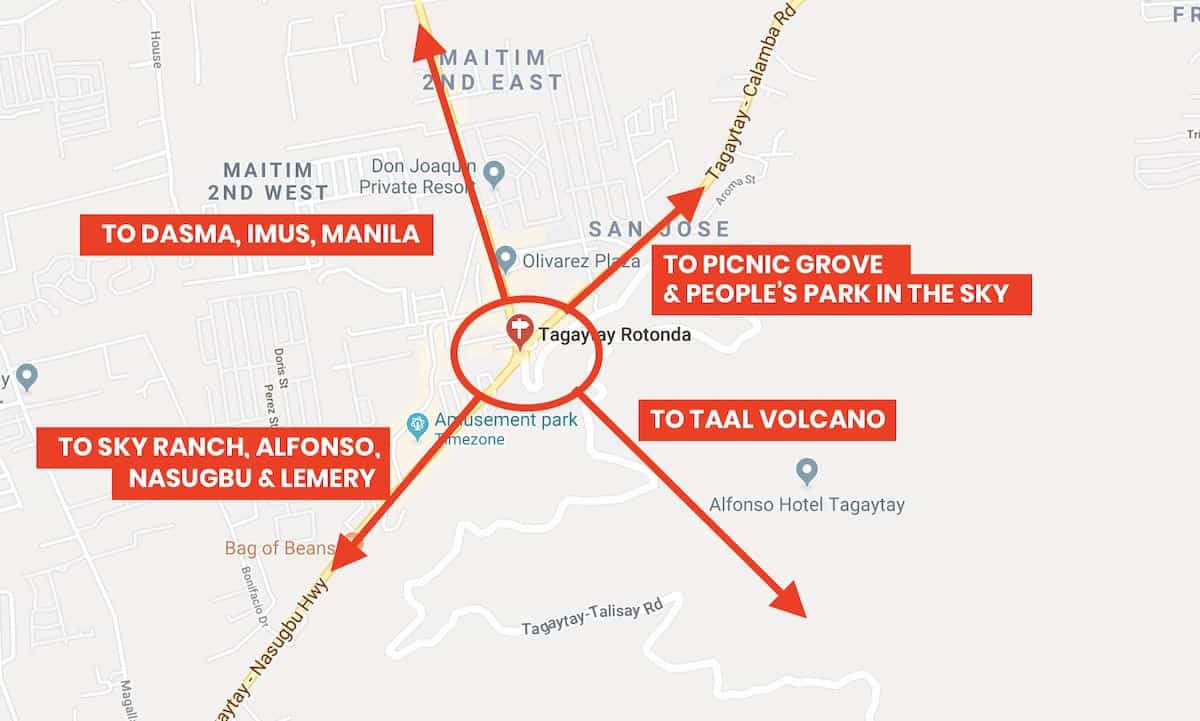
- Emilio Aguinaldo Highway , which connects Tagaytay to Imus, Dasmarinas, and Manila.
- Tagaytay-Calamba Road , which links the city to the towns of Laguna. If you’re coming from South Luzon Express Way (SLEX), you’ll eventually hit this road going to Tagaytay.
- Tagaytay-Nasugbu Highway , which can take you to Alfonso (Cavite) and Nasugbu and Lemery (Batangas).
- Tagaytay-Talisay Road , which cuts across a forested slope to Talisay (Batangas), where Taal Volcano is located.
Being familiar with these roads will make your travel planning a lot easier, especially when picking a hotel and places to visit.
Here are more useful bits about Tagaytay.
- Language: Tagalog is used by most. But English is widely understood and spoken.
- Currency: Philippine peso (PHP, ₱). PHP100 is around USD 1.90, EUR 1.69, SGD 2.57 (as of April 2019).
- Modes of payment: Credit cards are accepted by many establishments but CASH is still king (and queen) in Tagaytay.
- Electricity Info: 220V, 60Hz. Plug and socket Type A.

WHERE TO STAY IN TAGAYTAY
In places like El Nido or Batanes, I usually don’t mind staying in a guest house with no view and no frills because I would be spending much of my time outside anyway. But Tagaytay is one of those destinations where accommodations can make or break a trip. It’s all about the ambience and the experience. Whether you’re visiting Tagaytay to unwind, attend a conference, or have a romantic weekend, it is important to consider the location.
Best Area to Stay in Tagaytay
Tagaytay has become a major tourist magnet that it has become almost synonymous with this corner of Cavite. Property-owners often market and label their hotels, lodges or guesthouses “Tagaytay” even when they are technically located in surrounding municipalities like Alfonso, Silang, and Mendez. Try to keep that in mind when searching for a place to stay.
For tourists, there are three main areas that are great bases when exploring Tagaytay and nearby towns:
- Tagaytay Rotonda Area. Often casually referred to as simply Olivarez. It is the center of the city. As explained above, the major roads running across the city start or end here. It is surrounded by countless lodging and dining options. It is also the main transportation hub.
- Along Tagaytay-Nasugbu Highway. This is a little bit farther than the Rotonda area, but this has the best view of the lake and the volcano, provided that you book a hotel on the lakeside. This is also where SkyRanch and Ayala Malls Serin are located.
- Along Tagaytay-Calamba Road. This area is closest to tourist spots like Tagaytay Picnic Grove and People’s Park in the Sky. Lots of restaurant and hotel options too, with some also offering a good view of the lake.
Personally, I like staying along Tagaytay-Nasugbu Road because it’s a lot quieter and has the best view of the lake. If you don’t trust my word, here are the top budget hotels in Tagaytay as scored by Agoda users.
Top Budget Hotels and BnBs in Tagaytay
The best hotels in Tagaytay are expensive, but there are some exceptions. Bed-and-breakfast places also offer a great alternative. Here’s a list compiled using Agoda reviews.
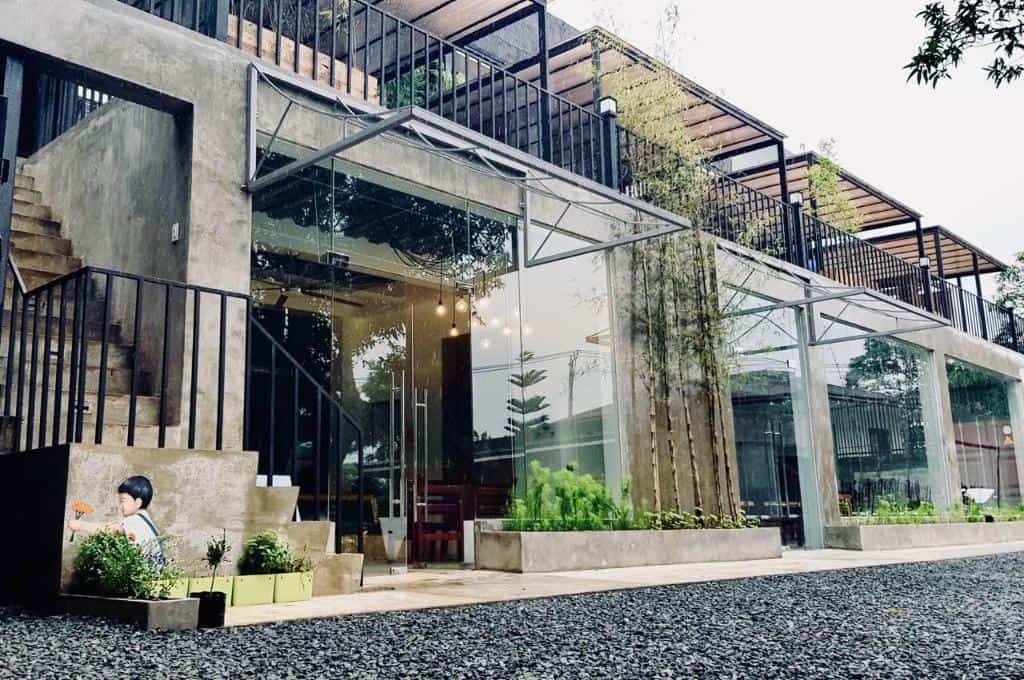
- Containers by Eco Hotel. Check Rates & Availability!
- F8 Bed and Breakfast. Check Rates & Availability!
- The Carmelence Lodge. Check Rates & Availability!
- Joaquin’s Bed and Breakfast. Check Rates & Availability!
- ZEN Rooms Hotel Georgina Tagaytay. Check Rates & Availability!
Top Apartments and Condo for Rent in Tagaytay
If budget is an issue, then ditch the hotel and consider staying at a BnB, guesthouse, or apartment for rent, which are significantly cheaper. There’s been a considerable number of condo units for rent at Wind Residences (SMDC) along Tagaytay-Nasugbu Highway and Tagaytay Prime Residences near Rotonda. Here are the top rated apartments/condo units on Agoda.
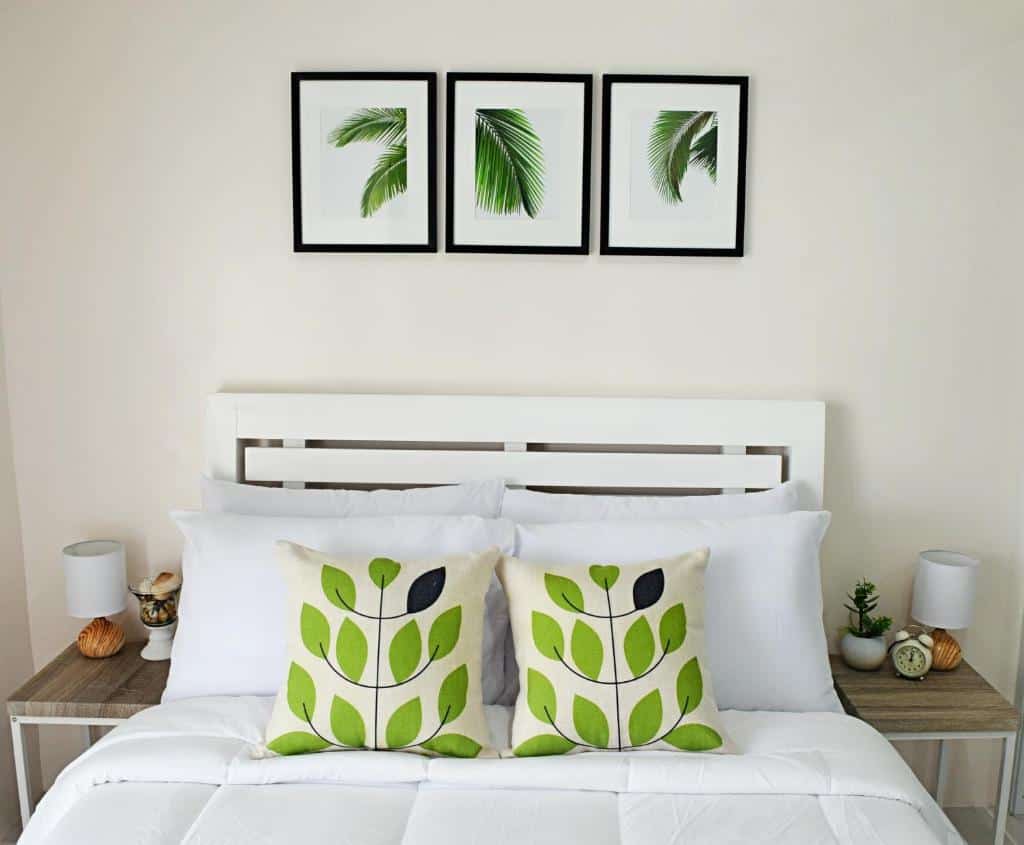
- An Oasis in Tagaytay. Check Rates & Availability!
- Sky’s at Prime Residences -Tagaytay. Check Rates & Availability!
- CatherinePlace Tagaytay – Wind Residences Tower 3. Check Rates & Availability!
- Wind Residences by Missionarte. Check Rates & Availability!
- Mary’s Crib Tagaytay. Check Rates & Availability!
Photos above were provided by the resorts via Agoda.
Search for more Tagaytay Hotels!
How to get to tagaytay, manila to tagaytay by bus.
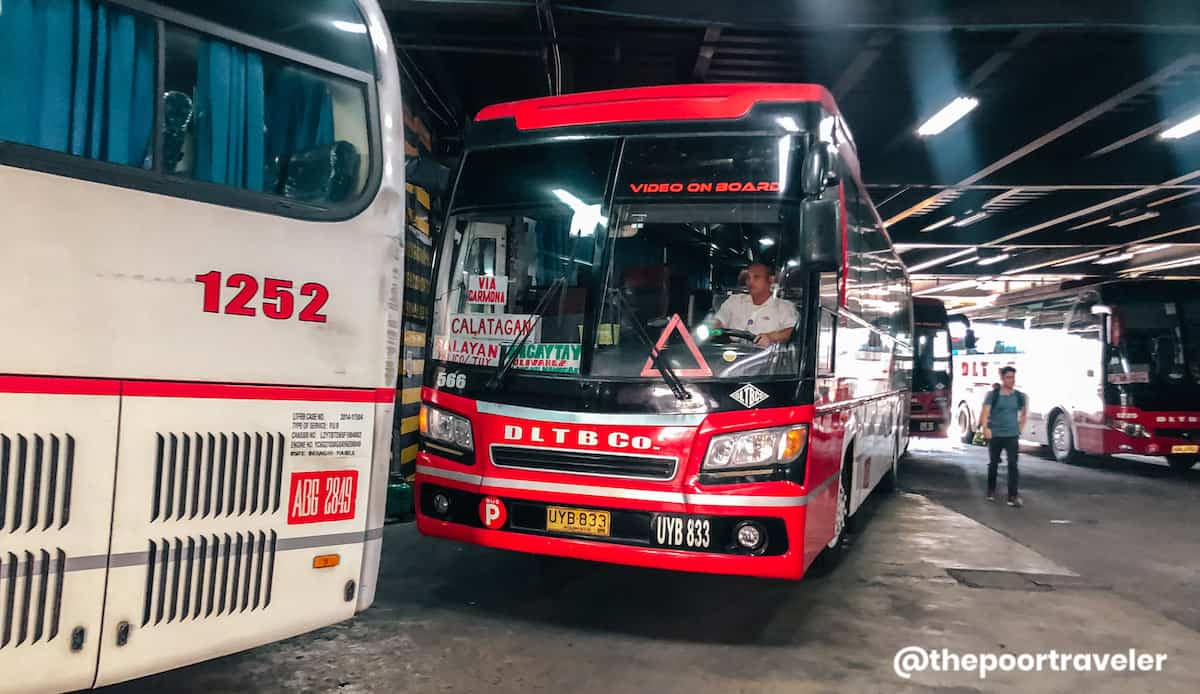
You can catch a bus to Tagaytay at the following terminals.
- Uniwide Coastal Mall in Paranaque. Make your way to the Paranaque Integrated Terminal Exchange (PITX), also called South West Integrated Provincial Terminal. Board a bus bound for Tagaytay, Mendez (neighboring town), or Nasugbu. This bus will be taking Emilio Aguinaldo Highway.
- DLTB Terminal at LRT Buendia area (near LRT Gil Puyat Station), Pasay City. Board the bus bound for either Nasugbu or Calatagan. This will be taking South Luzon Expressway (SLEX) and Carmona Exit and will pass through Tagaytay.
Fare: Around P87. Travel time is 2-3 hours, depending on traffic conditions. Might be much longer during rush hour.
Some important reminders.
- DO NOT TAKE THE BUS TO LEMERY. Lemery-bound buses take the SLEX + STAR Toll. It doesn’t pass through Tagaytay. Buses are not allowed to take Diokno Highway, which connects Tagaytay and Lemery. I know this because I’m from Lemery and our house is very close to Diokno Highway.
- If your hotel is located along Tagaytay-Nasugbu Highway and you’re on a Nasugbu or Calatagan bus, you don’t need to get off at Olivarez or Rotonda. You can stay in the bus and tell the conductor to drop you off at the hotel.
- If you’re going to SkyRanch or Wind Residences , there’s a big chance the bus will not really pass by either even if the driver or conductor says so. Most buses take Mahogany Avenue, which bypasses a section of Tagaytay-Nasugbu Highway approaching Mendez. Instead, they will drop you off at the Petron Gas Station. That’s okay, though, because it’s within walking distance. (SkyRanch is a longer walk but very manageable.) SEE MAP BELOW.
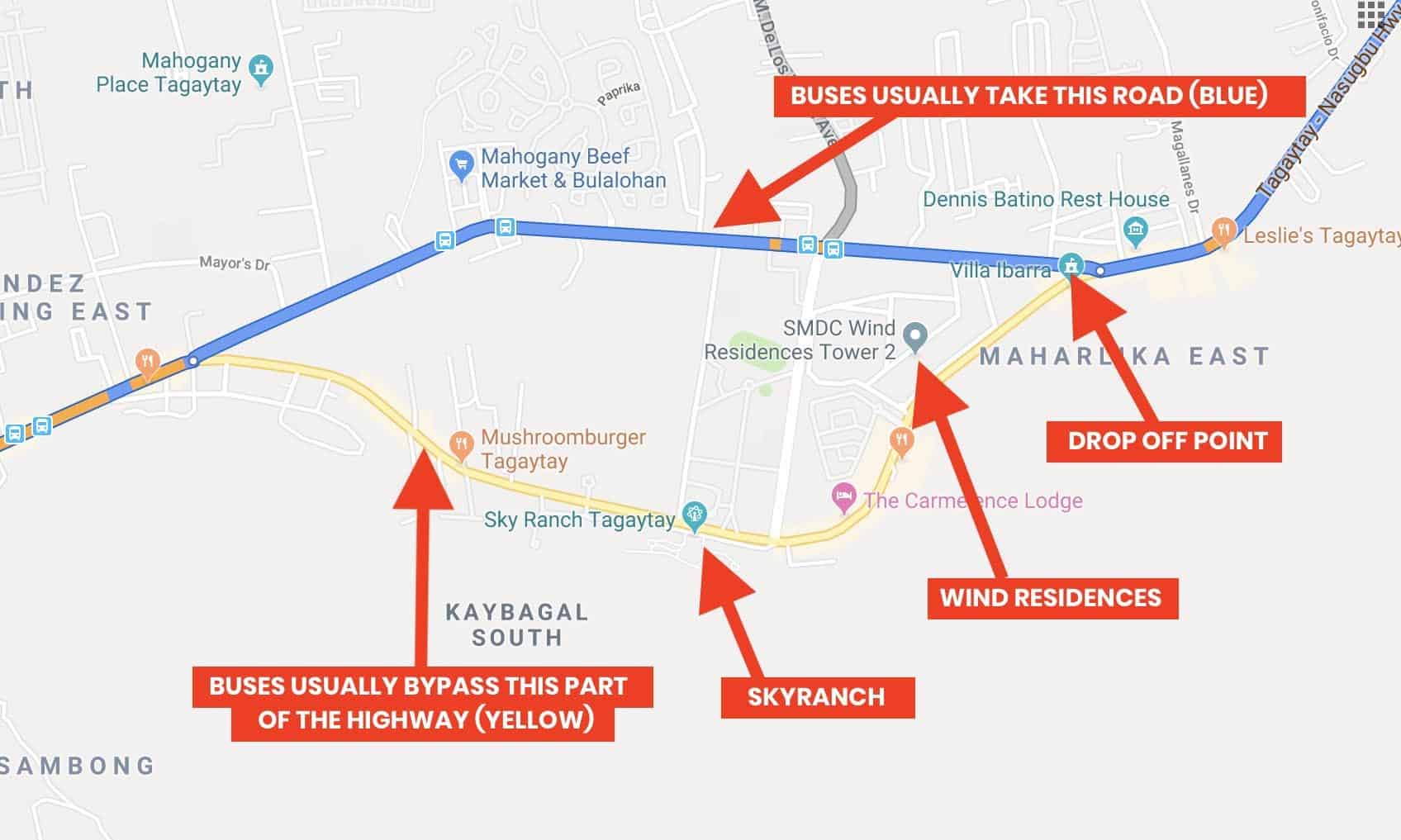
Manila to Tagaytay by Van
You can also ride a shared van to Tagaytay. Vans bound for Nasugbu, Calatagan or Lemery pass through Tagaytay. You can find one at the following places.
- Starmall EDSA-Shaw. You’ll find vans bound for Lemery at the terminal in front of the mall, along EDSA.
- Alabang. There are vans bound for Tagaytay at Festival Mall Alabang, near the Goldilocks exit. (I haven’t tried it, though.) In addition, there used to be vans bound for Lemery dispatched from the parking area of Starmall Alabang. But they already moved to the area behind the mall, near the ukay-ukay area and PNR Train counter. The number of available vans and passengers has been dwindling so you might be in for quite the wait.
- Metropoint Mall. I’m not sure if there are still vans here going to Calatagan. There used to be, but I haven’t checked in a long time. If there still is, you can take the van going to Calatagan. If vans no longer operate here, you can cross to the other side of EDSA and catch a bus to Calatagan instead.
Whatever you take, tell the driver to drop you off in Tagaytay.
Fare is P180-P200, depending on which part of Manila you’re originating. It’s pricier because vans behave like point-to-point shuttles. Even though you’re alighting in Tagaytay, you’re still paying for the full journey. A passenger getting off in Tagaytay pays the same as another getting off in Batangas.
Important reminders:
- If you’re taking a van to Lemery, tell the driver to drop you off in Tagaytay. Unlike their bus counterparts, Lemery-bound vans usually pass through Tagaytay. However, there are instances when the driver chooses to take the SLEX-STAR Tollway route. It usually happens when there is heavy traffic in Tagaytay/Santa Rosa areas. To be sure, let the driver know that your destination is Tagaytay so he won’t take any detour.
- Vans don’t follow any fixed schedule. The vehicle will NOT leave the terminal unless it is full. If you’re in a hurry and there’s only one vacant seat, you can pay for it and the driver will gladly start the journey. If time is of the essence and there are a lot of empty seats, take the bus instead.
HOW TO GET AROUND TAGAYTAY
There are no taxis in Tagaytay, and Grab doesn’t have any presence either. There are only three modes of transportation available:
- Jeepney. When traveling within the city, the most usual way is by jeepney. From Olivarez/Rotonda, you can take a jeepney to any direction. You can also ride one from any point along the highway back to the city center. Minimum fare is P9, which increases as you go father.
- Bus. You can also take the bus if you’re coming from Rotonda area and going to Mendez, Alfonso, Nasugbu or any destination along Nasugbu-Tagaytay Highway.
- Tricycle. This is the closest thing to a taxi that you can get. You can charter a tricycle to take you straight to your destination. When I asked, “special trips” within the city cost P100. Special, meaning you won’t be sharing the tricycle with anyone else. But if you’re going to the city center, you can pay the per-person charge, which should be around P20. Maybe higher or lower, depending on distance.
THINGS TO DO IN TAGAYTAY & NEARBY TOWNS
Taal volcano.
UPDATE! Taal Volcano recently erupted and is closed to the public.
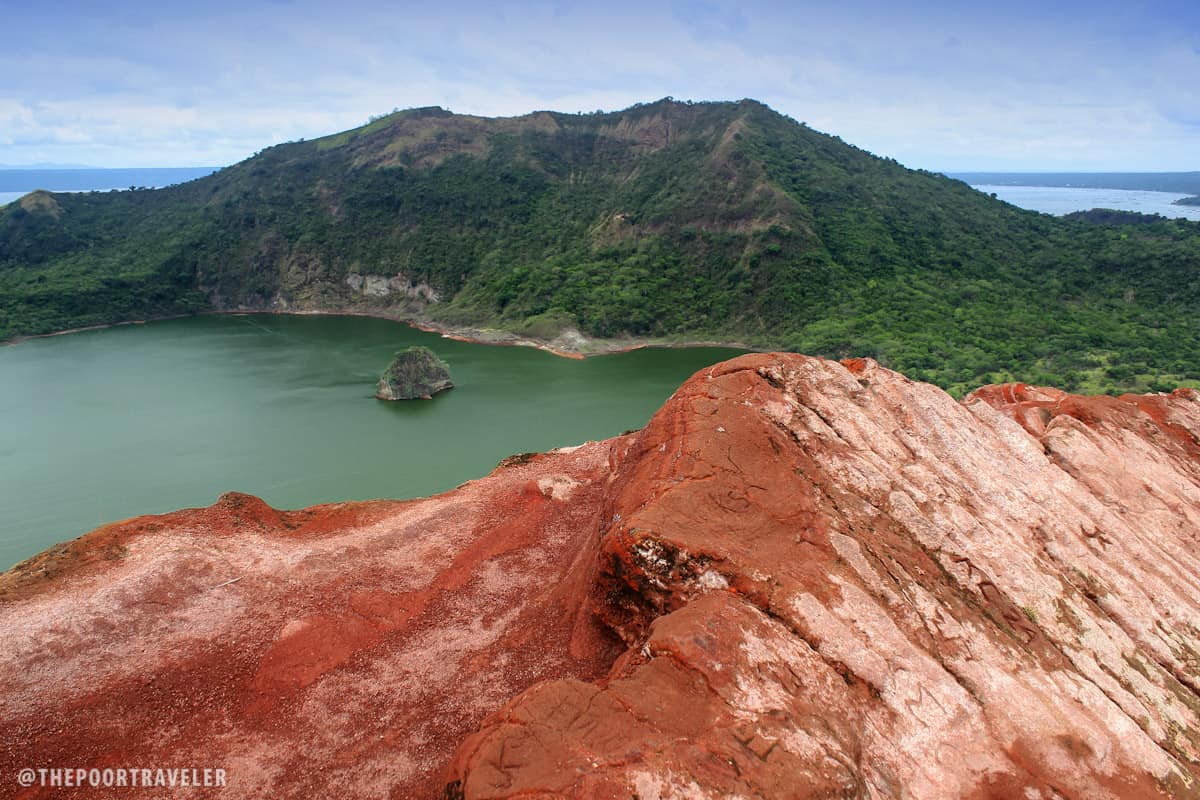
Tagaytay offers the best views of Taal Volcano. But you know what’s better than admiring it from afar? Being on the volcano itself. From Tagaytay, you can travel to the Batangan town of Talisay, where you can charter a boat that can take you to the volcano island. Once there, you’ll start your trek to the breathtaking caldera. Good if you’re a group so you could split the expenses.
How to get there: From Tagaytay, you can charter a tricycle to take you to Talisay for P150-200. Then, find a boat, which costs P2000 (maximum of 6 pax). It’s also possible to reach Talisay by jeepney, but I don’t have the details.
I’m not fully familiar with this route, to be honest. I’ve been to Taal Volcano and hiked to its main caldera before, but I didn’t come from Tagaytay. I went straight to Talisay via Tanauan.
SkyRanch Tagaytay
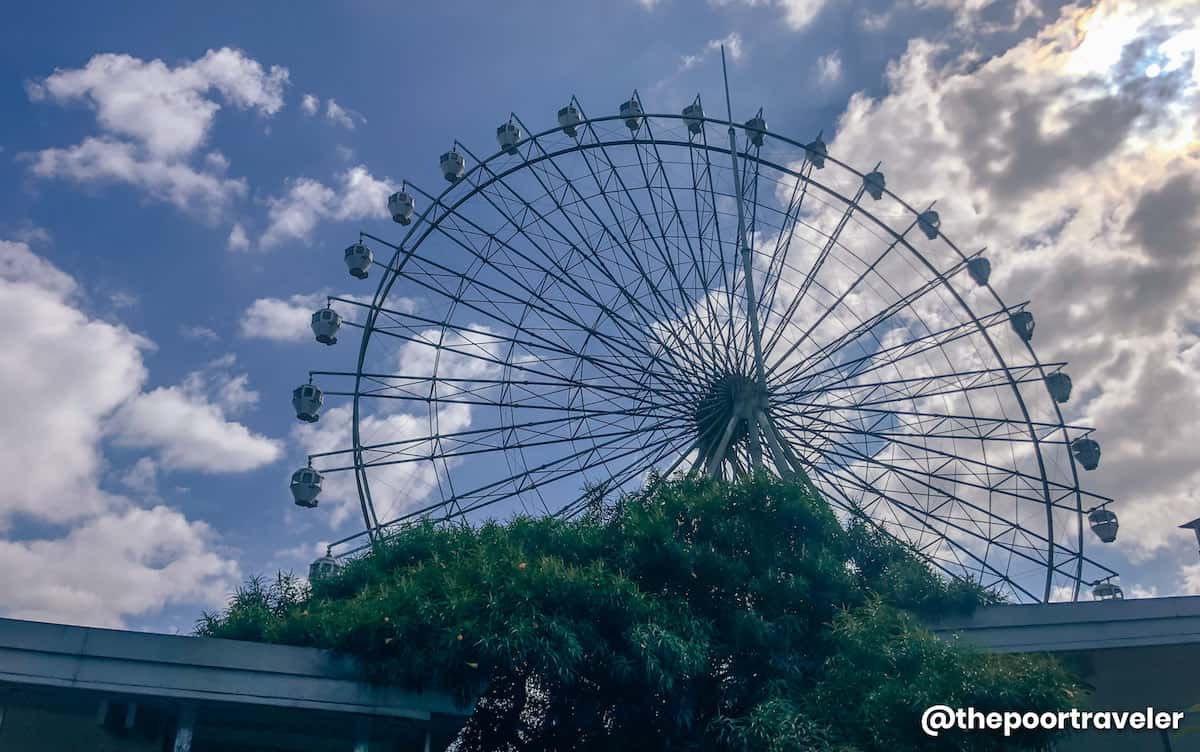
SkyRanch is a relatively new attraction in Tagaytay. Perched on a cliff, overlooking the lake, this is an amusement park built for the enjoyment of the whole family. There are rides for kids and activities for the kids-at-heart. The most arresting structure is the SkyEye , a 63-meter ferris wheel with 32 gondolas. It’s also lined with restaurants and food kiosks!
Hours open Monday-Friday, 10am-10pm Saturday-Sunday, 8am-10pm
Entrance Fee Weekdays: P80 Weekends: P100
Here are the attractions at SkyRanch and the corresponding admission fees.
SkyEye: P150 Super Viking: P100 Flying Bus: P100 Sky Cruiser: P100 Log Coaster: P100 Safari Splash: P120 Bumper Boat: P100 Bumper Race: P100 Drop Tower: P100 Express Train: P80 City Rail: P80 Mini Viking: P50 Racing Car: P50 Nessie Coaster: P50 Wonder Flight: P50 Red Baron: P50 Boat Parade: P50 Toy Swing: P50
How to get there: From Olivarez, ride a jeepney bound for Mendez or Nasugbu. Get off at Sky Ranch. Fare is around P15.
✅ MORE INFO HERE: SKY RANCH TRAVEL GUIDE
Tagaytay Picnic Grove
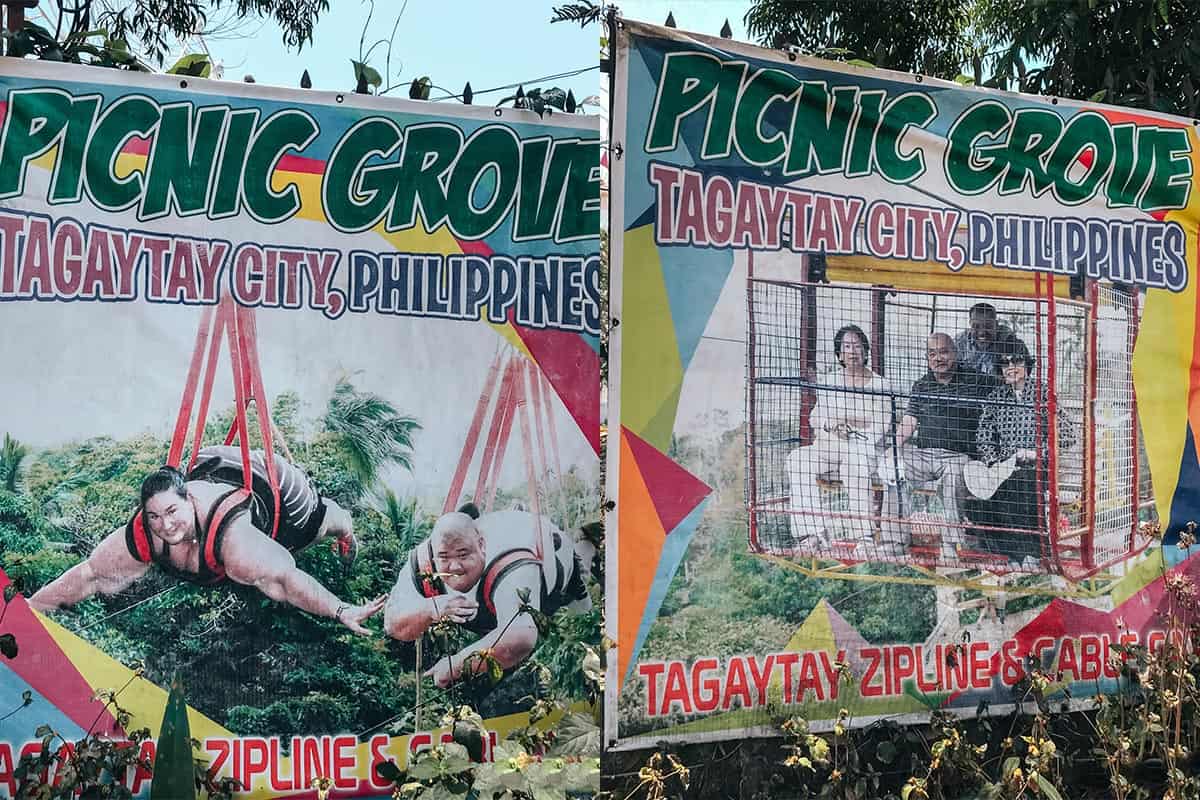
Another family-friendly park in Tagaytay. For the longest time, this was the go-to place for relaxation, but a lot has changed (or have not changed) over the years. More attractions like the zipline and cable car ride were introduced, which are great for families. I personally think the park itself has lost its main appeal. But check it out regardless.
Entrance fee: P50
Parking Fee: P35, cars; P50, vans or jeepneys.
Zipline & Cable Car Rates: Weekdays: 1-way ride, P200; 2-way ride, P300. Weekend/Holidays: 1-way ride, P300; 2-way ride, P400.
Hut/Cottage Rental: P100, P150, P300, P500
Operating hours: 7am-7pm
People’s Park in the Sky
It used to be known as Palace in the Sky. Built under Marcos in 1979, it was supposed to be a guest house for visiting US President Ronald Reagan. But due to turning political tides back then, the “palace” was not finished and the visit cancelled. After the EDSA revolution, the name changed to People’s Park in the Sky.
Today, it hasn’t been well-maintained but remains a top attraction in Tagaytay because of the fantastic vista. After all, it stands at the highest point of Tagaytay, allowing a 360-degree view of the surrounding landscape.
How to get there: From Olivarez, charter a tricycle for P150 for special trip or P50 per person.
Puzzle Mansion
Puzzle-lovers unite! The Puzzle Mansion in Tagaytay’s Barangay Asisan houses the world’s largest collection of jigsaw puzzles — all 1028 pieces of them — as certified by the Guiness Book of World Records. This was owned by Georgina Gil-Lacuna who collected these puzzles from her travels.
Entrance fee: P100
Hours open: 8am-5pm
How to get there: From Olivarez/Rotonda, ride a jeepney bound for Alfonso or Nasugbu. Get off at Brgy. Asisan. You can tell the driver to drop you off at the corner going to Puzzle Mansion. Fare: P15. Then hail a tricycle to take you to Puzzle House. Fare: P100.
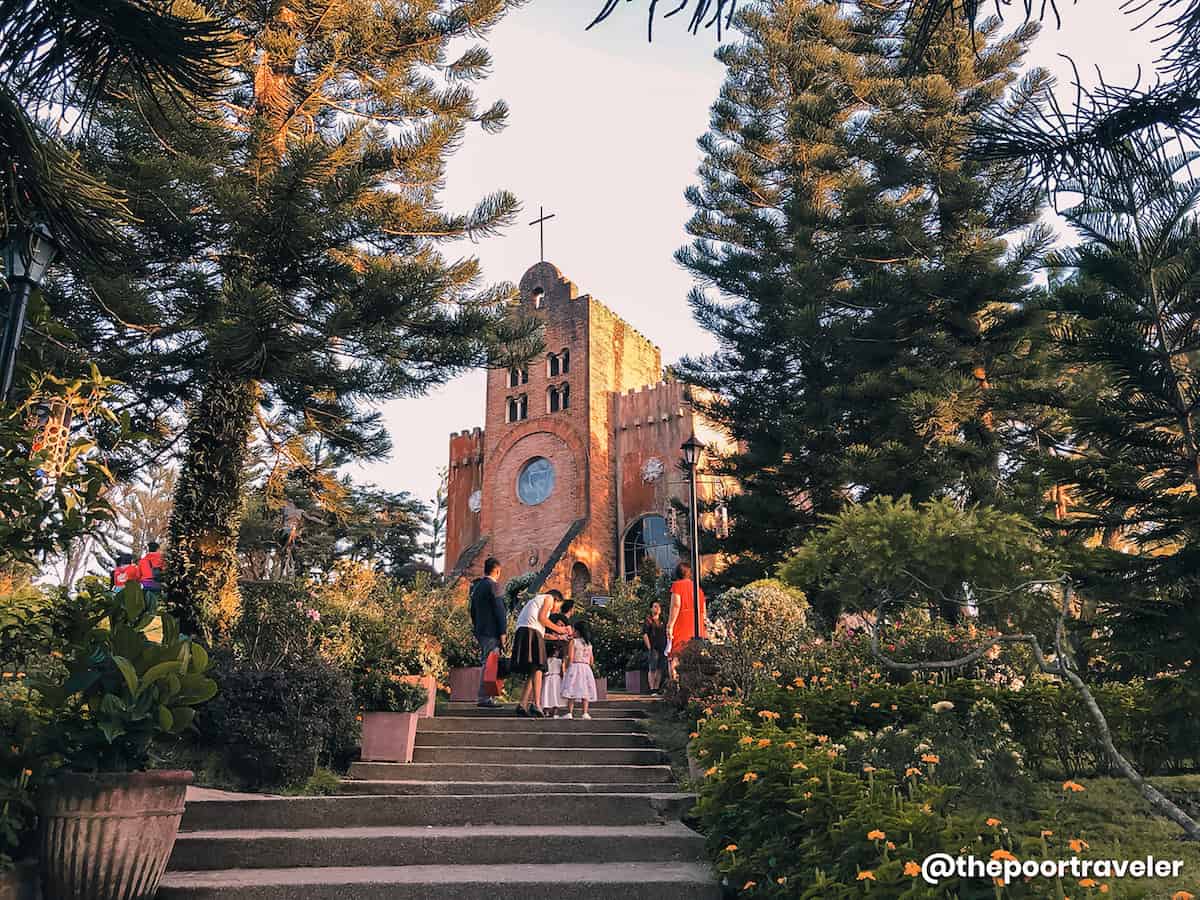
Caleruega is located in Nasugbu, Batangas, but it is easily accessible from Tagaytay. The place got its name from the municipality of Caleruega in Spain, the birthplace of the father of the Order of the Preachers, Saint Dominic de Guzman. It was built to serve as a venue for contemplation, but has made a name for itself over the years as one of the most well-known wedding venues in the country. It also harbors well-maintained retreat houses and well-manicured gardens.
How to get there: At Olivarez/Rotonda, take the jeepney bound for Nasugbu and tell the driver to drop you off at Hillcrest/Evercrest. Fare: P25. From KC Hillcrest entrance, hail a tricycle to Caleruega Chapel. Fare: P50.
More info: CALERUEGA TRAVEL GUIDE
Fantasy World
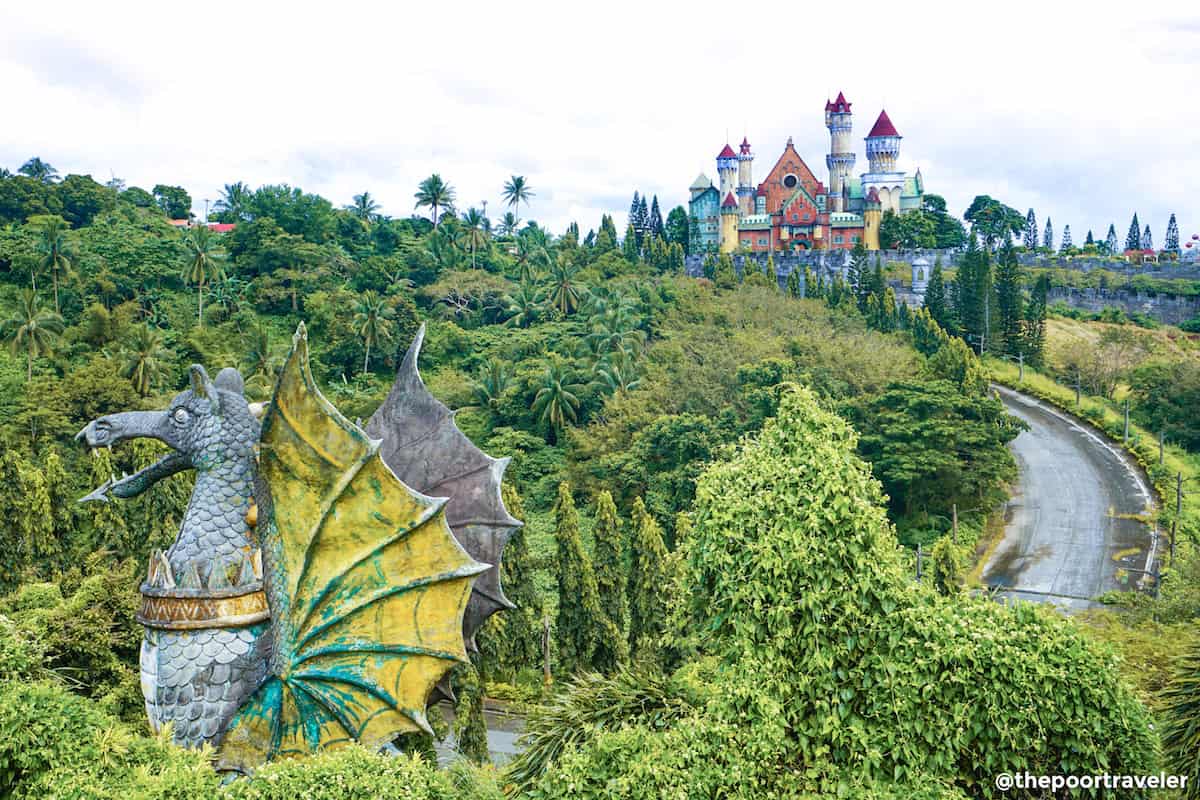
Fantasy World is an unfinished theme park project in the middle of the rolling hills of Lemery, Batangas. (Yep, it’s in Lemery!) Although the construction was halted, they were able to build the castle, which was the park’s centerpiece.
Over the past years, it has become a filming location for movies like Got 2 Believe (starring Claudine Barretto and Rico Yan) and Fantastica (Vice Ganda) and TV shows like GMA 7’s Majika (Angel Locsin, Dennis Trillo).
The rides are not operational, but the park and the castle remains Instagram-worthy. It’s a favorite prenup spot too.
Entrance fee: P100 per person. This used to be P1000 for a group of 10, but this has been changed in November 2019.
How to get there: From Olivarez, ride a jeepney or bus to Boundary (Cavite-Batangas boundary). Fare: P25 for jeepney, P39 for bus. At the boundary, ride a jeepney bound for Lemery and ask to be dropped off in front of Fantasy World. Fare: P18. If there are no jeepneys, you can take a tricycle but it’s pricey. Fare is P200 per ride (not per person).
Tip: There is a cafe nearby called “ Brewed For You .” If you’re visiting around lunch time or you just get hungry, you can stop by and have a bowl of Batangas lomi (P100) and a cup of kapeng barako (P40).
More info: FANTASY WORLD TRAVEL GUIDE
Tagaytay Food Trip
One of the things my cousins and I used to do when we were kids was count the number of restaurants when we were passing through Tagaytay. Many of them are standing strong to this day. From local bulaluhan to western restaurants to food parks to fast food chains, there’s no shortage of dining places in Tagaytay.
Leslie’s and Josephine Restaurant are two local favorites for families. Don’t forget to order a bowl of sinful bulalo! If you’re celebrating something special or you’re simply after ambiance and elegance, there’s Antonio’s Restaurant and Sonya’s Garden (farther in Alfonso).
Bag of Beans has also made a name for themselves for their generous servings of scrumptious dishes. Aside from their main branch along Mendez Crossing, they have five other branches now including one at Summit Ridge (near Robinson’s Supermarket and SM Wind Residences) and one near Silang Crossing (Athena). Try their roast beef!
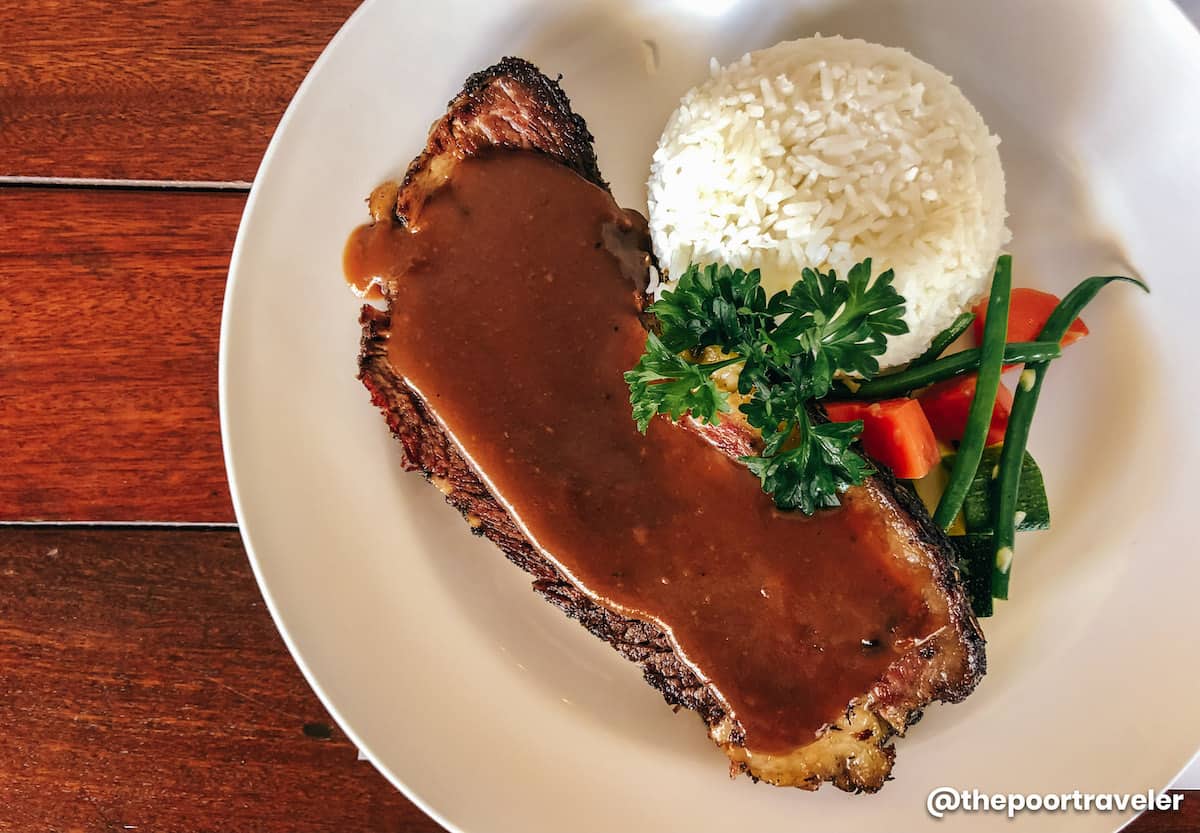
There budget-friendly places too. Mushroom Burger is the first that comes to mind. It’s a fast-food-style resto featuring mushrooms as their main ingredients. If you’re staying along Tagaytay-Nasugbu Highway, you can easily get here. If you’re coming from SkyRanch, it’s just a 10-minute walk away.
SAMPLE TAGAYTAY ITINERARY
Below is a sample overnight Tagaytay itinerary, good for a weekend. It assumes you’re a party of two, splitting some of the costs and taking public transportation from Manila.
DAY 1: CALERUEGA & FANTASY WORLD 05:00 am – Bus to KC Hillcrest (Nasugbu), P130 08:00 am – Tricycle to Caleruega, P25 (P50/2pax) 08:15 am – Caleruega Entrance Fee, P30 10:30 am – Tricycle to Boundary, P50 11:30 am – Jeepney to Fantasy World, P18 12:00 pm – Lunch at Brewed For You Coffee Shop, P300 01:00 pm – Fantasy World, P100 03:00 pm – Jeepney back to Boundary, P18 03:30 pm – Bus to Tagaytay, P39 04:30 pm – Hotel check in, rest 06:30 pm – Dinner, P200
DAY 2: SKYRANCH & PICNIC GROVE 07:30 am – Early check out 08:00 am – Jeepney to Picnic Grove 08:30 am – Picnic Grove, P50 09:00 am – Zipline, P300 10:30 am – Jeepney to Olivarez 10:45 am – Jeepney to Mushroom Burger 11:00 am – Lunch at Mushroom Burger, P150 12:00 pm – Walk to SkyRanch 12:15 pm – SkyRanch, Budget: P500 03:00 pm – Jeepney to Olivarez 04:00 pm – Bus back to Manila, P87
If you spend P2400 on accommodations (P1200 per person), the itinerary above will set you back around P3400 (USD 67, SGD 90, EUR 60) per person, with some allowance for incidental expenses.
Note that the bulk of the cost is the zipline, which costs P300 on weekdays and P400 on weekends. If you’re not interested in this, you can skip this too.
If you decide to skip Fantasy World and Zipline, the total cost will be pushed down to only around P2800 (USD 54, SGD 73, EUR 48) per person.
If you want to keep track of your expenses when traveling around Tagaytay, download the LISTA app! It’s a mobile app that will help you watch your spending so you know you’re not going over your set budget and avoid running short of funds! It was originally meant for small businesses, but guess what? Travelers can use it, too!
All you need to do is enter how much budget you have for the trip and as you explore, type your expenses. The app will do the rest. It will tell you how much you still have left. It works offline so no internet connection needed.
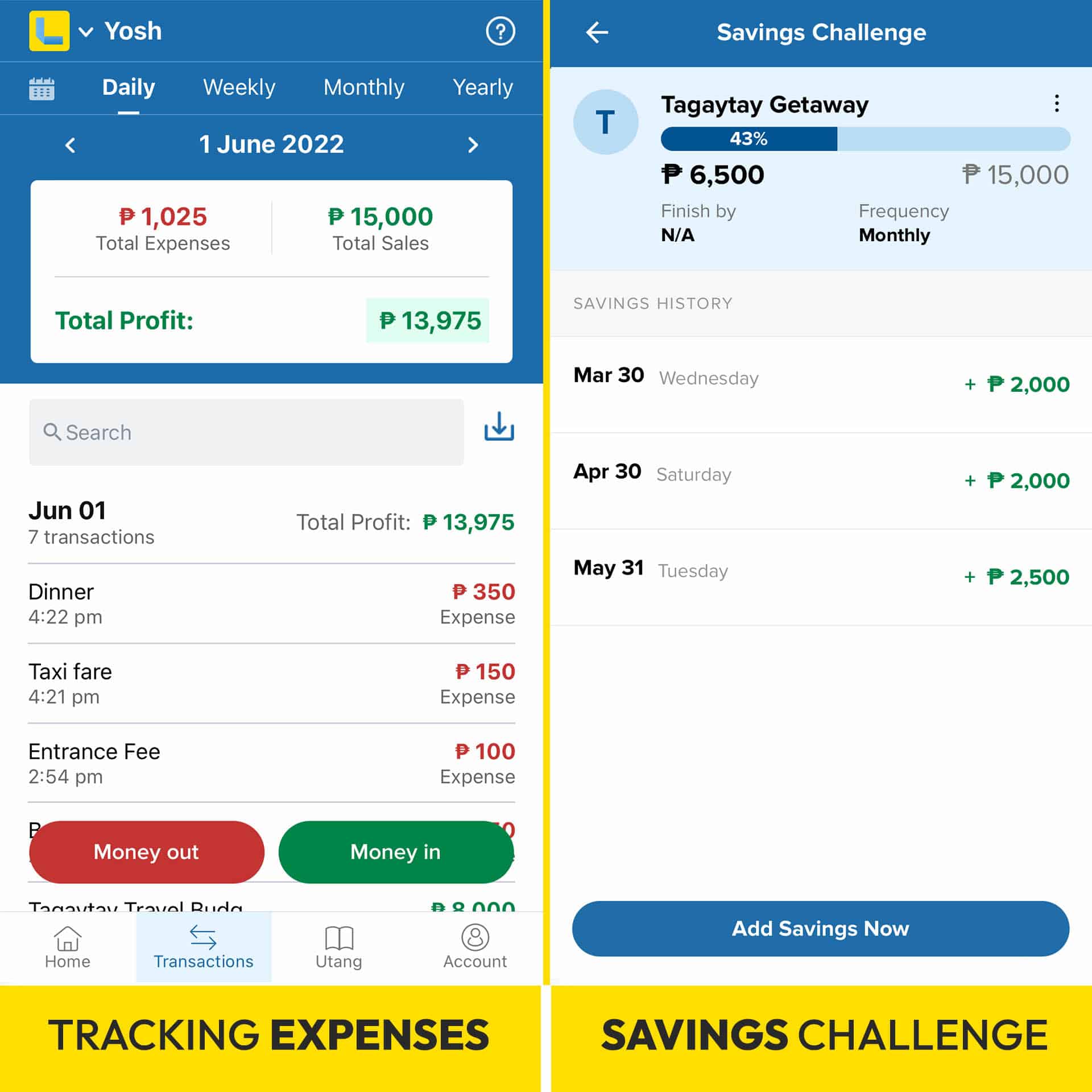
Another key feature is the SAVINGS CHALLENGE! Using the LISTA app, you can set a target amount and the frequency you’re comfortable with so you know when you’re financially ready to make your next Tagaytay getaway happen!
Excited for your next trip? I-LISTA na ‘yan!
✅ DOWNLOAD LISTA HERE!
2️⃣0️⃣1️⃣9️⃣ • 4️⃣ • 1️⃣7️⃣
More Tips on YouTube ⬇️⬇️⬇️
Is this post helpful to you?

Related Posts:
- Tagaytay: People’s Park in the Sky
- Manos Greek Taverna: Where to Eat in Tagaytay City, Philippines
- HOW TO GET TO TAGAYTAY: Manila to Sky Ranch, Olivarez & Wind Residences
- 30 TAGAYTAY TOURIST SPOTS & THINGS TO DO
- TWIN LAKES TAGAYTAY: Restaurants, Opening Hours & New Normal Guidelines
- BALAY DAKO TAGAYTAY New Normal Travel Guide + Menu
- PINK SISTERS TAGAYTAY: Travel Guide, Mass Schedule, How to Get There
- LA VERYOL’s KAWA BATH TAGAYTAY Travel Guide

- Recent Posts
- 2024 Philippine Airlines PROMO: Get 50% OFF on PAL Domestic Flights! - 16 May 2024
- 2024 NAIA Departure Guide for International Passengers (Manila Flights) - 10 May 2024
- 2024 Cebu Pacific Promos & PISO SALE with Number of Seats Available - 10 May 2024
Any more helpful detailed instructions other than “van terminal near the station” for LRT Gil Puyat? Would like to find that FX terminal. (By the way, no signs for visiting commuters that says LRT Buendia, just LRT “Gil Puyat”.) Second question: do you know that the DLTB terminal there is still running services from that terminal to Tagaytay, and have not been moved to PITX?
Hi! We checked again today and found that there are no longer vans bound for Lemery near the LRT station. But the DLTB bus terminal still operates there.
We’ll update the post accordingly.
Thanks so much for checking that question about Tagaytay transport from around LRT Gul Puyat.
Planning to organize a trip. We’re heading from Cagayan Valley. 3D2N in Batangas + Tagaytay. Asking for ur help.
From Ortigas, I’ll be heading to Hill’s Creek Garden (Alfonso, Tagaytay). Please recommend the best route (for commute).
Will appreciate your feedback.
Hi, am trying to find an easier way with least transfers to get from Wind Residences in Tagaytay to Anilao. Would you happen to know of a good route?
Hi, I’m a fan po! :) We’ll be going to tagaytay from Taytay, Rizal (commute). Do you where we can ride po? Thank you so much!
Di ko po alam. Di po ako familiar sa byahe from Taytay. :(
This is a very helpful post. Especially regarding the route buses usually take (Mahogany) as plenty of tourist visit Sky Ranch.
Hi. If I will be coming from SM Mall of Asia, where will I ride a bus to tagaytay? And is there a bus station in tagaytay to manila?
Hi. We’re going to tagaytay this Dec 26th. May available po kayang transpo? Bus or Van?
Hi! We’re also going to tagaytay next week. Meron pong bus from PITX going tagaytay. Meron din sa buendia na nag wawait sa harap ng mcdo. Para sure po try asking customer service sa PITX. Hope this helps! :)
I have read lots and lots of articles on this subject and yours really stands out thank you.
We plan for Tagaytay this Saturday, January 23, 2021.. any body please tell us if there’s any restriction to be avoid..we start from Monumento Caloocan City…we have our own vehicle..
hello po, ask ko lang po sana kung operational pa yung mga van sa starmall edsa crossing papuntang tagaytay?
Is dog allowed in all the destination spot on tagaytay…and also dogs are allowed in vans and buses…thank u
Featured On

We heard you!
Your comment is now queued for moderation! We’ll try to get back to you soonest. While waiting, follow us on these channels.
Subscribe on Youtube! Follow us on Instagram!


Summer Travel 2024: 7 Ways To Afford Your Vacation With Rising Costs
I n this year’s Summer of Savings survey, GOBankingRates found that 76% of people have had their summer travel plans impacted by inflation . A little over half of respondents said they’re opting for a more affordable vacation, like a staycation, than what they’d initially planned. Roughly 25% of those surveyed indicated they aren’t going to take a vacation at all because of rising costs.
Check Out: 3 Places To Travel That Are Like Hawaii but Way Cheaper
Learn More: How To Get $340 Per Year in Cash Back on Gas and Other Things You Already Buy
Many people who do still plan to take a trip somewhere are looking for ways to cut costs. For example, a little over half of respondents said they’ll drive rather than use any other sort of transportation — like airplanes or cruises. Nearly one-quarter said they’ll stay at a friend or family member’s home to save money on accommodations.
Along with this, most people responded that they’re trying to keep their travel budget to under $2,000 this summer. Only about 14% indicated their travel budget exceeds $2,000.
While inflation’s impact on travel can’t be denied, there are still ways to make travel more affordable this year. Here are the big ones, according to experts.
Choose an Affordable Destination
“Part of it is planning and picking an affordable destination,” said Echo Wang, CEO and founder of Cool Travel Vibes . “Popular spots come with a price tag.”
As Wang pointed out, lesser-known or less popular destinations often have the added benefit of being less crowded. Plus, you’re more likely to experience the local charm without so many other tourists around.
Be Aware: Dave Ramsey: 7 Vacation Splurges That Are a Waste of Money
Stay Somewhat Local
Airfare has risen substantially in the past few years, thanks to inflation. One way to save money on your vacation is to stick with places that don’t require a plane ticket.
“Ditch the plane and drive,” said Janice Moskoff, a travel expert at Gather and Go Travel . “In addition to saving on airfare, you will likely save on rental cars, especially if you plan to drive your own vehicle.”
The money you save on airfare could be put toward other things, like experiences or accommodations. Or you could flat out save it. And if you don’t drive too far away, you can even save on gas.
But if you still want to fly somewhere, being flexible with where you go could be key to affording rising costs.
“Go where the airfare is the most affordable,” Moskoff said. “Use free tools, like open-ended airfare search tools like Google Explore or price drop alert emails from memberships from sites like Going to discover the best flight deals.”
Take Things Slow
“Instead of jet-setting from one destination to another, like multiple cities on a European trip, use one place as a base and do day trips,” Moskoff said. “Then, take advantage of trains, buses, and public transportation to get around. Although doing this may take more time, you will still see a great deal, get to know one region exceptionally well, and happily, save a ton.”
This method works even better if you find a great deal on accommodations wherever you go. For instance, if you can stay at an inexpensive — but safe and clean– motel or with someone you know, you might be able to offset the costs of traveling slowly this way.
According to The Hotel Monitor, hotel rates are expected to rise by as much as 17.5% in certain cities over the course of 2024. Steer clear of expensive hotels or Airbnbs though, as these can cut into your travel budget quite a bit. Instead, check out local hostels and see if they offer any discounts for longer stays.
Stick With Cheap or Free Activities
The average rate of inflation was 4.1% in 2023. This means that the cost of everyday goods and services — including many of the activities you can expect to pay for while traveling — has gone up.
To keep things affordable this year, choose activities or events that are either free or nearly free.
“Some of the most affordable things to do while traveling include hiking, walking, and water activities. These things, when done unguided, are often free or low-cost, even if a rental is required, helping you stretch your budget further,” Moskoff said.
If you’re going somewhere new and aren’t sure what’s in the area, do some research as you plan your trip.
“Research top outdoor activities in your destination via internet searches and guidebooks, then use the free or low-cost paid versions of apps like AllTrails for hiking and biking or GoPaddling for kayaking and canoeing to help you plan and guide your activity,” Moskoff said.
Plan Around Exchange Rates
Avoid planning a trip to any place where your currency loses significant purchasing power.
“The dollar is strong right now, so going to places that use a currency that’s weak against the dollar can make your dollar go further,” said Scott Lieberman, founder of Touchdown Money . “For example, in May 2024, each U.S. dollar was worth about $1.50 Australian. In Canada, the U.S. dollar was worth $1.36. Finding countries where the exchange rate favors you can mean savings.”
Skip the Car Rental
Renting a car can easily add a couple of hundred dollars to your trip, if not more. But prices can go way up depending on the type of car you get, how long you plan to use it, the rental company itself and what type of insurance you need.
If possible, skip the rental car altogether and take public or less expensive transportation options to and from the places you need to get to.
“Explore the local culture and scenery on foot, or use public transportation,” Wang said.
And if you do decide to get a rental car, see if you can use your own insurance — or your credit card — to avoid having to purchase the rental agency’s policy. This could save you money, too.
Choose Cheaper or Newer Flight Routes
“When airlines add routes, consumers win. If an airline is serving a new destination, that’s good news for two reasons. First, a discount airline can bring much lower prices to that destination. Second, that means legacy carriers will have to match,” Lieberman said. “If there’s a flight from Dallas-Fort Worth to Mexico on a discount carrier, American Airlines won’t allow that for long before lowering its prices.”
If you have some flexibility in your trip, or if you’re not committed to a specific airline, keep an eye out for special deals or newer routes and weigh your options. You’ll still have to spend some money on airfare, just a lot less of it.
More From GOBankingRates
- Don't Buy a House in These 3 Cities Facing a 'Climate Change Real Estate Bubble'
- 4 Things Boomers Should Never Sell in Retirement
- How To Eliminate $100,000 of Debt
- 3 Surprising Reasons Women Should Consider an Annuity
This article originally appeared on GOBankingRates.com : Summer Travel 2024: 7 Ways To Afford Your Vacation With Rising Costs


IMAGES
VIDEO
COMMENTS
Estimated Manila Tour Budget. Depending on the preferences, style of travel, mode of transportation and planned activities, the budget for the Manila tour may vary. Here is a rough estimated budget for all of the costs that will impact your travel budget. The total budget would come to around RM 500 to RM 800 per person.
Food Budget in Manila Average Daily Costs. Calculated from travelers like you. While meal prices in Manila can vary, the average cost of food in Manila is $18 (₱1,015) per day. Based on the spending habits of previous travelers, when dining out an average meal in Manila should cost around $7.12 (₱406) per person.
03:00pm - Pick up bags at hotel. 03:30pm - Uber to airport, P100 (P200/2pax) 04:30pm - Arrival at airport. 07:30pm - Flight out. If you're staying in a Z Hostel dorm, this itinerary will cost you the following: Option A (with National Museum): P5900. Option B (with Malacanang): P7500.
When you say "Manila," it can mean two things. First, it can refer to the City of Manila, the capital of the Philippines. Manila is made up of 16 administrative districts, including Binondo, Ermita, Intramuros, Malate, and Quiapo, among others. Second, the greater Metropolitan Manila area is also referred to as Manila.
The best time to travel to Manila is during one of the shoulder seasons. November is a good month to visit since the rain slows down and the city is still uncrowded. There are more crowds in May but the weather is warm and you can still enjoy a wide range of attractions! ... Best Budget Hotel in Manila - OYO 179 Aguados Place. OYO 179 Aguados ...
Where do they leave us in terms of a travel budget for Manila? On the low end: $40/day for a hotel (low-$30 range before VAT and service charges) $12/day for food ($9-$10 range before VAT and service charges) $5/day for transportation. $5/day for attractions or entertainment ———-
Domestic flight: $50-90 USD. Local beer: $2-3 USD. 1.5L bottle of water: 75 cents. Island-hopping: $15-25 USD. Diving with whale sharks: $25-50 USD. Accommodation - Posh backpacker hostels can be pretty expensive in the Philippines, setting you back as much as $20 USD a night for a dorm bed.
Richard Collett. July 30, 2023. 3 days in Manila is the perfect amount of time to explore the sights and attractions of the Filipino capital before the city's infamous traffic begins to wear you down! Manila is one of Southeast Asia's largest cities. It's an enormous, hulking mass of suburbs and districts, and for this reason many ...
1. Travel Back in Time at Intramuros. Intramuros, known as the "Walled City," is the oldest district and historic core of Manila. Intramuros tours are a must-try for history buffs because there are so many things to do in Intramuros . This iconic Manila landmark is actually a walled area within the modern city.
Day 1: Historical and Cultural Treasures. Morning in Intramuros. Lunch in Binondo. Afternoon at National Museums. Evening Walk at Rizal Park. Day 2: Modern Manila and Shopping Experience. Morning in Makati. Lunch and Shopping at SM Mall of Asia. Afternoon in Bonifacio Global City.
Thinking of visiting Manila?! We spent a few days exploring this huge city for the first time, checking out must-visit spots, trying lots of great food and s...
Highly rated budget-friendly activities in Manila: The top cheap things to do. See Tripadvisor's 99,030 traveler reviews and photos of Manila attractions for thrifty travelers. ... We were working with a map downloaded from the Government Intramuros Tourism website. When the museum opened at 9am there was a sign on the ticket office saying that ...
1. Stunning Architecture. Manila was the capital of the Spanish Philippines for hundreds of years, and became one of the richest cities in the empire. Nowadays, visitors can explore this rich heritage at reconstructed colonial homes like Casa Manila, the ramparts of Fort Santiago, and lavish palaces like Malacañang (now the seat of the ...
EDITOR'S NOTE: Please be advised that this Manila travel guide hasn't been updated in 2024. Prices and travel guidelines may no longer be accurate so it's important that you verify any information before proceeding. ... Massages are cheap in Manila and pretty good. You can get a full body massage for around PHP 350.
The Christmastime busyness has settled down, and the weather is at its most pleasant. For better or worse, you get two seasons in the tropics: wet (roughly May-November) and dry (roughly November-May). You can expect heat and humidity year-round, but springtime is warmest on average by about 5-7 degrees Fahrenheit.
Thailand vs. Philippines: Travel Costs Vietnam vs. Philippines: Travel Costs Manila Cebu Puerto Princesa El Nido. The Philippines on a Budget. Manila, Philippines ... The Philippines is a cheap travel destination, even by Southeast Asian standards. Some hotels may be more expensive than you would expect, but as a whole it is a very affordable ...
Address: Bonifacio Drive & Padre Burgos Street, Manila, Luzon. 2. Dive Deep at Manila Ocean Park. Manila Ocean Park. The Manila Ocean Park is one of the most unique adventures in the city and one of the top things to do for families visiting Manila.
The Philippines budget travel requires a little creativity and resourcefulness. Compared to the rest of Southeast Asia, food, accommodation, and transportation are more expensive in the Philippines. However, budget travel can still be done on the cheap provided that you do some research ahead of time. ... Travelling on a low budget in Manila is ...
Discover the Spanish colonial charm of Intramuros in Manila and the surfing paradise of Siargao on a budget-friendly trip to the Philippines. The Philippines is composed of more than 7,600 islands; hence, there is a lot to explore, and tourists should plan their trip around the many things the Philippines has to offer.
The good news is that Metro Manila is surrounded by stunning budget-friendly weekend getaways that will surely wash all your worries away. This list is a compilation of places where you can unwind, relax, and fine-tune yourself like a well-oiled machine again. ... Rizal's finest tourist destinations. Despite its growing popularity, Daranak ...
List of Budget Weekend Getaway Trips from or near Manila that will let you enjoy the best of the city and surroundings, without breaking your wallet. Top 10 QUICK GETAWAYS near METRO MANILA (For as low as 1,000 Pesos Budget) | Blogs, Travel Guides, Things to Do, Tourist Spots, DIY Itinerary, Hotel Reviews - Pinoy Adventurista
Here are some of the most energetic and most interesting festivals near Manila: Pahiyas Festival - May 15 in Lucban, Quezon. Parada ng Lechon - June 24 in Balayan, Batangas. Higantes Festival - November 23 in Angono, Rizal. Giant Lantern Festival - Saturday before Christmas, San Fernando, Pampanga.
12:15 pm - SkyRanch, Budget: P500. 03:00 pm - Jeepney to Olivarez. 04:00 pm - Bus back to Manila, P87. If you spend P2400 on accommodations (P1200 per person), the itinerary above will set you back around P3400 (USD 67, SGD 90, EUR 60) per person, with some allowance for incidental expenses.
Along with this, most people responded that they're trying to keep their travel budget to under $2,000 this summer. Only about 14% indicated their travel budget exceeds $2,000.
GOVERNMENT agencies improved their spending in April, reaching a utilization rate of 93 percent, data from the Department of Budget and Management (DBM) showed. According to the 2024 report on the utilization of notices cash allocation (NCA), the national government, along with local governments and ...